Exhibition dates: 25th March – 21st August 2022

Entrance of the exhibition WHO ARE YOU: Australian Portraiture at NGV Australia, Federation Square, Melbourne
Photo: Marcus Bunyan
The black and white show
This is a challenging and stimulating exhibition at NGV Australia, Federation Square that attempts to answer the question: “who are you” when coming to terms with what it is to be an Australian.
“WHO ARE YOU: Australian Portraiture is one of the most comprehensive explorations of portraiture ever mounted in Australia and the first exhibition to bring together the collections of the National Gallery of Victoria (NGV) and the National Portrait Gallery, Canberra… [it] considers portraiture in Australia across time and media, as well as the role of the portraiture genre in the development of a sense of Australian national identity… The exhibition also questions what actually constitutes portraiture by examining the surprising and sometimes unconventional ways of representing likeness… Presented across five thematic sections, the exhibition raises challenging and provocative questions about who we are and how we view others – historically, today and into the future…
The exhibition opens by considering the connection between people and place, reflecting on the relationship between artists, sitters and the environment, as well as the personification of the natural world… A further section explores the artistic tradition of the self-portrait and portraits of artists, as well as how this convention has been subverted or challenged by contemporary artists working today… Ideas of intimacy and alienation are juxtaposed through images of family and community presented alongside those of vulnerability and isolation… The exhibition also explores portraiture’s surprising capacity to reveal the inner worlds and mindsets of both the sitter and the artist… The final section of the exhibition interrogates Australian icons, identities and how we construct them.” (Press release)
This is an ambitious agenda for several large exhibitions, let alone cram so many ideas into one exhibition. And in the end the central question “who are you” is unknowable, unanswerable in any definitive way… for it all depends on your ancestry, and from what point of view you are looking and in what context – and these conditions can change from minute to minute, day to day, and era to era. Identity is always partially fixed and fluid at one and the same time. It is always a construction, a work in progress, governed by social and cultural relations.
“Identity is formed by social processes. Once crystallized, it is maintained, modified, or even reshaped by social relations. The social processes involved in both the formation and the maintenance of identity are determined by the social structure. Conversely, the identities produced by the interplay of the organism, individual consciousness and social structure react upon the given social structure, maintaining it, modifying it, or even reshaping it.”1
Identity construction is a self-referential system where identities are produced out of social systems. They (identities) then act upon those very systems to alter them, and then those systems re-act again forming anew, an ever changing identity. “The task of identity formation is to develop a stable, coherent picture of oneself that includes an integration of one’s past and present experiences and a sense of where one is headed in the future.”2 But that identity formation, while seeking to be stable, is both multiple and contestatory. It is through those contests that a future sense of self can challenge hegemonic power differentials. As Judith Butler observes,
“Thus every insistence on identity must at some point lead to a taking stock of the constitutive exclusions that reconsolidate hegemonic power differentials, exclusions that each articulation was forced to make in order to proceed. This critical reflection will be important in order not to replicate at the level of identity politics the very exclusionary moves that initiated the turn to specific identities in the first place … It will be a matter of tracing the ways in which identification is implicated in what it excludes, and to follow the lines of that implication for the map of future community that it might yield.”3
In other words, learn from the mistakes of the past and don’t let them repeat themselves in future identities! Do not exclude others in order to reconsolidate the hegemonic status quo. But people always form identities based on the “norm” – how can you change that? As A. David Napier states, “We rely, sometimes almost exclusively it seems, upon the construction and reconstruction of an evolutionary(?) sequence of events that simultaneously excludes outsiders and provides some basis for justifying our social rules and actions. Thus, we minimize diversity by reflecting on who we are, by achieving, that is, a self-conscious state that is not only accepted but considered desirable…”4
Critical reflection is thus so important in challenging who we are, both individually and collectively. In this sense, an exhibition like WHO ARE YOU is important in helping to reshape social relations, helping to challenge hegemonic power differentials, which in turn affects our personal identity construction by reflecting on who we are and changing our point of view, so that we become more informed, and more empathetic, towards different cultures and different people. So that we do not exclude other people and other points of view.
But all is not roses and light in this exhibition with regard to exclusion.
Whilst a lot of people acknowledge and empathise with First Nations people we can have NO IDEA of the ongoing pain and hurt centuries of invasion, disenfranchisement, genocide, massacres, Stolen Generation, lack of health care, massive incarceration, suicide rates and shorter life expectancy, land loss, cultural loss that the violence of the white Anglo gaze has inflicted on the oldest living culture on Earth. While there are moves afoot (as there have been for years) for Aboriginal constitutional recognition through a Voice to Parliament, a permanent body representing First Nations people that would advise government on Indigenous policy; and a treaty that would help secure sovereignty and self-determination, enabling First Nations people make their own decisions and control their own lives, economy and land, free from the effects of changing governments – personally I believe until there is a complete acknowledgement of the pain invasion has caused Aboriginal people by the whole of Australia, nothing will ever change.
Having said that, contemporary Australia is now the most multicultural country it as ever been. According to the Australian Bureau of Statistics 2021 Census, 27.6 per cent of the population were born overseas and the top 5 countries of birth (excluding Australia) were, in order, England, India, China, New Zealand and the Philippines.5 In Australia, 812,000 people identified as Aboriginal and/or Torres Strait Islander in the 2021 Census of Population and Housing. Aboriginal and Torres Strait Islander people represented 3.2% of the population.6
It is interesting to note that when looking through the art works in this exhibition – nearly all of which can be seen in this posting – how much of it is (historical) white art and how much of it is contemporary Aboriginal art, with a sop being made to art made by, or mentioning, other people including Chinese, Afghan, Muslim and Sudanese. Chinese people have been living in Australia for centuries, Afghan people similarly. Greek and Italian people arrived in droves in the 1950s-1960s, Vietnamese boat people in the 1970s, Sudanese, Indian and Sri Lankan people in the late 20th century. More (historical and contemporary) work from these people was needed in this exhibition because they inform the construction of modern Australian identities.
Obviously the inclusion of so much contemporary Aboriginal work is a deliberate curatorial decision, but its disproportionate representation in this exhibition makes it feel like a “catch all”. Why do the curators feel the need to include so much Indigenous work? Is that how they truly see Australian identity? Also, does the inclusion of this art mean it is the best contemporary art that is available in Australia at the moment, or does its inclusion simply exclude other voices from different nationalities and ethnic and religious backgrounds that are just as important in the construction of contemporary Australian identities? While there is no denying the historical significance of invasion there needs to be a balance in such representation, especially in an exhibition purporting to investigate “who are you” over a broad range of references. As it stands the inclusion of so much Indigenous work feels like an agenda, a set point of departure, perhaps even an apologia for white guilt. As the critic John McDonald noted recently, we are living “at a time when museums and commercial galleries have gone completely gaga for such [that is, Aboriginal] work.”
Personally, I would have liked to have seen a greater range of voices expressing themselves in this exhibition. It struck me that the inclusion of so much (historical) white art and so much contemporary Aboriginal art formed a rather limited framework in which to examine “who are you”. Rather, I would have liked a more balanced representation through art of the many voices that contribute to the formation of evolving Australian identities, which ultimately could lead to a greater insight into the construction of our own self-portrait. That is the truly important aspect of any navel gazing exercise.
Dr Marcus Bunyan
Word count: 1,450
1/ Peter Berger and Thomas Luckmann. The Social Construction of Reality: A Treatise in the Sociology of Knowledge. Allen Lane, London, 1967, p. 194.
2/ Erickson, E. Identity: Youth in Crisis. Norton, New York, 1968
3/ Judith Butler. Bodies That Matter. Routledge, New York, 1993, pp. 118-119
4/ A. David Napier. Foreign Bodies: Performance Art, and Symbolic Anthropology. University of California press, Berkeley, 1992, p.143
5/ “Cultural diversity: Census” 2021 on the Australian Bureau of Statistics website 28/06/2022 [Online] Cited 12/08/2022
6/ “Australia: Aboriginal and Torres Strait Islander population summary” 2021 on the Australian Bureau of Statistics website 28/06/2022 [Online] Cited 12/08/2022
Many thankx to the National Gallery of Victoria for allowing me to publish some of the photographs in the posting. All installation images © Marcus Bunyan and the National Gallery of Victoria. Please click on the photographs for a larger version of the image.

Installation view of the exhibition WHO ARE YOU: Australian Portraiture at NGV Australia, Federation Square, Melbourne showing from left to right, Polixeni Papapetrou’s Magma Man (2012, below); Karla Dickens’ Mrs Woods and ‘Ere (2013, below); and Kaylene Whiskey’s Seven Sisters Song (2021, below)
Photo: Marcus Bunyan

Polixeni Papapetrou (Australian, 1960-2018)
Magma Man
2012
From the series The Ghillies 2013
Inkjet print
120.0 x 120.0cm
National Gallery of Victoria, Melbourne
Purchased NGV Foundation, 2013
© Polixeni Papapetrou/Administered by VISCOPY, Sydney
Photo: © National Gallery of Victoria
Polixeni Papapetrou’s series The Ghillies shows the artist’s son wearing extreme camouflage costumes that are used by the defence forces to blend in with their environment. The photographs reflect on the passing of childhood, and the journey out of a maternally centred world into a wider existence. Papapetrou proposes that this is a significant moment for many young men as they seek to separate themselves from their mothers, and assume the costumes and identities of masculine stereotypes, often hiding themselves in the process. Papapetrou photographed her children fro most of her career, and explored a range of stereotypes that surround childhood. These works examine the placement of children and adolescents in a society which is determined and defined by adults.
Wall text from the exhibition
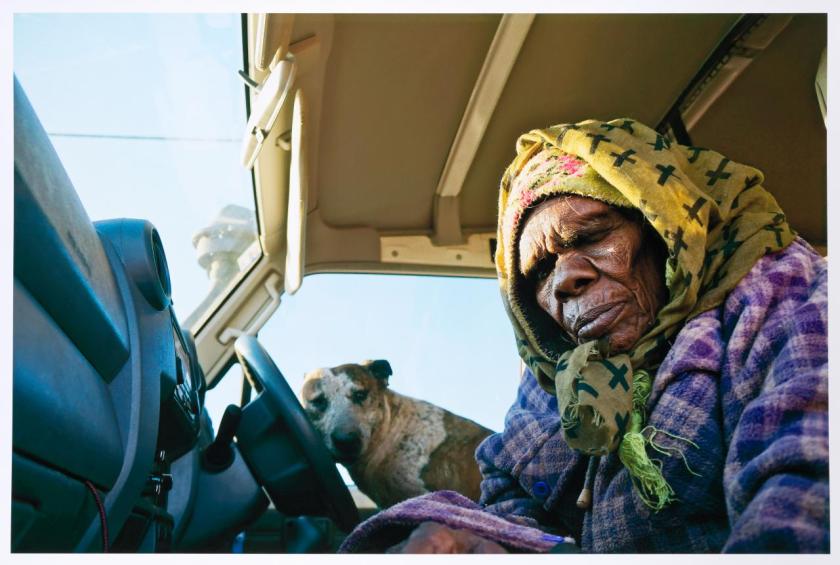
Karla Dickens (Australian / Wiradjuri, b. 1967)
Mrs Woods and ‘Ere
2013
Inkjet print on paper, ed. 3/10
Image: 66.0 x 100.cm
Sheet: 76.5 x 110.0 cm
National Portrait Gallery, Canberra
Purchased 2019
© Karla Dickens/Copyright Agency, 2022
Tjayanka Woods (c. 1935-2014) was a senior Pitjantjatjara artist, born near Kalaya Pirti (Emu Water) near Mimili and Wataru, South Australia. She was a cultural custodian, leader and held significant knowledges regarding cultural law and medicine. As an artist, Woods often referred to the Kungkarrangkalpa Tjurkurpa (Seven Sisters) within her artworks. The Kungkarrangkalpa Tjurkurpa is an epic and ancient creation story revolving around the start cluster, also known as Pleiades. In 2013, Wiradjuri artist Karla Dickens, spent several weeks with Woods and other senior Pitjantjatjara artists research the creation story. During her time in Pitjantjatjara Country, Dickens photographed Woods as the aware and intelligent cultural leader she was, with dignity and strength.
Wall text from the exhibition
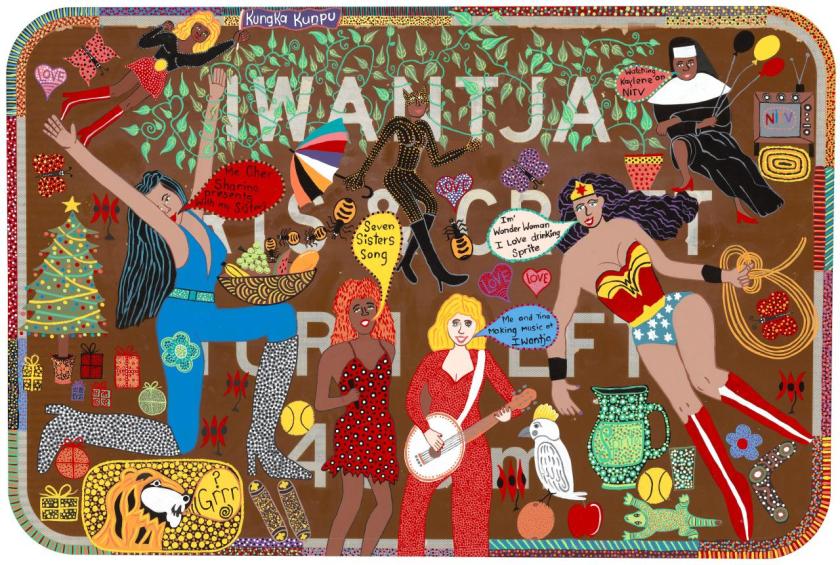
Kaylene Whiskey (Australian / Anangu Pitjantjatjara Yankunytjatjara, b. 1976)
Seven Sisters Song
2021
Enamel paint on road sign
120.0 x 180.0cm irreg.
National Gallery of Victoria, Melbourne
Purchased, Victorian Foundation for Living Australian Artists, 2021
© Kaylene Whiskey. Courtesy of the artist, Iwantja Arts and Roslyn Oxley9 Gallery, Sydney
Kaylene Whiskey seamlessly combines references to daily life in Indulkana with popular culture. Painted on an old road sign, Seven Sisters Song celebrates Whiskey’s witty sense of humour and personal reflection of Kungkarangkalpa Tjukurpa, the Seven Sisters creation story. Imbued within the work themes of sisterhood and kinship bonds, Whiskey brings together two vastly different worlds. Strong female characters including Wonder Woman, Whoopi Goldberg and Dolly Parton are situated within a desert landscape and seen interacting with native plants and wildlife, including traditional Anangu activities like hunting, collecting bush tucker, and cultivating mingkulpa (a native tobacco plant).
Wall text from the exhibition

Johannes Heyer (Australian, 1872-1945)
William Barak at work on the drawing ‘Ceremony’ at Coranderrk
1902
Gelatin silver photograph, sepia toned on paper
8.7 x 8.7cm
National Portrait Gallery, Canberra
Purchased with the assistance of the Australian Decorative and Fine Arts Society 2000
Wurundjeri artist and ngurungaeta (Head Man) William Barak was an important cultural leader, diplomat and activist. Barak lived near Coranderrk Aboriginal Station, near Healesville, from 1863 until 1903, becoming an influential spokesman for the rights of his people and an informant on Wurundjeri cultural lore. The people of Coranderrk, however, were officially forbidden from observing traditional practices, so Barak began recording them in drawings, often using ochre and charcoals to depict ceremonies and aspects of Wurundjeri culture before colonisation. His artworks are significant expressions of cultural practice, and he is regarded as an important figure int he history of Indigenous Australian art.
Wall text from the exhibition
Beruk (William Barak) (1824-1903), an elder of the Wurundjeri clan of the Woi-worung, was the most famous Aboriginal person in Victoria in the 1890s. After attending the Reverend George Langhorne’s mission school, Barak joined the Native Police in 1844 and remained there until at least 1851. From 1863 until his death he lived at the government reserve at Coranderrk, at a site near the Yarra River in Victoria. The history of the reserve is one of official interference and mismanagement, and Barak played a significant part in representing the wishes of his community to the government. In the decade of the 1880s he made many paintings and artefacts, mostly of Aboriginal ceremonial subjects.
Beruk (1824-1903), artist, activist, leader and educator, was a Wurundjeri man of the Woiwurrung people, one of the five Kulin Nations whose Country encompasses Narrm (Melbourne). It is said that Beruk was present at the signing of the so-called treaty with which John Batman reckoned he’d acquired 240,000 hectares of Wurundjeri land in 1835. In reality, the men with whom Batman negotiated, including one of Beruk’s uncles, had not transferred ownership, but merely given Batman permission to stay temporarily. Beruk was given the name William Barak (a European mispronunciation) in 1844 when he joined the Native Police. He was among the group of people from across Victoria who were the first to join the settlement at Coranderrk, near Healesville, established by the Aboriginal Protection Board in 1863 following several years of petitioning by community leaders. Beruk emerged as a leader at Coranderrk, which developed into a self-sufficient agricultural settlement. Following the passing of his cousin Simon Wonga in 1874, Beruk became Ngurungaeta (head man) of the Wurundjeri people. During the same period, when European pastoral interests started lobbying for Coranderrk to be broken up and sold off, Beruk led the campaign to prevent the settlement’s closure. It was gazetted as a ‘permanent reservation’ in 1881.
By this time, Beruk was recognised as a leader of his people and as a revered custodian of language and cultural knowledge. As the people at Coranderrk were officially forbidden from observing their traditional ceremonies, including corroborees, Beruk began recording his knowledge in drawings, utilising introduced methods and materials including paper, cardboard, and watercolour to preserve and communicate important stories and aspects of culture and spirituality. On the one hand, his drawings and the artefacts he made functioned as a commodity and were sold as souvenirs to increasing numbers of tourists. Museums in Europe began acquiring examples of his work in the late nineteenth century. On the other hand, and more significantly, Beruk’s drawings represent a profound assertion of pride in his heritage and identity, and the survival of a rich and complex culture in the face of concerted attempts to diminish it. As Wurundjeri elder and Beruk’s great-great niece Aunty Joy Wandin Murphy says: “We believe that what he wanted was for people to remember those ceremonies, so that if he painted them … then people would always know about the ceremonies on Coranderrk and of Wurundjeri people.”
This photograph of Beruk was taken by Johannes Heyer, a Presbyterian clergyman called to the parish of Yarra Glen and Healesville in 1900. The drawing that Beruk is shown working on in the photograph is now in the collection of the Art Gallery of South Australia, Adelaide.
Anonymous text. “William Barak at work on the drawing ‘Ceremony’ at Coranderrk,” on the National Portrait Gallery website Nd [Online] Cited 18/06/2022

David Moore (Australia 1927-2003)
Migrants arriving in Sydney
1966
Gelatin silver print
National Gallery of Victoria, Melbourne
Purchased, 1961
WHO ARE YOU: Australian Portraiture is the first exhibition to comprehensively bring together the rich portrait holdings of both the National Gallery of Victoria, Melbourne, and the National Portrait Gallery, Canberra. Revealing the artistic synergies and contrasts between the two institutions’ collections, this co-curated exhibition considers portraiture in Australia across time and media.
Through the examination of diverse and sometimes unconventional ways of representing likeness, WHO ARE YOU will question what actually constitutes portraiture – historically, today and into the future. Examples of some of the more abstract notions of portraits in the exhibition include John Nixon’s Self-portrait, (1990), and Boris Cipusev’s typographic portrait of Jeff from The Wiggles, titled Jeff the wiggle, 2009-2013. Polixeni Papapetrou’s Magma man, 2013, a photograph that merges sitter and landscape until the two are almost indecipherable, and Shirley Purdie’s multi-panelled evocation of biography and Country, Ngalim-Ngalimbooroo Ngagenybe, 2018, further challenge the conventions of the genre and touch upon the intimate connection between artist, sitter and land. NGV Collection highlights include new acquisitions: Kaylene Whiskey’s Seven Sisters Song, 2021 – a playful take on portraiture by a living artist and Joy Hester’s Pauline McCarthy,1945, a rare example of Hester producing a portrait in oil.
WHO ARE YOU is the largest exhibition of Australian portraiture ever mounted by either the NGV or NPG, and is the first time the two galleries have worked collaboratively on such a large-scale project.
Text from the NGV International website

Installation view of the exhibition WHO ARE YOU: Australian Portraiture at NGV Australia, Federation Square, Melbourne showing Lloyd Rees’ Portrait of some rocks (1948, below)
Photo: Marcus Bunyan
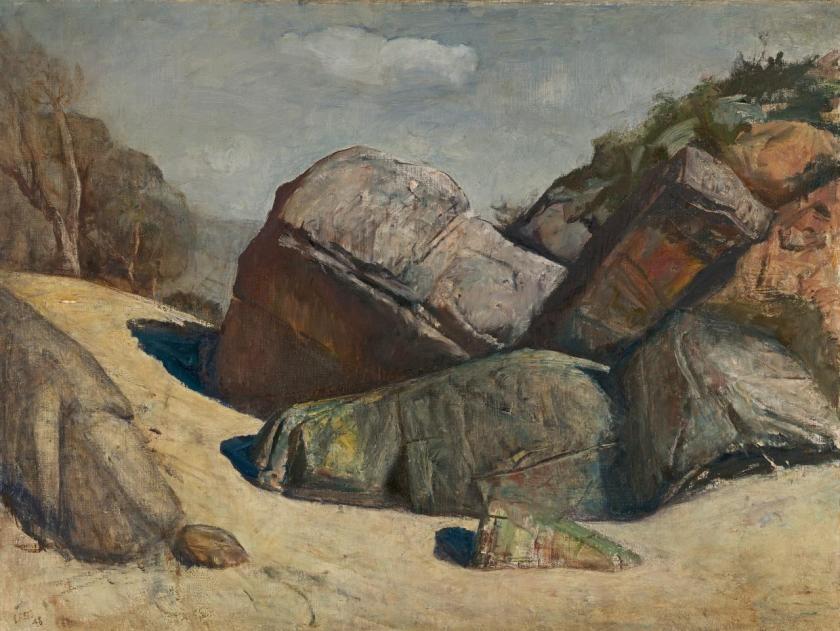
Lloyd Rees (Australian, 1895-1988)
Portrait of some rocks
1948
Oil on canvas
76.6 x 102.0cm
National Gallery of Victoria, Melbourne
Purchased, 1948
© Lloyd Rees/Licensed by Copyright Agency, Australia
One of Australia’s leading landscape artists of the mid-twentieth century, Lloyd Rees studied at Brisbane Technical College before moving to Sydney in 1917, where he worked as a commercial illustrator. In the early 1930s he concentrated solely on drawing, particularly the rocky landscapes around Sydney, but by the late 1930s he began painting in an increasingly romantic manner. Rocks were a meaningful subject for Rees because they evoked permanency and represented the constitution of the earth. Rees humanises his subject matter by using the word ‘portrait’ in the title, which suggests the rocks have shifted from inorganic to animate objects.
Wall text from the exhibition
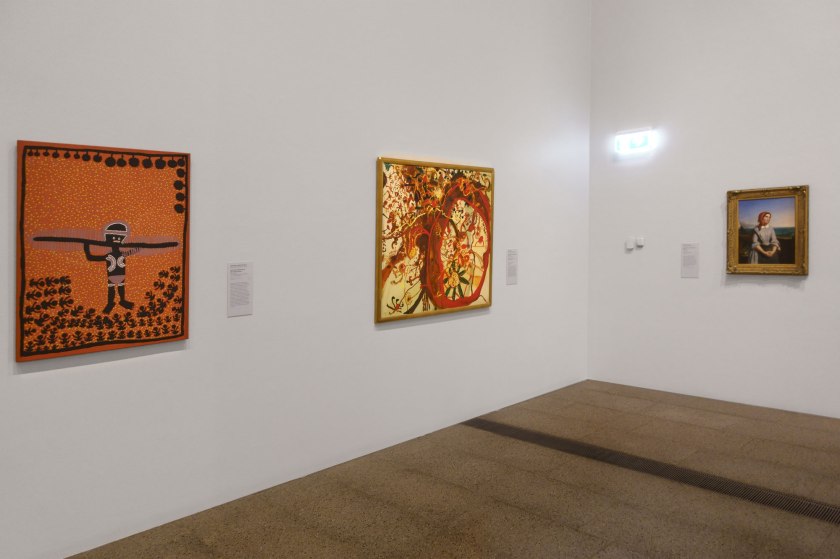
Installation view of the exhibition WHO ARE YOU: Australian Portraiture at NGV Australia, Federation Square, Melbourne showing at right, Marshall Claxton’s An emigrant’s thoughts of home (1859, below)
Photo: Marcus Bunyan
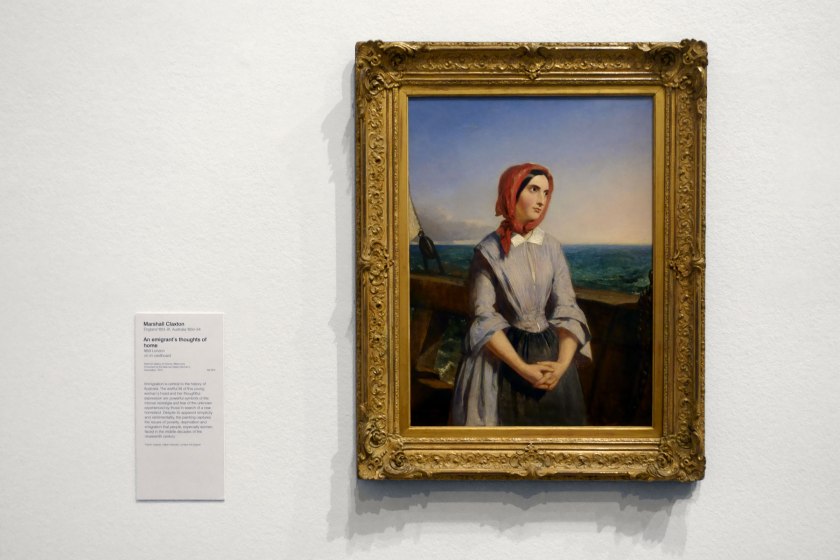
Installation view of the exhibition WHO ARE YOU: Australian Portraiture at NGV Australia, Federation Square, Melbourne showing at right, Marshall Claxton’s An emigrant’s thoughts of home (1859, below)
Photo: Marcus Bunyan

Marshall Claxton (English, 1813-1881, worked in Australia 1850-1854)
An emigrant’s thoughts of home
1859
Oil on cardboard
60.7 × 47.0cm
National Gallery of Victoria, Melbourne
Presented by the National Gallery Women’s Association, 1974
Immigration underlies the European history of Australia. Between 1815 and 1840, more than 58,000 people, predominately from the British Isles, came to Australia in search of a better life. Women migrants were also assisted to curb a gender imbalance in the colonies, to work as domestic servants and to foster marriages and childbirth.
Text from the National Gallery of Victoria website
Immigration is central to the history of Australia. The wistful tilt of this young woman’s head and her thoughtful expression are powerful symbols of the intense nostalgia and fear of the unknown experienced by those in search of a new homeland. Despite its apparent simplicity and sentimentality, the painting captures the issues of poverty, deprivation and emigration that people, especially women, faced in the middle decades of the nineteenth century.
Wall text from the exhibition

Peter Drew (Australian, b. 1983)
Monga Khan 1916
2016, printed 2019
From the Aussie series 2016
Brush and ink on screenprint
Image: 114.5 x 80.5cm
Sheet: 117.5 x 83.5cm
National Gallery of Victoria, Melbourne
Purchased, NGV Supporters of Prints and Drawings, 2020
© Peter Drew
Monga Khan was a hawker, and one of the thousands of people who applied for an exemption to the White Australia Policy, a law which came into effect in 1901. Exemptions were considered for cameleers, hawkers and other traders who were considered essential workers. Drew created this poster and others in the Aussie series using photographs from the National Archives of Australia, and pasted them around Australia’s cities.
He explains: ‘When you address the public through the street you’re entering into a tradition that emphasises our fundamental freedom of expression, over the value of property. I enjoy examining our collective identities and my aim is always to emphasise the connections that bind us, rather than the fractures that divide us’.
Wall text from the exhibition
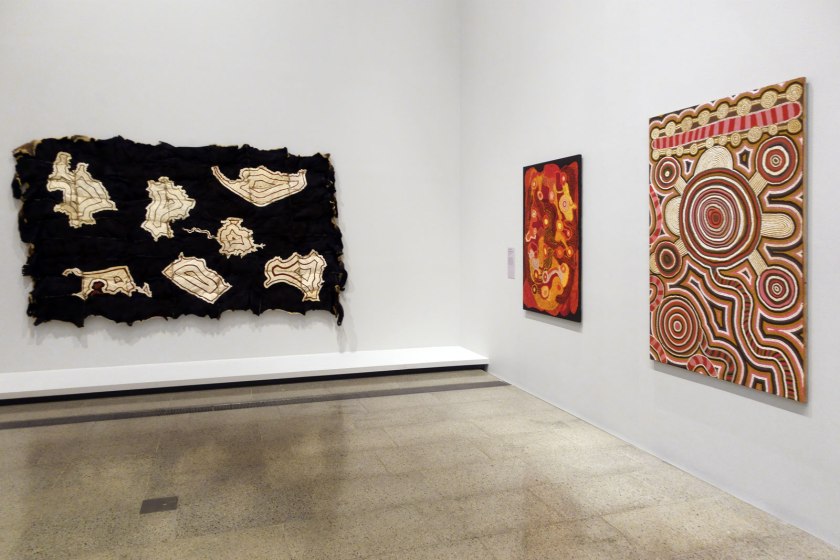
Installation view of the exhibition WHO ARE YOU: Australian Portraiture at NGV Australia, Federation Square, Melbourne showing at left, Maree Clarke’s Walert – gum barerarerungar (2020-2021, below); and at right, Uta Uta Tjangala’s Ngurrapalangu (1989, below)
Photo: Marcus Bunyan

Uta Uta Tjangala (Australian / Puntupi, c. 1926-1990)
Ngurrapalangu (installation view)
1989
Synthetic polymer paint on canvas
National Gallery of Victoria, Melbourne
Presented through the NGV Foundation by Elizabeth and Colin Laverty, Governors, 2001
Photo: Marcus Bunyan
Uta Uta Tjangala forged a new art form at Papunya during 1971-1972 with startling works such as this one. Working for the first time on a discarded scrap of composition board, artists at Papunya rendered visible and permanent ephemeral designs, formerly made only for use in closed and secret ceremonial contexts on bodies, objects or the ground. The painted designs are closely connected to the artist’s cultural identity, his understanding of Country, and of sacred men’s business, unknowable to uninitiated members of the community.
Wall text from the exhibition
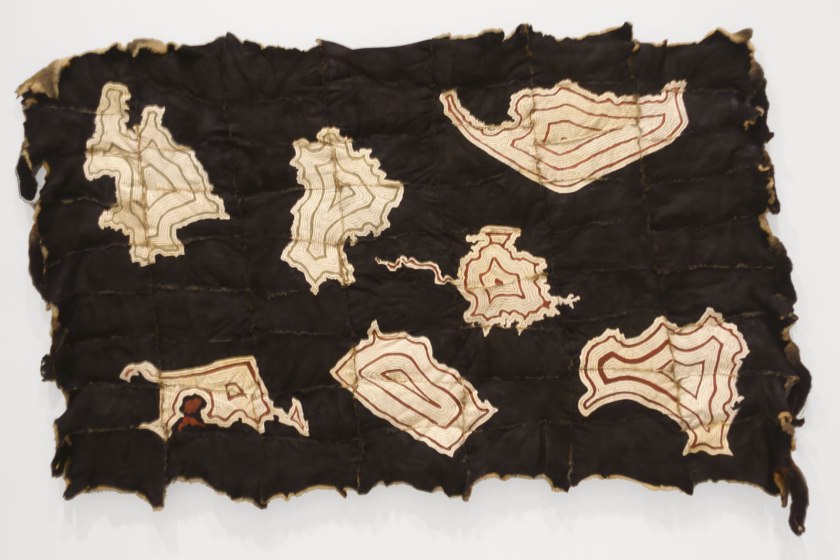
Maree Clarke (Australian / Mutti Mutti/Wamba Wamba/Yorta Yorta/Boonwurrung, b. 1961)
Walert – gum barerarerungar: Tipperary, Ireland Dunstable, Britain Yorta Yorta Trawlwoolway Boonwurrung, Muttu Mutti, Wamba Wamba (installation view)
2020-2021
Possum pelts
National Gallery of Victoria, Melbourne
Purchase, Victorian Foundation for Living Australian Artists, 2021
Photo: Marcus Bunyan
Maree Clarke is recognised as one of the most respected possum skin cloak makers and teachers in the world. This work represents the first time Clarke produced a cloak to represent her own ancestral identity. Depicted on the cloak are seven important places, which her ancestors come from: Yorta Yorta Country, Trawlwoolway Country, Boonwurrung Country, Muttu Mutti Country and Wamba Wamba Country, as well as Tiperrary in Ideland, and Dunstable in Britain. Clarke has used a rare green ochre to represent her European ancestors. Together, these seven ancestral sites of significance inform Clarke’s identity.
Wall text from the exhibition

Maree Clarke (Australian / Mutti Mutti/Wamba Wamba/Yorta Yorta/Boonwurrung, b. 1961)
Walert – gum barerarerungar: Tipperary, Ireland Dunstable, Britain Yorta Yorta Trawlwoolway Boonwurrung, Muttu Mutti, Wamba Wamba (installation view detail)
2020-2021
Possum pelts
National Gallery of Victoria, Melbourne
Purchase, Victorian Foundation for Living Australian Artists, 2021
Photo: Marcus Bunyan
Portraiture
In its uniting of artist and sitter, the self-portrait is an intriguing facet of portraiture. The self-reflection is a format that appears to grant the viewer the assurance of revelation and intimate access to the artist’s psyche. However, what the artist intends to communicate to their audience through portraiture is highly varied, and the message each artist conveys is as individual as the artist themselves. Additionally, there is room for the viewer to question how the artist has chosen to depict their image.
Self-portraiture is a diverse genre: there are myriad ways an artist can present themselves. A typical way for the artist to portray themselves is in the role of ‘the artist’, including in the work a visual clue to their profession – for instance holding a brush or paint palette – or showing themselves at work in the studio. As part of an investigation of self, these representations can also communicate the complexities of status and gender. This selection of works explores what the artists intend to reveal or exclude about themselves through their self-representations, considering he environment in which the artists are placed, and the props and imagery they choose to include in the works.
Wall text from the exhibition

Pamela See (Australian, b. 1979)
Making Chinese Shadows (sixteen silhouette portraits) (installation view)
2018
Twelve of sixteen papercut silhouette drawings
National Portrait Gallery, Canberra
Purchased 2019
Photo: Marcus Bunyan
Brisbane-born Pamela See (Xue Mei-Ling) studied at the Queensland College of Art from 1997 to 1999. She began papercutting during a period when she was without access to a studio, and was subsequently awarded grants that enabled her to study the technique in several centres throughout China. Her method and style resemble Foshan papercutting, which is widely practices in the home of her maternal grandparents, in Guangdong province. These papercuts are from a series investigating the lives of Chinese-Australians who flourished prior to the introduction of the White Australia policy. The works connect and juxtapose European silhouette portraiture and Chinese papercutting traditions, exploring the notion that a silhouette profile provides a means of ‘measuring’ a sitter’s character with the totemic and floral symbols evoking personal narratives, identity and professions.
Wall text from the exhibition

Pamela See (Australian, b. 1979)
Making Chinese Shadows (sixteen silhouette portraits) (installation view detail)
2018
Twelve of sixteen papercut silhouette drawings
National Portrait Gallery, Canberra
Purchased 2019
Photo: Marcus Bunyan
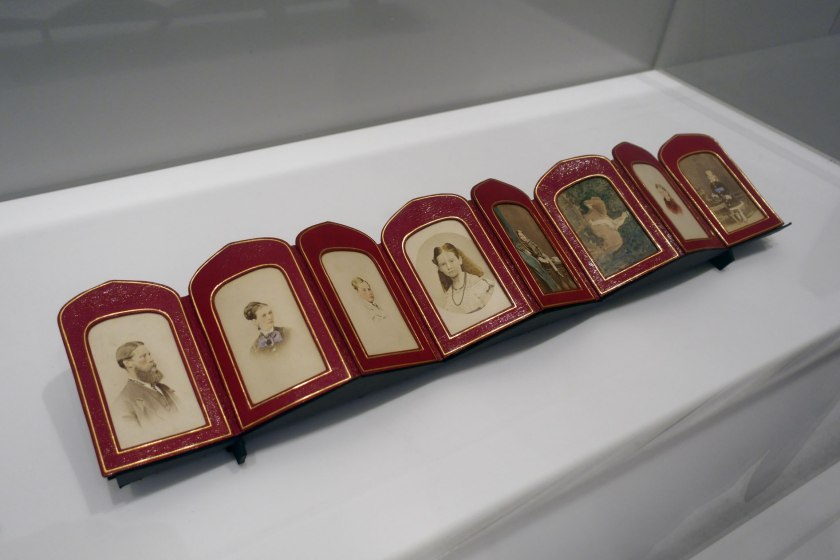
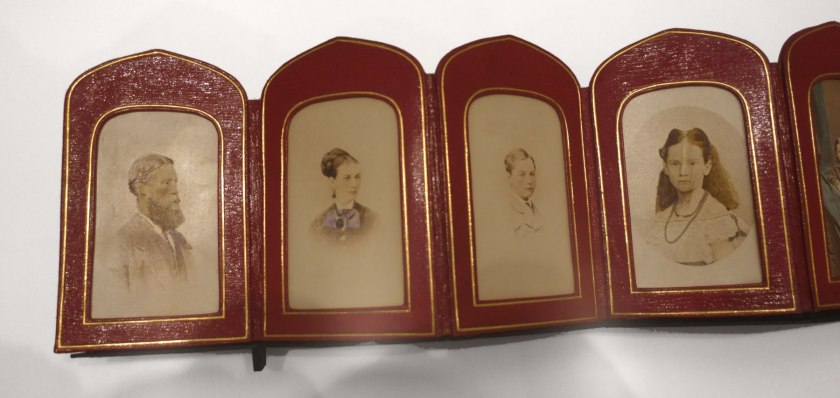
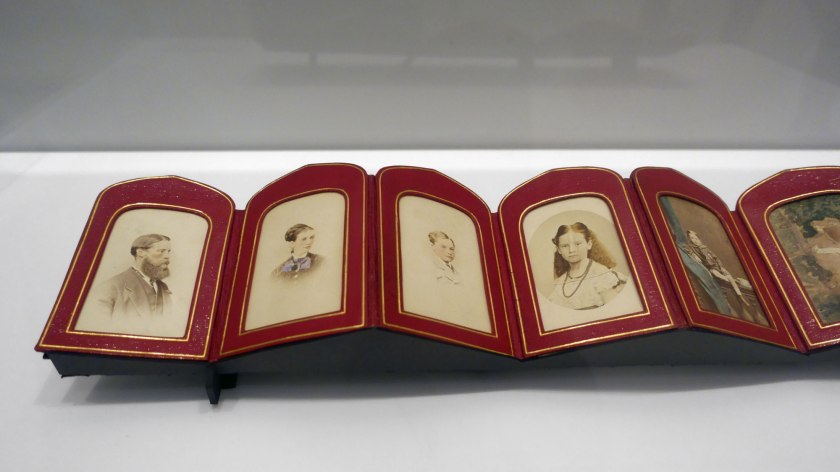
Various unknown photographers (Australian)
William and Martha Mary Robertson and their children (installation views)
1860s-1870s
Eight cartes de visite, hand-coloured, contained in red leather presentation case
National Portrait Gallery, Canberra
Gift of Malcolm Robertson in memory of William Thomas Robertson 2018
Donated through the Australian Government’s Cultural Gifts Program
Photos: Marcus Bunyan

LIU Xiao Xian (Australian born China, b. 1963)
My other lives, #7
2000
From the My other lives series 2000
Type C photograph
102.0 × 145.2cm irreg.
National Gallery of Victoria, Melbourne
Purchased with funds arranged by Loti Smorgon for Contemporary Australian Photography, 2002
© LIU Xiao Xian
Popular in nineteenth-century Australia, stereographs gave the illusion of three dimensions when placed in a handheld viewer. In this work, Liu Xiao Xian enlarges a typical example of this historical form of photographic portraiture and replaces the sitter’s face with his own on one side. Through this double-take, and the playful invitation to imagine an ‘other life’ for this sitter, this work is both a subtle self-portrait and a pointed reminder of the invisibility of the Chinese migrant experience in mainstream conceptions of Australian history and identity.
Wall text from the exhibition

A. D. Colquhoun (Australian, 1894-1983)
Artist and sitter (installation view)
c. 1938
Oil on canvas
122.0 × 94.0cm
National Gallery of Victoria, Melbourne
Felton Bequest, 1940
© Dr Quentin Noel Porter
Photo: Marcus Bunyan

A. D. Colquhoun (Australian, 1894-1983)
Artist and sitter
c. 1938
Oil on canvas
122.0 × 94.0cm
National Gallery of Victoria, Melbourne
Felton Bequest, 1940
© Dr Quentin Noel Porter
Brush in hand, there is no mistaking A. D. Colquhoun’s occupation or the studio setting. The young, glamorous model is an essential part of this carefully orchestrated self-portrayal. By also including his painting of the model on the easel, Colquhoun presents himself in the company of not one, but two women whose presence asserts his own dominant masculinity. The artist’s gaze meets the viewer, placing them as the subject of the painter’s attention, creating a complex network of visual relationships between the artist, model and viewer.
Wall text from the exhibition
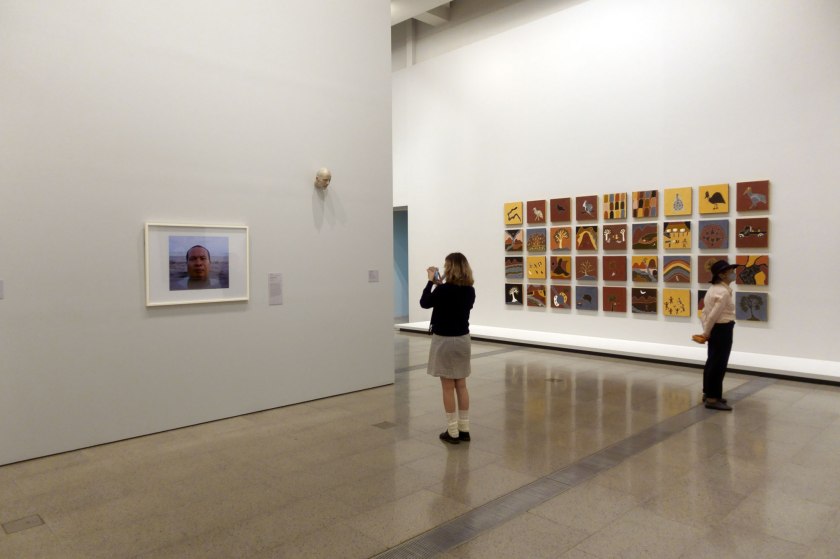
Installation view of the exhibition WHO ARE YOU: Australian Portraiture at NGV Australia, Federation Square, Melbourne showing at right, Shirley Purdie’s Ngalim-Ngalimbooroo Ngagenybe (2018, below)
Photo: Marcus Bunyan
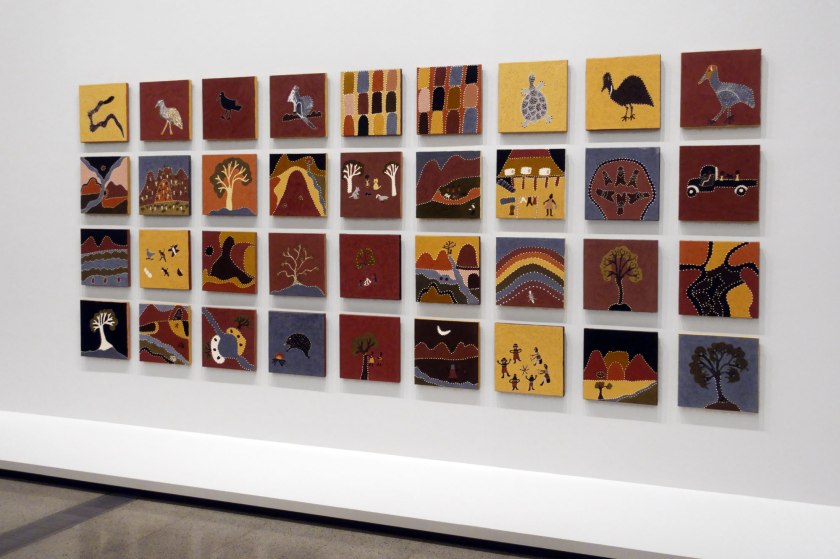
Shirley Purdie (Australian / Gija, b. 1947)
Ngalim-Ngalimbooroo Ngagenybe (installation view)
2018
Natural ochre and pigments on canvas (36 parts)
Each: 45 x 45cm
Overall: 225 x 525cm
National Portrait Gallery, Canberra
Purchased 2019
© Shirley Purdie/Copyright Agency, 2022
Photo: Marcus Bunyan
Shirley Purdie (b. 1947) is a senior Gija artist at the Warmun Art Centre who has been painting for more than twenty years. Purdie has lived on her Country, Western Australia’s East Kimberley, all her life. Inspired by senior Warmun artists, including her late mother, Madigan Thomas, she began to paint sites and narratives associated with her Country in the early 1990s. A prominent leader in the Warmun community, her cultural knowledge and artistic skill allow her to pass on Gija stories and language to the younger generations.
In 2018, Purdie was selected to contribute to the National Portrait Gallery’s 20th anniversary exhibition, So Fine: Contemporary Women Artists Make Australian History. Composed of 36 paintings, Purdie’s self-portrait Ngalim-Ngalimbooroo Ngaginbe is an eloquent and stunning visualisation of personal history, identity and connection to Country. ‘It’s good to learn from old people. They keep saying when you paint you can remember that Country, just like to take a photo … When the old people die, young people can read the stories from the paintings. They can learn from the paintings and maybe they want to start painting too.’ Using richly textured ochres collected on her Country, Purdie’s work is a kaleidoscope of traditional Gija stories and Ngarranggarni passed down to her.
Text from the National Portrait Gallery website
Shirley Purdie is senior Gija woman and a prominent leader within the Warmup Community in Western Australia’s East Kimberley. Combining her cultural knowledge with her art, Purdie creates visual depictions of Gija life and culture. Ngalim-Ngalimbooroo Ngagenybe, meaning ‘from my women’, is informed by Aboriginal ways of seeing, knowing and understanding oneself within the world. Each of the thirty-six panels shares a story about personal history, identity and Country to produce a non-representational self-portrait of the artist and her ongoing connection to women’s stories. By drawing on the significant women in her life, their relationships and histories, Purdie describes herself through these cultural connections and stories.
Wall text from the exhibition

Installation view of the exhibition WHO ARE YOU: Australian Portraiture at NGV Australia, Federation Square, Melbourne showing Sam Jink’s Divide (Self portrait) (2011, below)
Photo: Marcus Bunyan


Sam Jinks (Australian, b. 1973)
Divide (Self portrait) (installation views)
2011
Silicone, resin, horse hair
National Portrait Gallery, Canberra
Purchased 2015
© Sam Jinks
Photos: Marcus Bunyan
Sam Jinks developed a talent for drawing and constructing his ideas alongside his father, a Melbourne cabinetmaker. Jinks worked as an illustrator before turning to sculpture. He worked in film and television special effects before becoming a fabricator for artist Patricia Piccinini. For the last ten years he has sculpted independently, working in silicone, fibreglass, resin and hair – human, animal and synthetic.
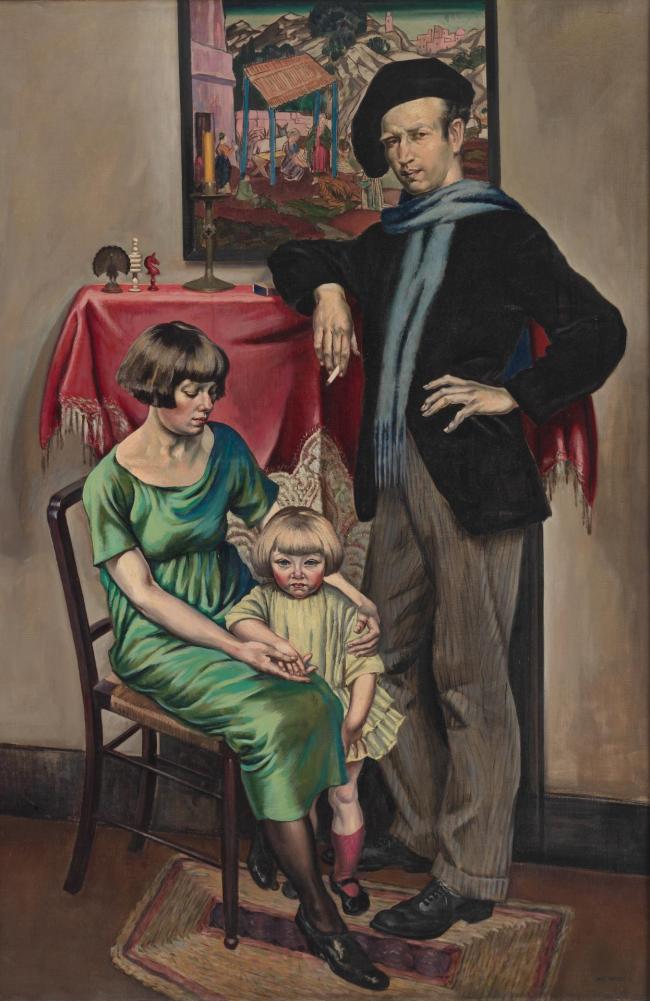
Max Martin (Australian, 1889-1965)
Portrait group
1922
Oil on canvas
152.8 x 102.2cm
National Gallery of Victoria, Melbourne
Purchased through The Art Foundation of Victoria with the assistance of Dr Joseph Brown AO OBE, Honorary Life Benefactor, 1995
© Veronica Martin

Max Martin (Australian, 1889-1965)
Portrait group (installation view detail)
1922
Oil on canvas
152.8 x 102.2cm
National Gallery of Victoria, Melbourne
Purchased through The Art Foundation of Victoria with the assistance of Dr Joseph Brown AO OBE, Honorary Life Benefactor, 1995
© Veronica Martin
Photo: Marcus Bunyan
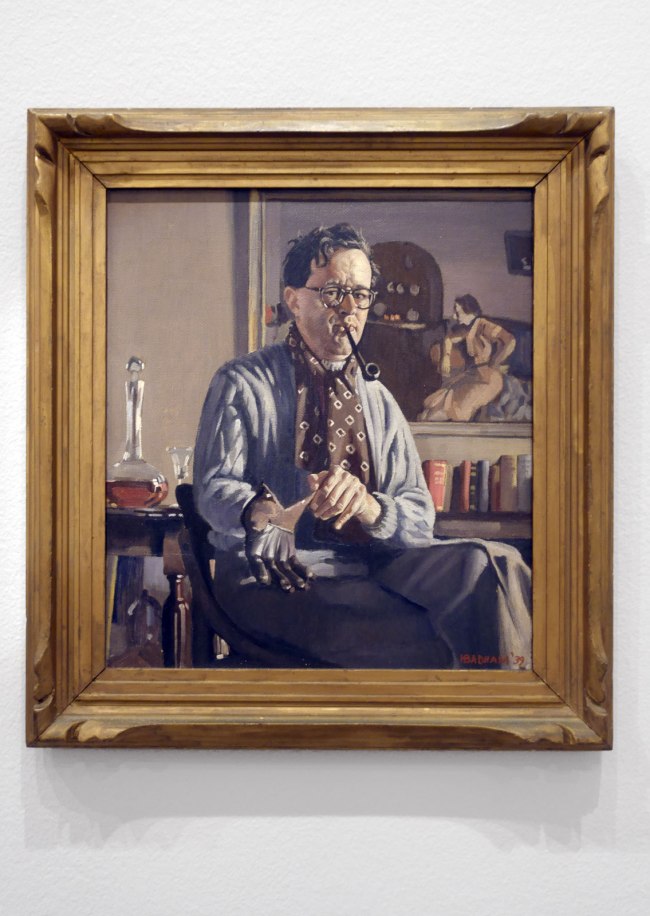
Herbert Badham (Australian, 1899-1961)
Self portrait with glove (installation view)
1939
Oil on canvas board
Frame: 44.4 x 40.7cm
National Portrait Gallery, Canberra
Purchased 1999
© Estate of Herbert Badham
Photo: Marcus Bunyan
Herbert Badham was an artist, writer and teacher who specialised in figures, urban life and beach scenes. Having studied for many years at the Julian Ashton School in the 1920s and 1930s, he produced a body of painting that typified the gentle, realist aspect of Sydney modernism of the prewar years. Head of the intermediate art department at East Sydney Tech from 1938 to 1961, he published the populist Study of Australian Art in 1949, and A Gallery of Australian Art in 1954. Badham’s work underwent a minor revival in the late 1980s, with a retrospective show held in Wollongong and Sydney, and three of his urban scenes were selected for the National Gallery’s Federation exhibition of 2001. Arguably the most interesting of several self-portraits of the artist, this painting was featured on the cover of the catalogue of the 1987 retrospective.
Text from the National Portrait Gallery website

Herbert Badham (Australian, 1899-1961)
Self portrait with glove
1939
Oil on canvas board
Frame: 44.4 x 40.7cm
National Portrait Gallery, Canberra
Purchased 1999
© Estate of Herbert Badham
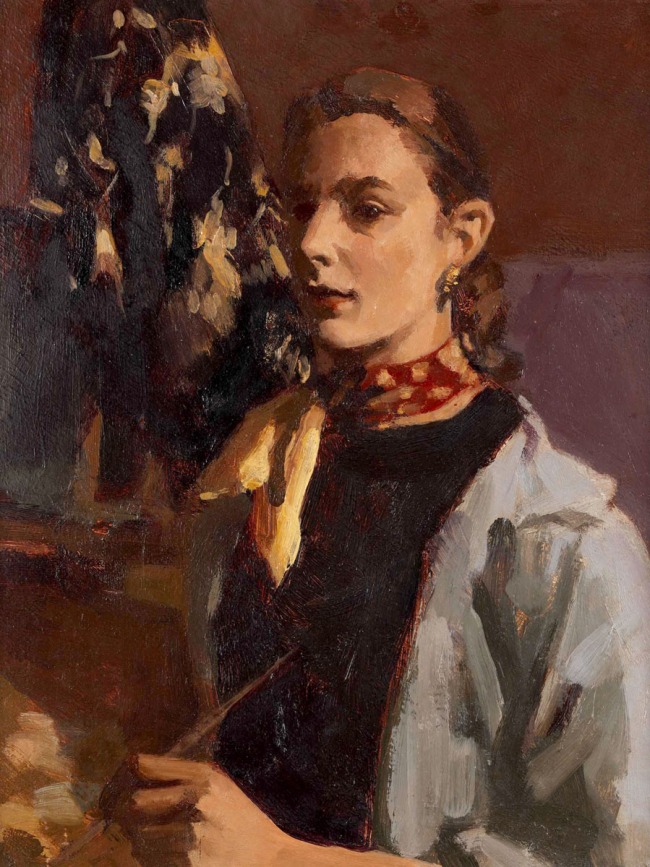
Janet Dawson (Australian, b. 1935)
Self Portrait
Between 1951 and 1953
oil on cardboard
Frame: 57.0 x 47.5cm
National Portrait Gallery, Canberra
Gift of the artist 2000
© Janet Dawson/Copyright Agency, 2022
Janet Dawson (b. 1935) is best known for her contribution to abstract art in Australia. Following her family’s relocation from Forbes to Melbourne in the early 1940s, Dawson attended the private art school run by Harold Septimus Power. In 1951, aged sixteen, she enrolled at the National Gallery School and attended night classes with Sir William Dargie. Five years later, Dawson won a National Gallery of Victoria Travelling Scholarship and went to London, where she studied at the Slade School and the Central School. Returning to Melbourne in 1961, she held her first solo exhibition the same year and in 1963 set up an art school and workshop. Dawson was one of only three women included in the influential exhibition of Australian abstraction, The Field, at the National Gallery of Victoria in 1968. Her work is represented in all major public collections in Australia, and has been the subject of exhibitions at the NGV and the National Gallery of Australia.
Outside of her lyrical abstract work, Dawson always practised portraiture and won the Archibald Prize in 1973 with a portrait of her husband, the late writer, actor and playwright Michael Boddy. Painted during an evening class at the National Gallery School, this self portrait shows Dawson wearing an artist’s work shirt over her elegant day clothes, gazing confidently at the viewer.
Text from the National Portrait Gallery website

Installation view of the exhibition WHO ARE YOU: Australian Portraiture at NGV Australia, Federation Square, Melbourne showing at left, Lina Bryans’ The babe is wise (1940, below); at middle, Janet Cumbrae Stewart’s Portrait of Jessie C. A. Traill (1920, below); and at right, Evelyn Chapman’s Self portrait (1911, below)
Photo: Marcus Bunyan

Lina Bryans (Australian born Germany, 1909-2000)
The babe is wise (installation view)
1940
Oil on cardboard
National Gallery of Victoria, Melbourne
Gift of Miss Jean Campbell, 1962
Photo: Marcus Bunyan
Lina Bryans was an important part of the modern movement and a member of literary and artistic circles in Melbourne during the late 1930s and 1940s. Her vibrant paintings are characterised by bold brushwork and the expressive use of colour. In 1937, Bryans began painting portraits of her friends. Her most famous work, The babe is wise, is a portrait of the writer Jean Campbell, who had recently published a novel of the same name.
Wall text from the exhibition

Lina Bryans (Australian born Germany, 1909-2000)
The babe is wise
1940
Oil on cardboard
National Gallery of Victoria, Melbourne
Gift of Miss Jean Campbell, 1962

Janet Cumbrae Stewart (Australian, 1883-1960)
Portrait of Jessie C. A. Traill
1920
Pastel
Image and sheet: 55.5 × 45.4cm irreg.
National Gallery of Victoria, Melbourne
Gift of Jessie Traill, 1961
© Courtesy of the copyright holder
Chiefly known for her use of pastel, Janet Cumbrae Stewart devoted the most significant part of her career to producing sensuous studies of the female nude and portraits of women. Her portrait of fellow artist Jessie Traill shows Traill in the dress uniform of a Queen Alexandra Imperial Nurse. Nursing was one of the few options open to women wanting to serve in the First World War. Traill, who was living in France, volunteered and was stationed in Rouen in Northern France for three and a half years. Cumbrae Stewart and Traill were friends, both having grown up in Brighton, Victoria, and attended the National Gallery School alongside one another in the early 1900s.
Wall text from the exhibition

Evelyn Chapman (Australian, 1888-1961)
Self portrait (installation view)
1911
Oil on canvas
National Portrait Gallery, Canberra
Gift of Pamela Thalben-Ball 2007
© Estate of Evelyn Chapman
Photo: Marcus Bunyan

Evelyn Chapman (Australian, 1888-1961)
Self portrait
1911
Oil on canvas
National Portrait Gallery, Canberra
Gift of Pamela Thalben-Ball 2007
© Estate of Evelyn Chapman
Evelyn Chapman, artist, studied with Antonio Dattilo Rubbo in Sydney and travelled overseas to paint in Paris, where she exhibited at the Salon. A few weeks after the end of World War 1 she took up the opportunity to visit the battlefields of France with her father, who was attached to the New Zealand War Graves Commission. Thus, she became the first Australian female artist to depict the devastated battlefields, towns and churches of the western front. Chapman remained overseas with her father, an organist who played in Dieppe, Venice and elsewhere, and married a brilliant organist, George Thalben-Ball, herself. After she married, she gave up painting, but she encouraged her daughter, Pamela, to pursue art. For the rest of her life, Chapman lived in England, only returning to Australia for a visit in 1960. The Art Gallery of New South Wales has her 1911 portrait of Dattilo Rubbo and a number of her paintings of France, Belgium and England. The Australian War Memorial, too, has several of her evocative French scenes.
Text from the National Portrait Gallery website
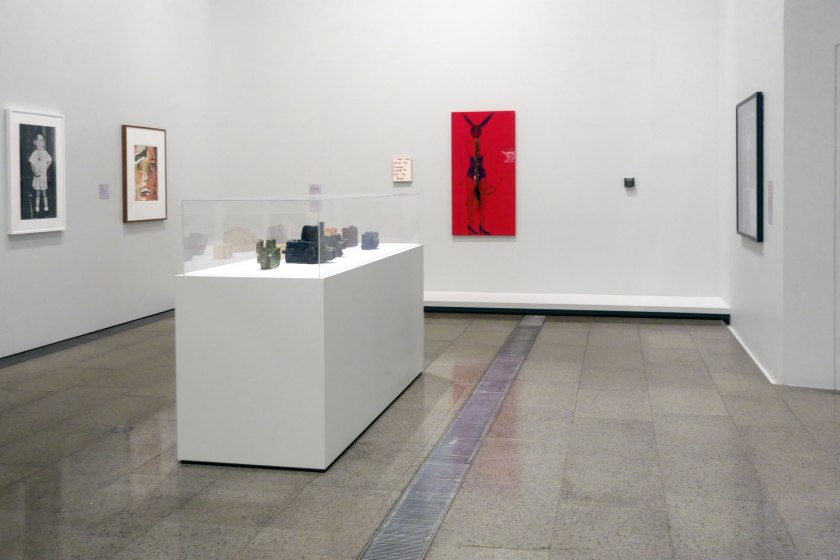
Installation view of the exhibition WHO ARE YOU: Australian Portraiture at NGV Australia, Federation Square, Melbourne showing at left, William Yang’s Self Portrait #2 (2007, below); and at centre in case, Alan Constable’s earthenware cameras (see below)
Photo: Marcus Bunyan

William Yang (Australian, b. 1943)
Self Portrait #2
2007
From the Self Portrait series
Inkjet print
Sheet: 84 x 50cm
National Gallery of Victoria, Melbourne
Purchased with funds donated by Ms Cora Trevarthen and Professor Andrew Reeves, 2013
© William Yang
William Yang shares childhood memories in this self-portrait. He recently reflected: ‘… I cal myself Australian, but I claim my Chinese heritage because that’s the way I look. Central to my art practice is my own story, which I tell in performances with projected images and music in theatres. My story is told against a backdrop of the times. This keys into my documentary-style photography. I have done a series of self-portraits of the same stories for exhibition in galleries. So my art and my life have become entwined and they both feed into each other. And I’ve come to terms with the way I look … It’s a great relief to feel comfortable in your own skin’.
Wall text from the exhibition
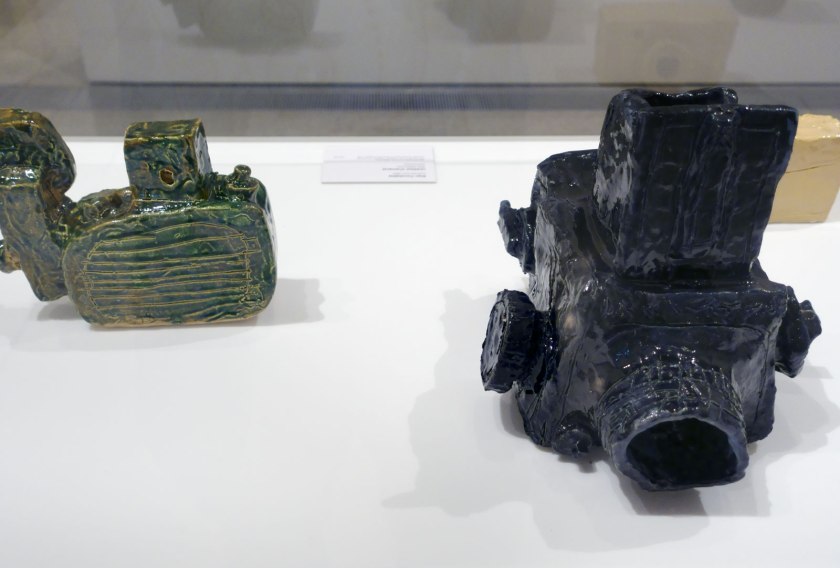
Installation view of the exhibition WHO ARE YOU: Australian Portraiture at NGV Australia, Federation Square, Melbourne showing at left, Alan Constable’s Green large format camera (2013, below); and at right Alan Constable’s Not titled (Black Mamiya large format camera) (2013, below)
Photo: Marcus Bunyan

Alan Constable (Australian, b. 1956)
Not titled (Green large format camera)
2013
Earthenware
16.5 × 24.0 × 9.0cm
National Gallery of Victoria, Melbourne
Yvonne Pettengell Bequest, 2014
© Courtesy of the artist and Arts Project Australia, Melbourne
Photo: Marcus Bunyan

Alan Constable (Australian, b. 1956)
Not titled (Black Mamiya large format camera)
2013
Earthenware
25.0 × 29.0 × 26.0cm
National Gallery of Victoria, Melbourne
Yvonne Pettengell Bequest, 2014
© Courtesy of the artist and Arts Project Australia, Melbourne
Photo: Marcus Bunyan
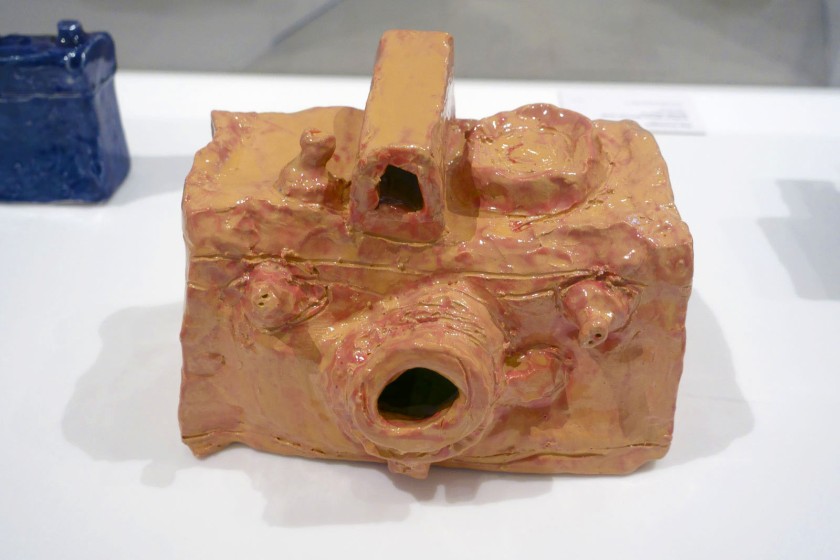
Alan Constable (Australian, b. 1956)
Not titled (Box Brownie)
2013
Earthenware
17.0 × 24.5 × 18.5cm
National Gallery of Victoria, Melbourne
Yvonne Pettengell Bequest, 2014
© Courtesy of the artist and Arts Project Australia, Melbourne
Photo: Marcus Bunyan
Alan Constable’s lifelong fascination with cameras began when he was just eight years old, as he sculpted the objects picture on cereal boxes. Legally blind, Constable’s sculptural practice sometimes extends to other optical objects, such as binoculars and video recorders. Constable’s method involves holding the camera millimetres from his eyes, as he scans and feels the object, before quickly rendering his impressions in clay. Constable has worked at Arts Project Australia since 1991 and held his first solo show in 2011. His works speak to the processes of seeing and looking, and self-reflexively capture the objects that capture the image.
Display case text from the exhibition

Christian Thompson (Australian / Bidjara, b. 1978)
Authoring the explorer, James Cook
2015, printed 2016
From the Museum of Others series 2015-2016
Type C photograph on metallic paper
National Gallery of Victoria, Melbourne
Gift of an anonymous donor through the Australian Government’s Cultural Gifts Program, 2017
‘Today, we are still conditioned by historical tropes such as the bust-style portraits of colonial men who had roles in furthering the position of colonial Britain at the height of the imperial pursuit for claiming new frontiers, at the expense of the Indigenous custodians of countries including Australia. However, as famous as these colonial figures still are, I try to demonstrate that it is never too late to pierce, subvert and re-stage the spectres of history to gain agency from the position of the other. Through the work, I am proposing: let us scrutinise your history, your identities, your flaws.’ ~ Christian Thompson, 2017
Wall text from the exhibition
WHO ARE YOU: Australian Portraiture is one of the most comprehensive explorations of portraiture ever mounted in Australia and the first exhibition to bring together the collections of the National Gallery of Victoria (NGV) and the National Portrait Gallery, Canberra. The exhibition will be on display in Melbourne from 25 March to 21 August 2022 and Canberra from 1 October 2022 to 29 January 2023.
Revealing the rich artistic synergies and contrasts between the two institutions’ collections, this co-curated exhibition considers portraiture in Australia across time and media, as well as the role of the portraiture genre in the development of a sense of Australian national identity.
Featuring more than two-hundred works by Australian artists including Patricia Piccinini, Atong Atem, Howard Arkley, Vincent Namatjira and Tracey Moffatt, and featuring sitters including Cate Blanchett, Albert Namatjira, Queen Elizabeth II, Eddie Mabo and David Gulpilil, the exhibition explores our inner worlds and outer selves, as well as issues of sociability, intimacy, isolation, celebrity and ordinariness.
The exhibition also questions what actually constitutes portraiture by examining the surprising and sometimes unconventional ways of representing likeness, such as the abstract self-portrait by John Nixon and Boris Cipusev’s typographic portrait of Jeff from The Wiggles. Polixeni Papapetrou’s Magma Man, a photograph which merges sitter and landscape until the two are almost indecipherable, and Shirley Purdie’s multi-panelled evocation of biography and Country further challenge the conventions of the genre and touch upon the intimate connection between artist, sitter and land. Alongside these works, iconic self-portraits will also be displayed by artists including John Brack, Nora Heysen and William Yang.
Tony Ellwood AM, Director, NGV, said: “This exhibition marks the first major partnership between the NGV and the National Portrait Gallery in Canberra. By combining our respective portraiture collections and curatorial expertise in this area, we have been able to stage the largest thematic portraiture exhibition in the history of either institution. This presentation will no doubt offer audiences an unprecedented insight into the genre and its place in Australian art history.”
Karen Quinlan AM, Director, National Portrait Gallery, said: “The NPG is thrilled to work with the NGV on this extensive exploration of Australian portraiture. The exhibition comes at a time when, in the current global COVID environment, stories from home, about home, and the artists and identities who have shaped and continue to shape our nation are more compelling and important than ever. It is a privilege to be able to present our collection in conversation with the NGV’s and to explore the idea of Australian identity and its many layers and facets through the lens of portraiture.”
Presented across five thematic sections, the exhibition raises challenging and provocative questions about who we are and how we view others – historically, today and into the future. The exhibition opens by considering the connection between people and place, reflecting on the relationship between artists, sitters and the environment, as well as the personification of the natural world. Highlight works include a conceptual map depicting self and Country by Wawiriya Burton, Ngayaku Ngura (My Country) 2009, as well as the NGV’s recent acquisition Seven Sisters Song 2021 by Kaylene Whiskey, a painted road sign that is filled with personally significant, autobiographical references to pop culture.
A further section explores the artistic tradition of the self-portrait and portraits of artists, as well as how this convention has been subverted or challenged by contemporary artists working today. Works include Hari Ho’s Dadang Christanto 2005, which depicts the artist buried to the neck in sand, referencing the brutal killings of Indonesians in the failed military coup of September 1965, and Alan Constable’s Not titled (Green large format camera) 2013, personifying the act of photography with a hand modelled, ceramic camera.
Ideas of intimacy and alienation are juxtaposed through images of family and community presented alongside those of vulnerability and isolation. Works include Pat Larter’s Marty 1995, a graphic collage depicting a male sex worker, challenging the ease with which society consumes images of female nudity, and Naomi Hobson’s Warrior without a weapon 2019, a photographic series in which the artist challenges stereotypes about Indigenous men from her home community in Coen, by using flowers as a metaphor for male vulnerability.
The exhibition also explores portraiture’s surprising capacity to reveal the inner worlds and mindsets of both the sitter and the artist, as exemplified by Eric Thake’s satirical vignettes of figures in dream-like settings, and Hoda Afshar’s Remain 2018, a video exploring Australia’s controversial border protection policy and the human rights of those seeking asylum.
The final section of the exhibition interrogates Australian icons, identities and how we construct them. Works featured in this section include Michael Riley’s Maria 1986 and Polly Borland’s HM Queen Elizabeth II 2002, two works displayed side by side, drawing connections between archetypal imagery of royalty, with negative renderings of ‘otherness’ found in historical ethnographic portraiture.
WHO ARE YOU: Australian Portraiture is presented by the NGV and the National Portrait Gallery and will be on display at The Ian Potter Centre: NGV Australia at Fed Square from 25 March to 21 August 2022 and the National Portrait Gallery, Canberra from 1 October 2022 to 29 January 2023.
WHO ARE YOU: Australian Portraiture is generously supported by Major Partner, Deakin University.
Press release from the National Gallery of Victoria International
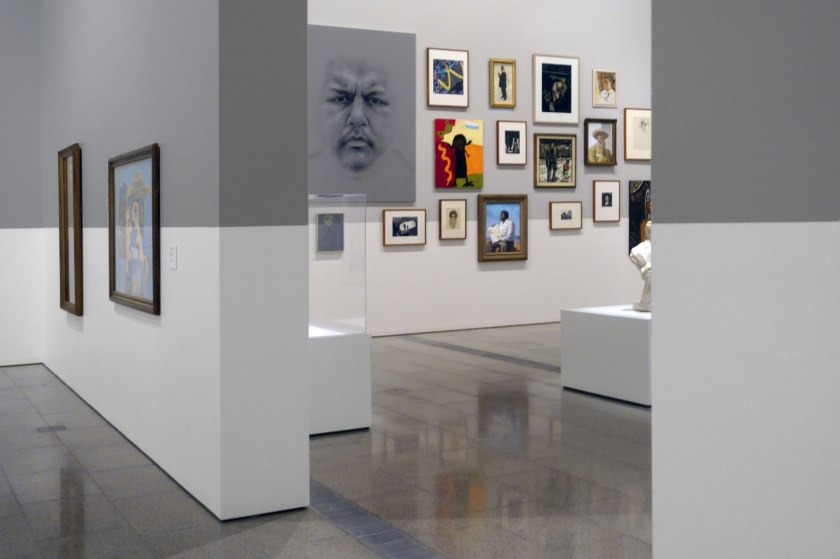
Installation view of the exhibition WHO ARE YOU: Australian Portraiture at NGV Australia, Federation Square, Melbourne showing at centre left, Bert Flugelman’s self portrait (1985, below). The legend of the artworks on the wall is below…
Photo: Marcus Bunyan
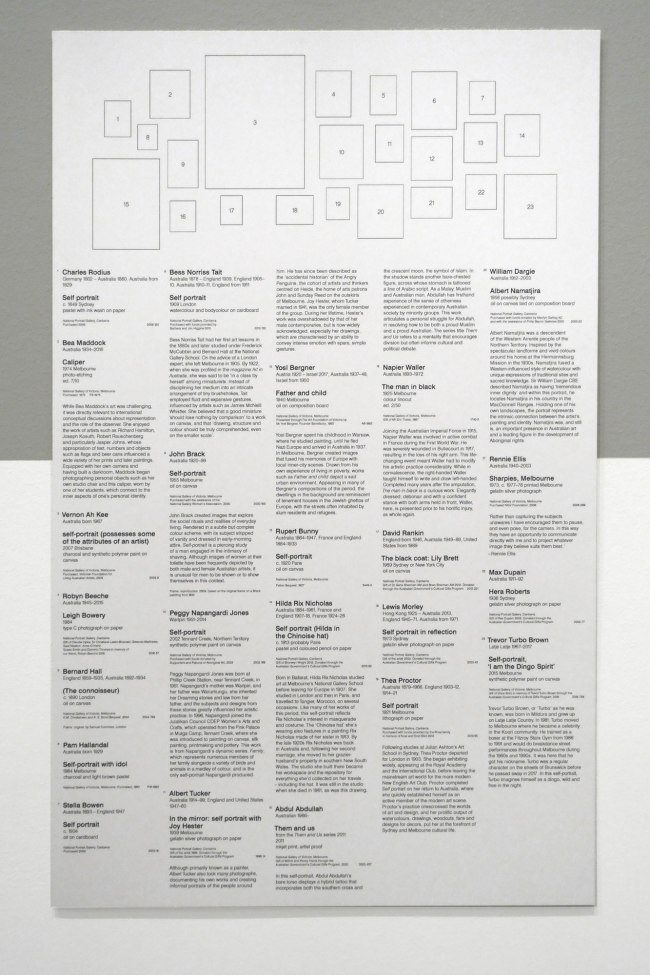
Installation view of the exhibition WHO ARE YOU: Australian Portraiture at NGV Australia, Federation Square, Melbourne
Photo: Marcus Bunyan

Bert Flugelman (Australian born Austria, 1923-2013, Australia from 1938)
Self portrait
c. 1985
Stainless steel
National Portrait Gallery, Canberra
Gift of the artist 2009
Donated through the Australian Government’s Cultural Gifts Program
© Bert Flugelman/Copyright Agency, 2022
Herbert ‘Bert’ Flugelman, sculptor, painter and lecturer, came to Australia from his native Vienna in 1938, aged fifteen. In the late 1940s he trained at the National Art School; he travelled and studied overseas through the first half of the 1950s. In 1967 he won first prize at the Mildura Sculpture Triennial with a large cast-iron equestrian piece. His subsequent public commissions include the untitled copper and ceramic mosaic fountain at Bruce Hall at the Australian National University; Spheres 1977 (known locally as Bert’s Balls) for the Rundle Street Mall, Adelaide; and the Dobell Memorial 1978 for Martin Place, Sydney. Controversially, Tumbling cubes (Dice) (Untitled) 1978/1979, originally made for Cameron Offices in Belconnen ACT, was some years ago moved to a nearby park, according to the artist a ‘hopelessly inappropriate site’. Cones 1982 dominates the Sculpture Garden at the National Gallery of Australia, and the Winged figure (Lawrence Hargrave memorial) 1988 towers 6m high at Mt Keira, near Wollongong. Flugelman taught from 1973 to 1983 at the South Australian School of Art, and from 1984 to 1990 at the University of Wollongong, from which he received an honorary doctorate. There was a retrospective exhibition of his five decades’ work at the Drill Hall Gallery, Australian National University in 2009.
Text from the National Portrait Gallery, Canberra website Nd [Online] Cited 23/06/2022

Lewis Morley (Hong Kong 125 – Australia 2013, England 1945-1971, Australia from 1971)
Self portrait in reflection (installation view)
1973
Gelatin silver photograph
National Portrait Gallery, Canberra
Gift of the artist 2003
Donated through the Australian Government’s Cultural Gifts Program
Photo: Marcus Bunyan

Lewis Morley (Hong Kong 125 – Australia 2013, England 1945-1971, Australia from 1971)
Self portrait in reflection
1973
Gelatin silver photograph
National Portrait Gallery, Canberra
Gift of the artist 2003
Donated through the Australian Government’s Cultural Gifts Program
© Lewis Morley Archive LLC
Lewis Morley OAM (1925-2013)
Lewis Morley OAM (1925-2013), photographer, was born in Hong Kong and went to the United Kingdom with his family at the end of World War 2. He studied commercial art in London and spent time in Paris before taking up photography in 1954, initially working for magazines like Tatler, London Life and She. In 1961, he founded Lewis Morley Studios in Peter Cook’s London club, The Establishment. Here, he built his reputation with photographs of the celebrities that defined the hip spirit of London in the 1960s, among them Cook, Dudley Moore, Charlotte Rampling, Twiggy, Vanessa Redgrave and Jean Shrimpton. In 1963, Morley took one of the world’s most famous photographic portraits – that of Christine Keeler, short-term shared mistress of a British politician and a Soviet diplomat, naked on a Scandinavian chair. By 1971, Morley’s magazine and theatre work in London was petering out, and he emigrated to Australia, where, he said, ‘bingo! there was the sixties all over again’. Shooting increasingly in colour, Morley took many photographs for Dolly, POL, Belle and other publications that now afford an evocative record of changing Australian culture through the 1970s and 1980s. Many of Morley’s portraits from this era were shown in the National Portrait Gallery’s retrospective exhibition Lewis Morley: Myself and Eye in 2003. His work was also the subject of a major exhibitions staged by the National Portrait Gallery, London, in 1989-1990; and the Art Gallery of New South Wales in 2006.
Text from the National Portrait Gallery, Canberra website Nd [Online] Cited 23/06/2022

William Dargie (Australian, 1912-2003)
Albert Namatjira (installation view)
1958
Oil on canvas laid on composition board
National Portrait Gallery, Canberra
Purchased with funds donated by Marilyn Darling AC and the assistance of Philip Bacon Galleries 2000
Photo: Marcus Bunyan
Albert Namatjira was a descendant of the Western Arrant people of the Northern Territory. Inspired by the spectacular landforms and vivid colours around his home at the Hermannsuburg Mission in the 1930s, Namatjira fused Western-influenced style of watercolour with unique expressions of traditional sites and sacred knowledge. Sir William Dargie CBE described Namatjira as having ‘tremendous inner dignity’ and within this portrait, he located Namatjira in his country in the MacDonnell Ranges. Holding one of his own landscapes, the portrait represents the intrinsic connection between the artist’s painting and identity. Namatjira was, and still is, an important presence in Australian art and a leading figure in the development of Aboriginal rights.
Wall text from the exhibition

William Dargie (Australian, 1912-2003)
Albert Namatjira (installation view detail)
1958
Oil on canvas laid on composition board
National Portrait Gallery, Canberra
Purchased with funds donated by Marilyn Darling AC and the assistance of Philip Bacon Galleries 2000
Photo: Marcus Bunyan

Rennie Ellis (Australian, 1940-2003)
Sharpies, Melbourne
1973, printed c. 1977-1978
Gelatin silver print
National Gallery of Victoria, Melbourne
Purchased NGV Foundation, 2006
‘Rather than capturing the subjects unawares I have encouraged them to pause, and even pose, from the camera. In this way they have an opportunity to communicate directly with me and to project whatever image they believe suits them best.’ ~ Rennie Ellis
Wall text from the exhibition

Max Dupain (Australian, 1911-1992)
Hera Roberts (installation view)
1936
Gelatin silver photograph
23.6 cm x 21.4cm
Gift of Rex Dupain 2003
Donated through the Australian Government’s Cultural Gifts Program
Photo: Marcus Bunyan

Max Dupain (Australian, 1911-1992)
Hera Roberts
1936
Gelatin silver photograph
23.6 cm x 21.4cm
Gift of Rex Dupain 2003
Donated through the Australian Government’s Cultural Gifts Program
Hera Roberts (life dates unknown) was a painter, illustrator, designer, commercial artist and milliner. During the 1920s and 30s she produced many covers for the Home magazine, and arranged photo spreads for the magazine promoting fashionable interiors and furniture. She designed a complete room for the Burdekin House exhibition of 1929, including furniture, and also designed furniture for her companion Sydney Ure Smith. Roberts was regarded as an authoritative commentator on matters of style. She was the student and cousin of the artist Thea Proctor, who was also part of the network of ‘lady artists’ who were able to make their careers in interior decorating and taste arbitration. Co-owner of a millinery shop in Pitt Street called ‘June’, Roberts was also one of the finest female fencers in the Southern Hemisphere, operating out of the Sydney Swords Club.
Text from the National Portrait Gallery, Canberra website Nd [Online] Cited 23/06/2022

Trevor Turbo Brown (Australian / Latje Latje, 1967-2017)
Self-portrait, ‘I am the Dingo Spirit’ (installation view)
2015
Synthetic polymer paint on canvas
National Gallery of Victoria, Melbourne
Photo: Marcus Bunyan
Trevor Turbo Brown, or ‘Turbo’ as he was known, was born in Mildura and grew up on Latje Latje Country. In 1981, Turbo moved to Melbourne were he became a celebrity in the Koori community. He trained as a boxer at the Fitzroy Stars Gym from 1986 to 1991 and would do breakdance street performances throughout Melbourne during the 1980s and 1990s. It was here that he got his nickname. Turbo was a regular character on the streets of Brunswick before he passed away in 2017. In this self-portrait Turbo impinges himself as a dingo, wild and free in the night.
Wall text from the exhibition

Trevor Turbo Brown (Australian / Latje Latje, b. 1967)
Self-portrait, ‘I am the Dingo Spirit’
2015
Synthetic polymer paint on canvas
122.3 x 102.2cm
National Gallery of Victoria, Melbourne
Gift of Vince Sinni in memory of Trevor Turbo Brown through the Australian Government’s Cultural Gifts Program, 2018
© the artist’s estate

John Brack (Australian, 1920-1999)
Self-portrait
1955
Oil on canvas
National Gallery of Victoria, Melbourne
Purchased with the assistance of the National Gallery Women’s Association, 2000
John Brack created images that explore the social rituals and realities of everyday living. Rendered in a subtle but complex colour scheme, with its subject stripped of vanity and dressed in early-morning attire, Self-portrait is a piercing study of a man engaged in the intimacy of shaving. Although images of women at their toilette have been recently depicted by both male and female Australian artists, it is unusual for men to be shown or to show themselves in this context.
Wall text from the exhibition

Installation view of the exhibition WHO ARE YOU: Australian Portraiture at NGV Australia, Federation Square, Melbourne with second from left, Michael Cook’s Tunnel No. 2 (2014, below); at third from left, Ron Mueck’s Two Women (2005, below)
Photo: Marcus Bunyan
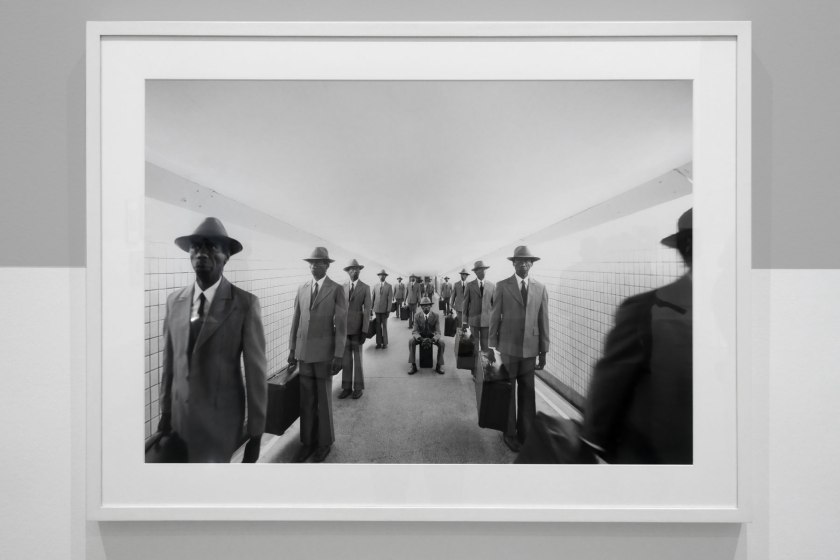
Michael Cook (Australian / Bidjara, b. 1968)
Tunnel No. 2 (installation view)
2014
From the series Majority Rule
Inkjet print
National Gallery of Victoria, Melbourne
Ybonne Pettengell Bequest, 2014
Photo: Marcus Bunyan
‘In Majority Rule I created staged scenarios that question Australian history and the dominance of those in power. The series features the same anonymous Indigenous Man, multiplied over and over in each image. Australia’s Indigenous population comprises around three or four percent of our total population. My images seek to defy this reality and ask the viewer to speculate about an Australia where Aboriginal people constitute the majority of the country’s population; they paint a picture of a societal structure reversed … The works also serve as reminders fo the lack of Indigenous representation within Parliament, the judicial system and the business world.’ ~ Michael Cook, 2017
Wall text from the exhibition
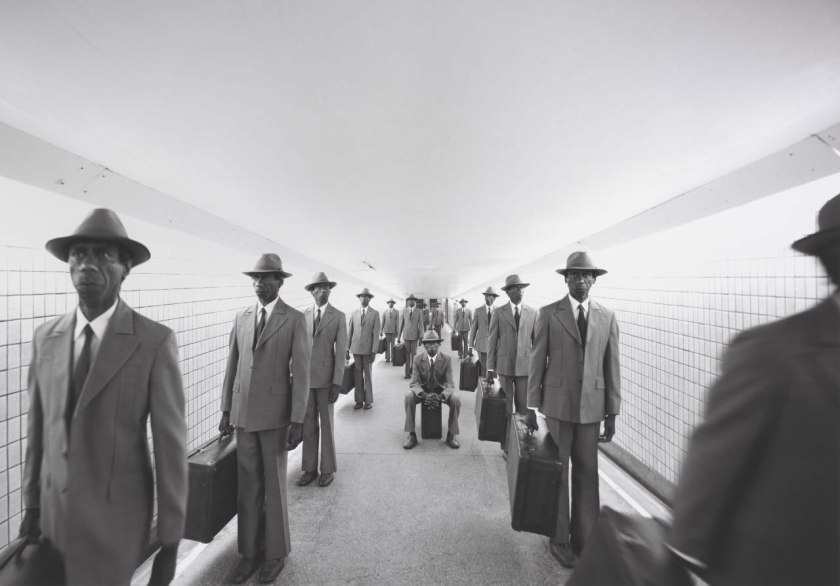
Michael Cook (Australian / Bidjara, b. 1968)
Tunnel No. 2
2014
From the series Majority Rule
Inkjet print
National Gallery of Victoria, Melbourne
Ybonne Pettengell Bequest, 2014
© Courtesy of the artist

Ron Mueck (Australian born England, b. 1958)
Two women
2005
Polyester resin, fibreglass, silicone, polyurethane, aluminium, wire, steel, cotton, nylon, synthetic hair, plastic, metal
National Gallery of Victoria, Melbourne
Purchased, Victorian Foundation for Living Australian Artists, 2007
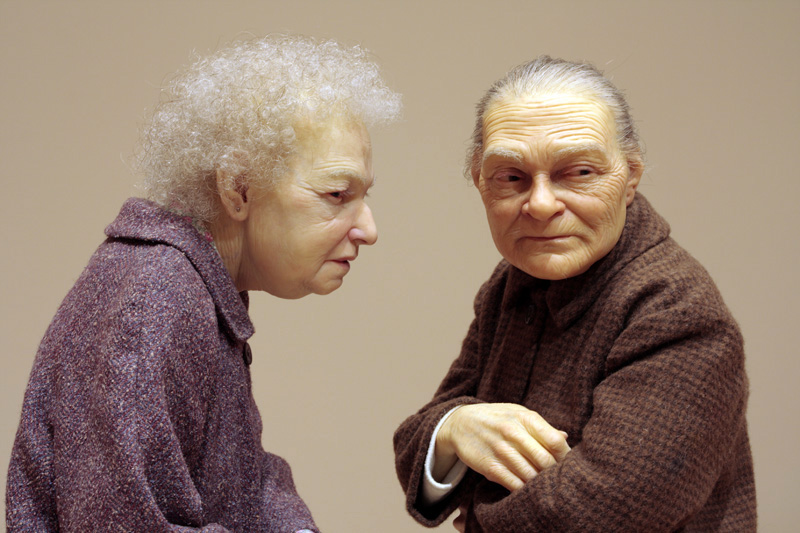
Ron Mueck (Australian born England, b. 1958)
Two women (detail)
2005
Polyester resin, fibreglass, silicone, polyurethane, aluminium, wire, steel, cotton, nylon, synthetic hair, plastic, metal
National Gallery of Victoria, Melbourne
Purchased, Victorian Foundation for Living Australian Artists, 2007
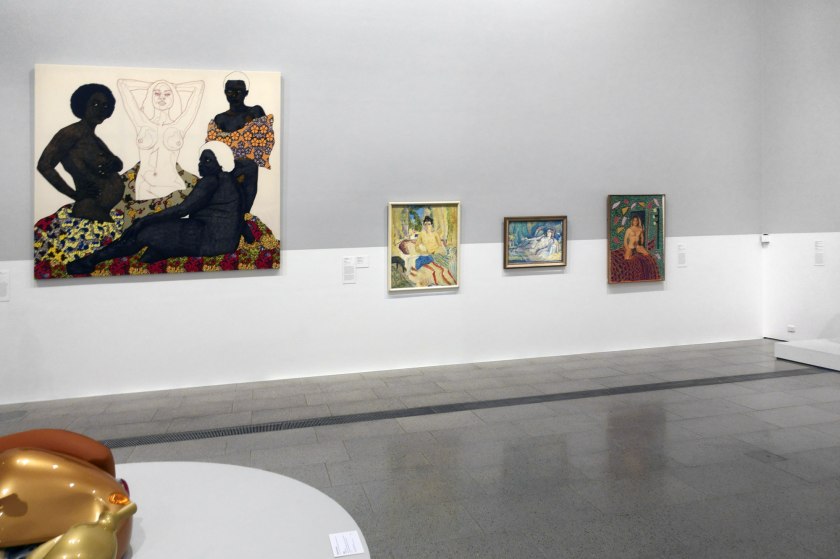
Installation view of the exhibition WHO ARE YOU: Australian Portraiture at NGV Australia, Federation Square, Melbourne showing at left, Pierre Mukeba’s Impartiality (2018, below); at second right, William Frater’s Reclining nude (c. 1933, below); and at right, Pat Larter’s Marty (1995, below)
Photo: Marcus Bunyan

Pierre Mukeba (Australian born Democratic Republic of the Congo, b. 1995, Australia from 2006)
Impartiality
2018
Fibre-tipped pen and printed fabric on cotton
245.0 × 270.0cm
National Gallery of Victoria, Melbourne
Purchased with funds donated by Anne Ross, 2018
© Pierre Mukeba, courtesy of GAGPROJECTS
Pierre Mukeba was a child when he fled with his family from the Democratic Republic of the Congo to Zambia, where they lived in a refugee camp before joining family in Zimbabwe. Following the Mugabe regime’s arrest order for non-nationals, the family applied for asylum through the Australian Embassy and relocated to Adelaide in 2006. In this work, Mukeba uses patterned Dutch wax print fabrics commonly perceived as being ‘African’, while in reality, they were appropriated from traditional Javanese bark by Dutch colonisers in the nineteenth century, mass produced in Europe and exported to Africa. This painting is part of a group of works by Mukeba, in which he draws on sociocultural standards of beauty and representations of his community.
Wall text rom the exhibition

William Frater (Australian born Scotland, 1890-1974, Australia from 1913)
Reclining nude (installation view)
c. 1933
Oil on canvas on cardboard
National Gallery of Victoria, Melbourne
Purchased, 1950
Photo: Marcus Bunyan
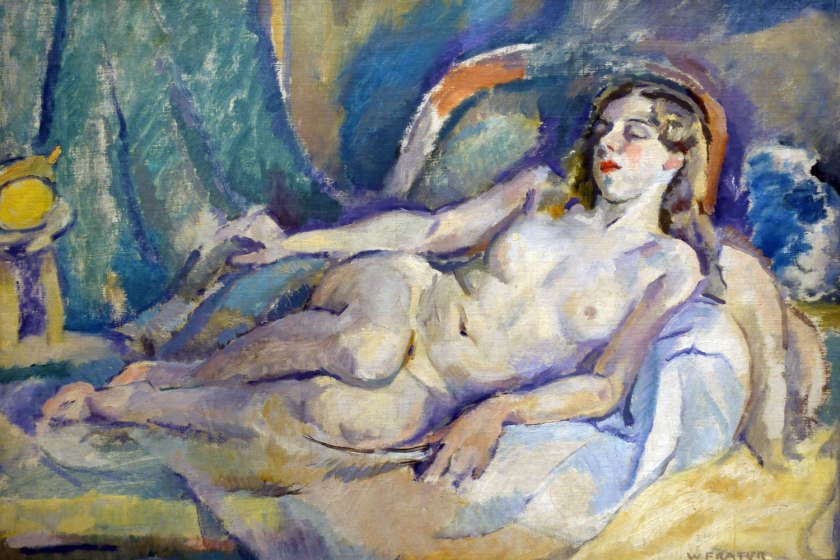
William Frater (Australian born Scotland, 1890-1974, Australia from 1913)
Reclining nude (installation view detail)
c. 1933
Oil on canvas on cardboard
National Gallery of Victoria, Melbourne
Purchased, 1950
Photo: Marcus Bunyan

William Frater (Australian born Scotland, 1890-1974)
The artist’s wife
1915
Oil on canvas on plywood
47.0 x 32.9cm
National Gallery of Victoria, Melbourne
The Joseph Brown Collection
Presented through the NGV Foundation by Dr Joseph Brown AO OBE, Honorary Life Benefactor, 2004

Pat Larter (Australian born England, 1936-1996, Australia from 1962)
Marty (installation view)
1995
Coloured inks, synthetic polymer paint, plastic, glitter and self-adhesive plastic collage on canvas
National Gallery of Victoria, Melbourne
Purchased, 1997
Photo: Marcus Bunyan
Throughout her career, Pat Larter produced performance art, photography and multimedia images that focus on the consumption of the naked body throughout the media. Often adapting pornographic images to encourage debate on art, the body and censorship, Larter actively looked to challenge society’s ideas of the nude by producing striking, and sometimes humorous images. Marty is part of a series for which Larter visited Sydney’s brothels to photograph male sex workers. By showing the model in a full frontal, active position, Larter reflects on the double standards of how society consumes nudity in art. Images of naked women are viewed with ease, while depictions of naked men cause shock and often outrage.
Wall text from the exhibition
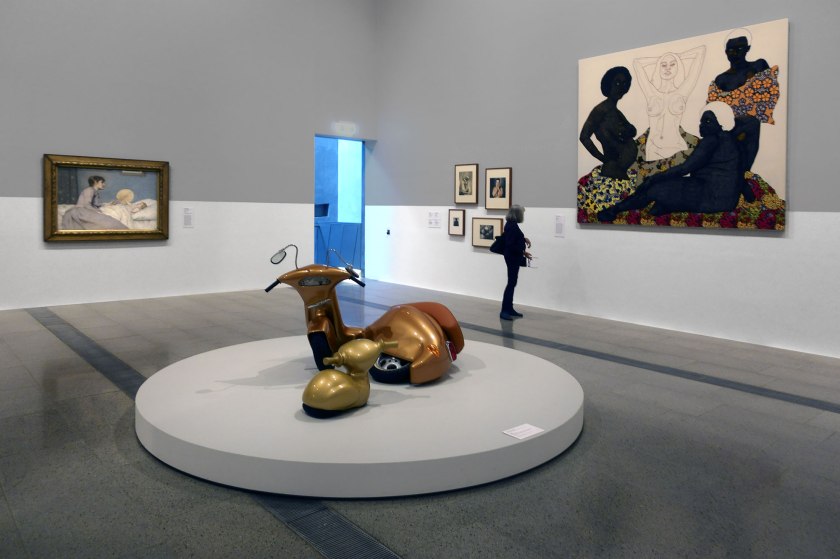
Installation view of the exhibition WHO ARE YOU: Australian Portraiture at NGV Australia, Federation Square, Melbourne showing at left, John Longstaff’s The young mother (1891, below); at centre Patricia Piccinini’s Nest (2006); at second right, a group of four photographs one by each of Jack Cato, Virginie Grange, Olive Cotton and Athol Shmith (see below); and at right Pierre Mukeba’s Impartiality (2018, above)
Photo: Marcus Bunyan

John Longstaff (Australian, 1861-1941, France and England 1887-1895, England 1901-1920)
The young mother (installation view)
1891
Oil on canvas
National Gallery of Victoria, Melbourne
Purchased with funds donated by the NGV Women’s Association, Alan and Mavourneen Cowen, Paula Fox, Ken and Jill Harrison and donors to the John Longstaff Appeal, 2013
Photo: Marcus Bunyan
A gifted student, John Longstaff was awarded the National Gallery School’s inaugural travelling scholarship in 1887. Longstaff and Rosa Louisa (Topsy) Crocker married two months before departing to London in September 1887. An intimate depiction of motherhood, The young mother shows Topsy tenderly waving a palm fan over the outstretched arms of her son, Ralph, who was born in 1890. Topsy appears pale and slim after a long winter spent in their one-room apartment, divided by a curtain into sleeping and eating quarters. The subject of the mother and child has its origins in the depiction of the biblical Madonna and Child, and continued to be a popular subject for nineteenth-century artists recoding their personal and secular experiences with tenderness and conviction.
Wall text rom the exhibition
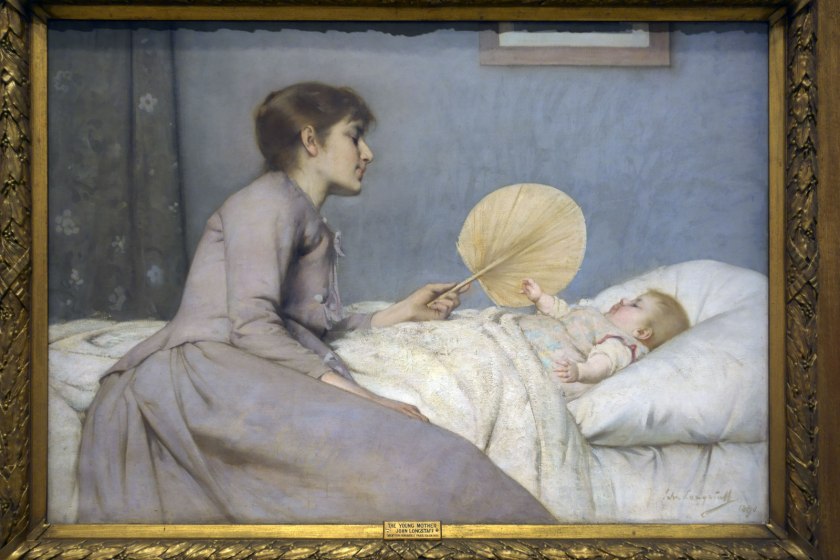
John Longstaff (Australian, 1861-1941, France and England 1887-1895, England 1901-1920)
The young mother (installation view detail)
1891
Oil on canvas
National Gallery of Victoria, Melbourne
Purchased with funds donated by the NGV Women’s Association, Alan and Mavourneen Cowen, Paula Fox, Ken and Jill Harrison and donors to the John Longstaff Appeal, 2013
Photo: Marcus Bunyan
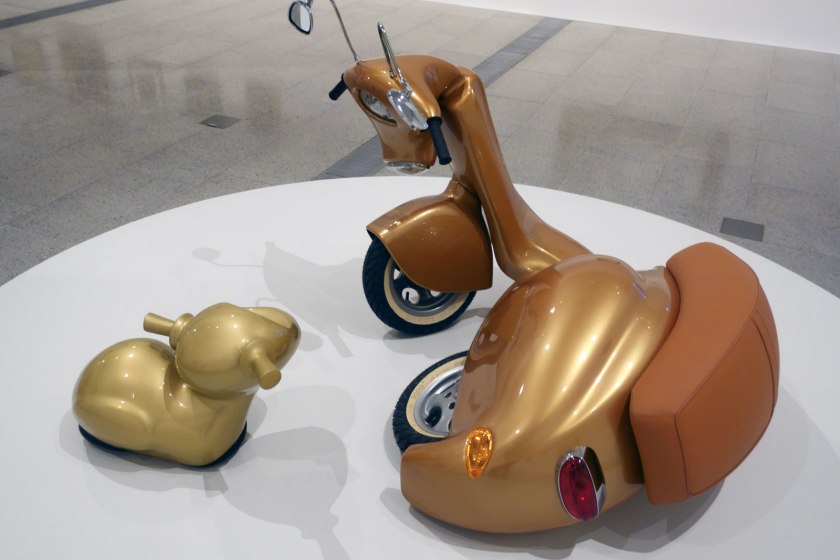
Patricia Piccinini (Australian, b. 1965)
Nest (installation view)
2006
Enamel paint on fibreglass, leather, plastic, metal, rubber, mirror, transparent synthetic polymer resin, glass
(a-b) 104.2 × 197.0 × 186.4cm (variable) (installation)
National Gallery of Victoria, Melbourne
Purchased, Victorian Foundation for Living Australian Artists, 2006
Photo: Marcus Bunyan

Patricia Piccinini (Australian, b. 1965)
Nest
2006
Enamel paint on fibreglass, leather, plastic, metal, rubber, mirror, transparent synthetic polymer resin, glass
(a-b) 104.2 × 197.0 × 186.4cm (variable) (installation)
National Gallery of Victoria, Melbourne
Purchased, Victorian Foundation for Living Australian Artists, 2006
© Courtesy of the artist
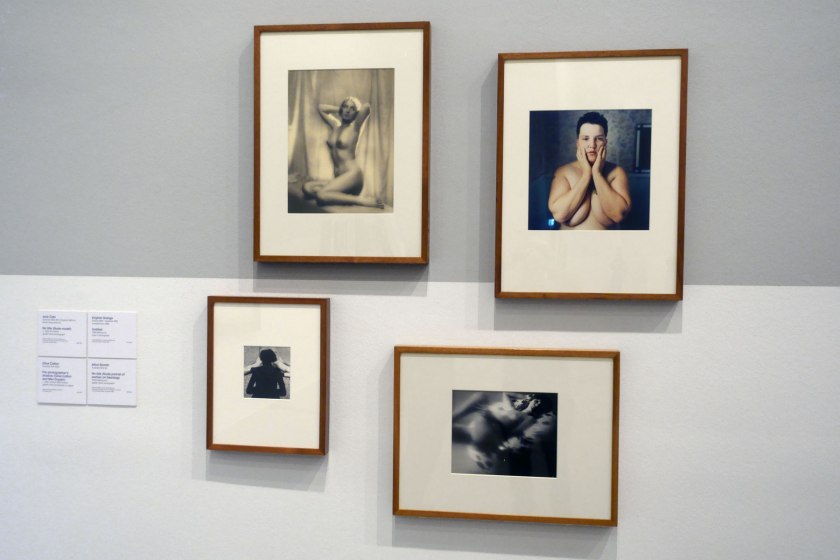
Installation view of the exhibition WHO ARE YOU: Australian Portraiture at NGV Australia, Federation Square, Melbourne showing at top left, Jack Cato’s No title (Nude model) (c. 1928-1932, below); at top right, Virginie Grange’s Untitled (1990, below); at bottom left, Olive Cotton’s The photographer’s shadow (Olive Cotton and Max Dupain) (c. 1935, below); and at bottom right, Athol Shmith’s No title (Nude portrait of woman on beanbag) (1970s)
Photo: Marcus Bunyan

Jack Cato (Australian, 1889-1971)
No title (Nude model)
c. 1928-1932
Gelatin silver photograph
Image and sheet: 44.1 × 33.7cm
Support: 49.1 × 37.8cm
Gallery of Victoria, Melbourne
Presented through the NGV Foundation by John Cato, Fellow, 2005

Virginie Grange (French; Australian, 1969-1990)
Untitled
1990
Type C photograph
35.0 × 35.1cm
Gallery of Victoria, Melbourne
Gift of the artist’s family, 1991
© Estate of the artist

Olive Cotton (Australian, 1911-2003)
The photographer’s shadow (Olive Cotton and Max Dupain)
c. 1935
Gelatin silver print
16.6 cm x 15.2cm
National Portrait Gallery, Canberra
Purchased 2010
Olive Cotton (1911-2003) and Max Dupain OBE (1911-1992) were pioneering modernist photographers. Cotton’s lifelong obsession with photography began at age eleven with the gift of a Kodak Box Brownie. She was a childhood friend of Dupain’s and in 1934 she joined his fledgling photographic studio, where she made her best-known work, Teacup Ballet, in about 1935. Throughout the 1930s, Dupain established his reputation with portraiture and advertising work and gained exposure in the lifestyle magazine The Home. Between 1939 and 1941, Dupain and Cotton were married and she photographed him often; her Max After Surfing is frequently cited as one of the most sensuous Australian portrait photographs. While Dupain was on service during World War II Cotton ran his studio, one of very few professional women photographers in Australia. Cotton remarried in 1944 and moved to her husband’s property near Cowra, New South Wales. Although busy with a farm, a family, and a teaching position at the local high school, Cotton continued to take photographs and opened a studio in Cowra in 1964. In the 1950s, Dupain turned increasingly to architectural photography, collaborating with architects and recording projects such as the construction of the Sydney Opera House. Dupain continued to operate his studio on Sydney’s Lower North Shore until he died at the age of 81. Cotton was in her seventies when her work again became the subject of attention. In 1983, she was awarded a Visual Arts Board grant to reprint negatives that she had taken over a period of forty years or more. The resulting retrospective exhibition in Sydney in 1985 drew critical acclaim and has since assured her reputation.
Text from the National Portrait Gallery, Canberra website Nd [Online] Cited 24/06/2022
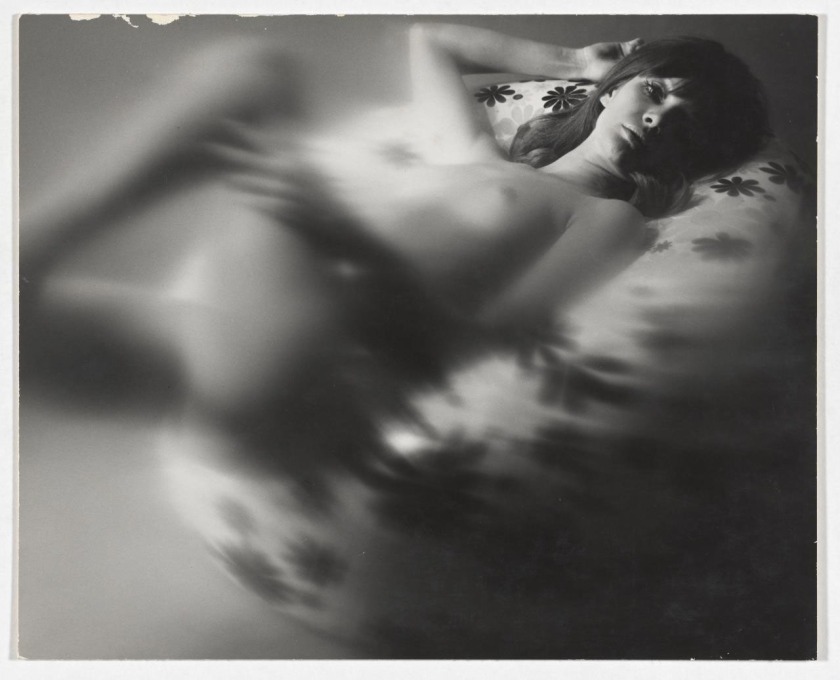
Athol Shmith (Australian, 1914-1990)
No title (Nude portrait of woman on beanbag)
1970s
Gelatin silver photograph
28.0 × 22.4cm
Gallery of Victoria, Melbourne
Presented through The Art Foundation of Victoria by the Shmith Family, Governor, 1995
© Estate of Athol Shmith

Installation view of the exhibition WHO ARE YOU: Australian Portraiture at NGV Australia, Federation Square, Melbourne with at second left, Danila Vassielieff’s Young girl (Shirley) (1937, below)
Photo: Marcus Bunyan

Ruth Hollick (Australian, 1883-1977)
Janet Armstrong, Woodbury Estate, Deniliquin, New South Wales
c. 1939
Gelatin silver photograph
21.6 × 28.8cm
National Gallery of Victoria, Melbourne
Gift of Mrs Lucy Crosbie Morrison, 1992

Danila Vassilieff (Australian born Russia, 1897-1958, Australia 1923-1929, Central and South America, Europe, England, 1929-1935, Australia from 1935)
Young girl (Shirley) (installation view)
1937
Oil on canvas on composition board
National Gallery of Victoria, Melbourne
National Gallery Society of Victoria Century Fund, 1984
Photo: Marcus Bunyan

Danila Vassilieff (Australian born Russia, 1897-1958, Australia 1923-1929, Central and South America, Europe, England, 1929-1935, Australia from 1935)
Young girl (Shirley)
1937
Oil on canvas on composition board
National Gallery of Victoria, Melbourne
National Gallery Society of Victoria Century Fund, 1984
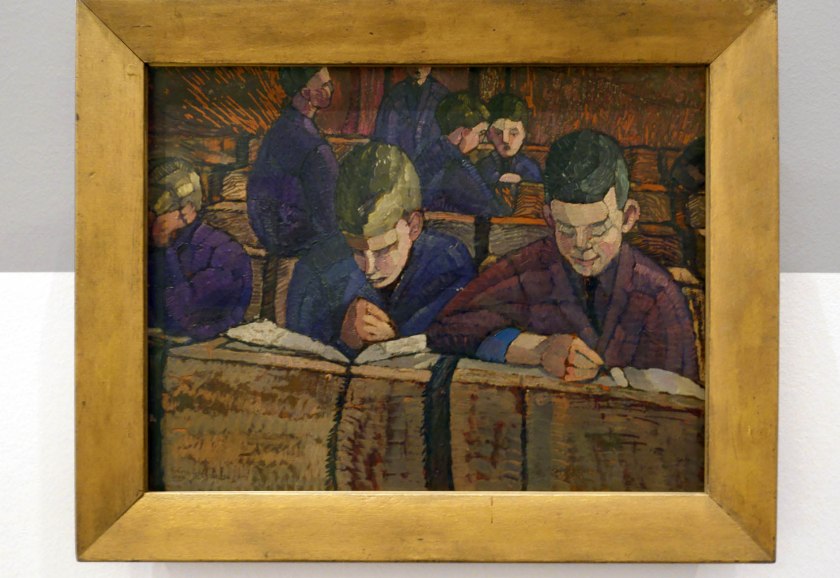
Grace Cossington Smith (Australian, 1892-1984)
Boys drawing (installation view)
c. 1926-1927
Oil on plywood
National Gallery of Victoria, Melbourne
Purchased through The Art Foundation of Victoria with the assistance of the Marjorie Webster Memorial, Governor, 1983
© Estate of Grace Cossington Smith
Photo: Marcus Bunyan
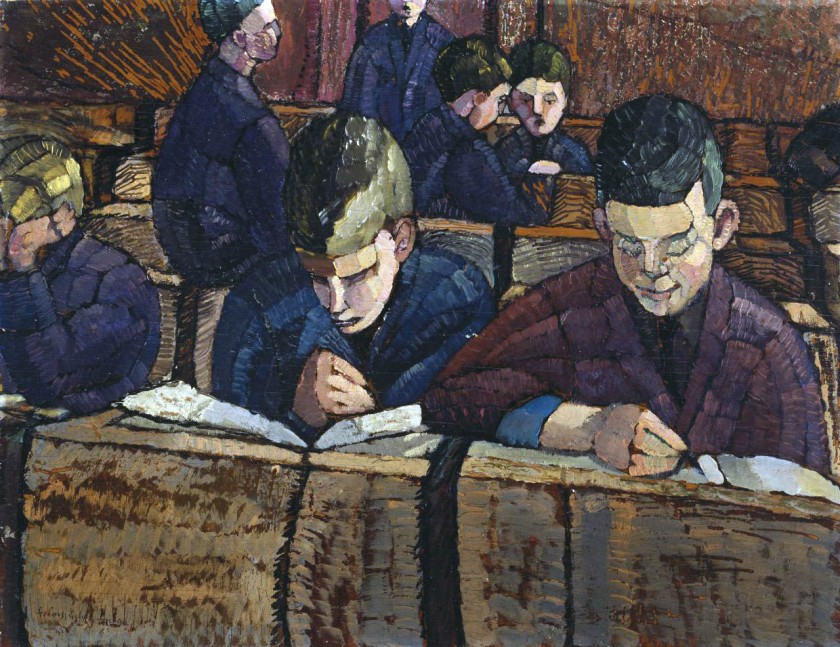
Grace Cossington Smith (Australian, 1892-1984)
Boys drawing
c. 1926-1927
Oil on plywood
National Gallery of Victoria, Melbourne
Purchased through The Art Foundation of Victoria with the assistance of the Marjorie Webster Memorial, Governor, 1983
© Estate of Grace Cossington Smith
The 1920s saw the advancement of modernism in Australia, due in large part to the dedication of women artists such as Grace Cossington Smith to work in modern styles. Celebrated for her iconic urban images and luminous interiors, Cossington Smith first studied with Antonio Dattilo Rubbo in Sydney, and between 912 and 1914, she toured Germany and England with her family. Following her return to Rubbo’s school, Cossington Smith starting producing work in a cutting-edge Post-Impressionistic style. For several years Cossington Smith worked as a part-time teacher at Turramurra College, a day and boarding school for boys. During this period she developed a painting technique based on the idea that vibrations emanating from colour expressed a spiritual condition as well as optical movement.
Wall text rom the exhibition
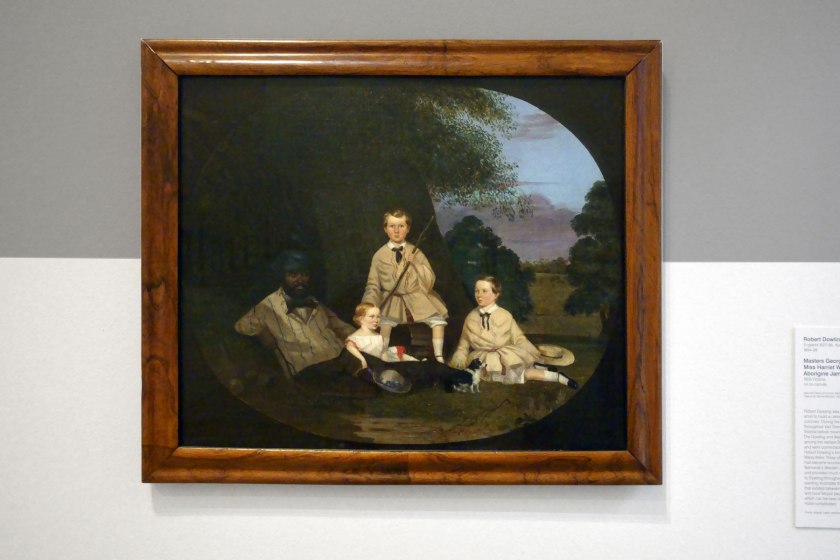
Robert Dowling (England 1827-1886, Australia 1834-1857, 1884-1886)
Masters George, William and Miss Harriet Ware with the Aborigine Jamie Ware (installation view)
1856
Oil on canvas
63.7 × 76.4cm
National Gallery of Victoria, Melbourne
Eleanor M. Borrow Bequest, 2007
Photo: Marcus Bunyan

Robert Dowling (England 1827-1886, Australia 1834-1857, 1884-1886)
Masters George, William and Miss Harriet Ware with the Aborigine Jamie Ware
1856
Oil on canvas
63.7 × 76.4cm
National Gallery of Victoria, Melbourne
Eleanor M. Borrow Bequest, 2007

Installation view of the exhibition WHO ARE YOU: Australian Portraiture at NGV Australia, Federation Square, Melbourne with at left, E. Phillips Fox’s Dolly, daughter of Hammond Clegg Esq. (1896, below); at second left, Nora Heysen’s Self portrait (1934, below); and at third right, Florence Fuller’s Paper Boy (1888, below)
Photo: Marcus Bunyan
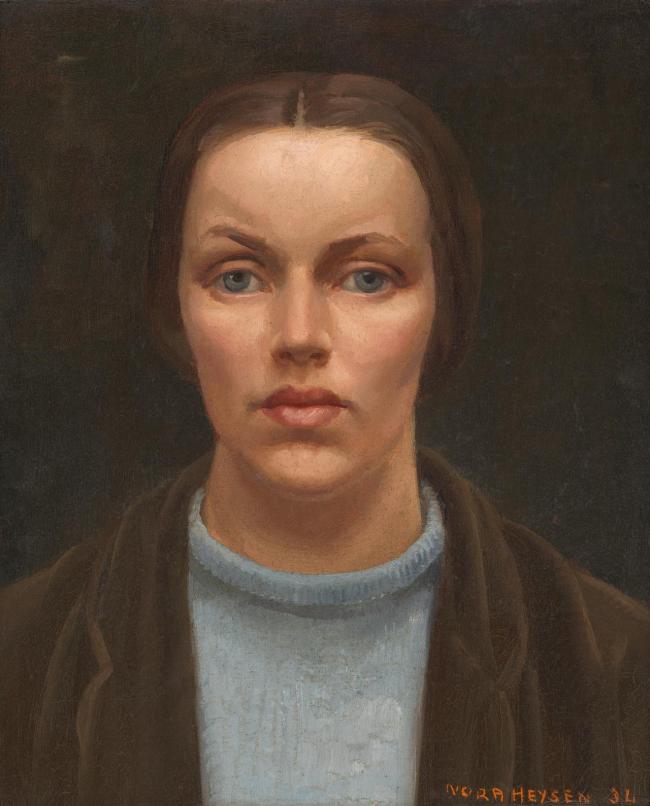
Nora Heysen (Australian, 1911-2003, lived in England and Italy 1934-1937)
Self portrait
1934
Oil on canvas
43.1 x 36.3cm
National Portrait Gallery, Canberra
Purchased 1999
© Lou Klepac

Florence Fuller (Australian born South Africa, 1867-1946, Australia from 1868)
(Paper boy) (installation view)
1888
Oil on canvas
61.2 × 45.5cm
National Gallery of Victoria, Melbourne
Gift of Krystyna Campbell-Pretty AM and Family through the Australian Government’s Cultural Gifts Program, 2020
Photo: Marcus Bunyan
Paper boys were prominent part of street life in nineteenth-century Melbourne. Mostly from disadvantaged circumstances, boys as young as eight would work long hours selling newspapers on the city’s streets, many supporting single mothers or siblings, or working to survive independently. The boys were exposed to crime and exploitation, and were seen as hardened and cheeky, yet Florence Fuller’s portrait is sensitive and nuanced. Her work is often focused on those living in poverty, which provides insight into Melbourne’s social diversity. Fuller worked as a professional artist throughout her life – encouraged by her parents and her uncle, artist Robert Dowling – and exhibited at the Paris Salon and the Royal Academy, London.
Wall text rom the exhibition

Josephine Muntz Adams (Australian, 1862-1950)
Italian girl’s head (installation view)
1913
Oil on canvas
51.0 × 42.9cm
National Gallery of Victoria, Melbourne
Felton Bequest, 1936
Photo: Marcus Bunyan

Josephine Muntz Adams (Australian, 1862-1950)
Italian girl’s head
1913
Oil on canvas
51.0 × 42.9cm
National Gallery of Victoria, Melbourne
Felton Bequest, 1936

Installation view of the exhibition WHO ARE YOU: Australian Portraiture at NGV Australia, Federation Square, Melbourne showing the work of Simon Obarzanek from his series 80 Faces (2002, below)
Photo: Marcus Bunyan

Simon Obarzanek (Australian born Israel, b. 1968, United States 1995-2001)
Untitled (80 faces) #78
2002
Gelatin silver photograph
Gallery of Victoria, Melbourne
Gift of the artist through the Australian Government’s Cultural Gifts Program, 2013
© Simon Obarzanek
The black and white photographs from Simon Obarzanek’s 80 Faces series show frontal portraits of teenagers, captured from the shoulders up with a consistent, neutral backdrop. The sitters are all aged between fourteen and seventeen, the majority from Victoria’s state schools. When capturing their image, the artist only spends five minutes with each sitter, and discusses nothing about their life. In this body of work, Obarzanek explores the idea that the identity or appearance of an individual sitter reveals something new to the audience when viewed as part of a series.
Wall text rom the exhibition

Simon Obarzanek (Australian born Israel, b. 1968, United States 1995-2001)
Untitled (80 faces) #59
2002
Gelatin silver photograph
Gallery of Victoria, Melbourne
Gift of the artist through the Australian Government’s Cultural Gifts Program, 2013
© Simon Obarzanek

Installation view of the exhibition WHO ARE YOU: Australian Portraiture at NGV Australia, Federation Square, Melbourne showing at left, Maria Brownrigg’s An evening at Yarra Cottage, Port Stephens (1857, below); and at second left, Samuel Metford’s MacKenzie family silhouette (1846, below)
Photo: Marcus Bunyan

Maria Brownrigg (Australian born Ireland 1812-1880, South Africa date unknown – c. 1852, Australia from 1852)
An evening at Yarra Cottage, Port Stephens (installation view)
1857
Watercolour and collage on paper
National Portrait Gallery, Canberra
Purchased, 2017
Photo: Marcus Bunyan

Maria Brownrigg (Australian born Ireland 1812-1880, South Africa date unknown – c. 1852, Australia from 1852)
An evening at Yarra Cottage, Port Stephens
1857
Watercolour and collage on paper
National Portrait Gallery, Canberra
Purchased, 2017
Maria Caroline Brownrigg came to New South Wales in 1852, when her husband was appointed superintendent of the Australian Agricultural Company’s operations in the Hunter River district. The family lived at Stroud and subsequently at Port Stephens, where Brownrigg made this portrait of her six children. It is the only known example of Brownrigg’s work. Though ‘amateur’, it is valuable to decorative arts and social historians, for its detailed documentation of an appropriately conducted mid nineteenth-century drawing room, and for what it reveals about Victorian gender ideals and aspirations to gentility.
Wall text rom the exhibition

Samuel Metford (England 1810-1890, lived in United States 1834-1844)
MacKenzie family silhouette
1846
Brush and ink, pen and ink, stencil cutout with watercolour highlights on paper
43.2 x 64.0cm
National Portrait Gallery, Canberra
Gift of the Estate of Nancy Wiseman
Samuel Metford was born in Glastonbury, into a Quaker family. In England he came to specialise in full-length silhouette likenesses, cut from black paper and embellished with gold and white paint. According to the standard text on British silhouettes, Metford made ‘some very fine family groups – Father and Mother surrounded by their children and pets, with hand-painted backgrounds of imposing rooms whose tall windows looked out on wide landscapes, or a seascape with a tall-funnelled steamship in a prominent position.’ Metford moved to America in about 1834, and spent some ten years there, working mostly in Connecticut but also in New York and South Carolina. He returned to England in the early 1840s, and lived there for the rest of his life, although he revisited America in 1869 and 1867. He died at Weston-Super-Mare.
Samuel Metford (1810-1896), specialised in full-length silhouette likenesses on hand-painted watercolour backgrounds, sometimes embellished with gold and white paint or featuring gentrified interiors. Born in Glastonbury, Somerset, he received tuition from French silhouette artist Augustin Edouart, before going to America and working for the next ten years in New York, Philadelphia and Boston. His return to England in the mid-1840s coincided with the downturn in demand for profile portraits occasioned by photography which, by the 1860s, had rendered art forms such as the silhouette passé. This silhouette depicts the family of Francis MacKenzie (1806-1851, seated far right) at Adlington Hall in Standish, Lancashire. Following Francis MacKenzie’s death, his widow, Maria (1810-1874, third from left) emigrated to Australia with her five children. Maria’s eldest son, John (1833-1917, seated, left, at the table), was Examiner of Coalfields in the Illawarra from 1863 and 1865, later becoming Examiner of Coalfields for NSW. Her sons Walter (1835-1886, seated, right, at the table) and Kenneth (d. 1903) are thought to have become clergymen. Her youngest daughter, Maria (1842-1917, second from left), married a doctor, Alexander Morson, in 1875. Another daughter, Caroline (1837-1922, fourth from left), remained unmarried and died at the family property near Dapto in 1922. Other sitters shown in the silhouette are Maria’s mother, Mrs Thomas Edwards (far left); and her youngest child, William, who died, aged six, in 1851. Maria MacKenzie died at Wallerawang in New South Wales in 1874. The silhouette was bequeathed to the Gallery by her great-grandaughter in 2007.
Text from the National Portrait Gallery, Canberra website updated 2018 [Online] Cited 28/06/2022

Installation view of the exhibition WHO ARE YOU: Australian Portraiture at NGV Australia, Federation Square, Melbourne showing by unknown artists – at left, Anna Josepha King (c. 1826-1832, below); and at right, Fanny Jane Marlay (c. 1841, below)
Photo: Marcus Bunyan

Unknown artist (Australia)
Anna Josepha King
c. 1826-1832
watercolour and gouache on ivory
Frame: 9.7 cm x 8.3cm
Sheet: 8.5 cm x 6.5cm
Image: 7.0 cm x 5.7cm
National Portrait Gallery, Canberra
Purchased 2018
Before the early 1840s, when photography began to take hold, portrait miniatures were a favoured means by which people might secure tangible and enduring mementos of their loved ones. Typically executed in watercolour on panels of ivory and contained in petite frames or mounted in pendants, brooches, rings, and lockets, miniatures were designed to be clutched, kissed, carried close to the heart or displayed on a bedside table. Many early Australian colonists brought British-made miniatures with them, but increasing numbers of free settlers from the 1820s onwards soon created demand for miniatures by local, readily-available artists.
Text from the National Portrait Gallery, Canberra website Nd [Online] Cited 28/06/2022

Unknown artist (Australia)
Fanny Jane Marlay
c. 1841
watercolour on ivory
Frame: 7.5 cm x 6.3cm
National Portrait Gallery, Canberra
Purchased 2013
Fanny Jane Marlay (1819-1848) came to Sydney with her free-settler family around 1825. In 1838, she met John Lort Stokes (1812-1885), an explorer, naval officer and surveyor appointed to HMS Beagle, which was then engaged in a surveying voyage of the Australian coast. In the course of it, Stokes charted much of what is now the coast of the Northern Territory; gave Darwin its name (after his former shipmate, Charles Darwin); and surveyed the Gulf of Carpentaria, the Arafura Sea, the Torres Strait, the Western Australian coast, and Bass Strait. He and Fanny married in Sydney in January 1841. Later the same year, Stoke succeeded to the command of the Beagle. Their daughter was born in 1842. Fanny returned with Stokes to England in 1843 and died while en route to Sydney again in 1848. Back in England from 1851, Stokes was eventually promoted to admiral. He died at his home, Scotchwell, in Pembrokeshire, in June 1885, survived by his second wife, Louisa, whom he’d married in 1856, and by his daughter from his marriage to Fanny.
Text from the National Portrait Gallery, Canberra website Nd [Online] Cited 28/06/2022

Installation view of the exhibition WHO ARE YOU: Australian Portraiture at NGV Australia, Federation Square, Melbourne
Photo: Marcus Bunyan

Ada Whiting (Australian, 1859-1953)
The Earl of Linlithgow
1901
Watercolour on ivory
6.6 × 5.0cm
National Gallery of Victoria, Melbourne
Gift of Mrs Violet Whiting, 1989

Ludwig Becker (Australian born Germany, 1808-1861)
Caroline Davidson (installation view)
1854
Watercolour on fictile ivory
Image: 5.7 × 4.6cm
National Gallery of Victoria, Melbourne
Purchased, 1996
Photo: Marcus Bunyan

Unknown artist (Australia)
Thomas and John Clarke, bushrangers, photographed in Braidwood gaol
1867
Albumen silver photograph laid down on a section cut from a nineteenth-century album page
National Portrait Gallery, Canberra
Purchased, 2019
John (c. 1846-1867) (left) and Thomas Clarke (c. 1840-1867), bushrangers, grew up near Braidwood and from a young age were schooled in nefarious activities including horse-theft. John was 17 when he first went to prison and Thomas was purported to have ridden with the infamous Ben Hall. In October 1865, Thomas escaped from gaol while awaiting trial for armed robbery; thereafter, aided by various mates, he embarked on a string of depredations around Braidwood, Araluen and further south. In April 1866, at Nerrigundah, the gang engaged in a hold-up that left a policeman dead. Thomas was outlawed in May, by which time John had joined him. Reports described them as ‘well-mounted, and armed to the teeth’. In September 1866 colonial secretary Henry Parkes sent four special constables to Braidwood ‘for the express purpose of hunting down the desperate marauders’. In January 1867, the four were murdered in an ambush at Jinden. The Clarkes were blamed immediately and the authorities offered rewards of £1000 each, alive or dead. Aided by an effective bush telegraph system, the brothers evaded capture until April 1867, when they were tracked to a hideout near Araluen, apprehended, and taken to Braidwood Gaol. There, an as yet unidentified photographer took portraits that were sold by a Goulburn bookseller for two shillings and sixpence each. The brothers were later tried in Sydney before Sir Alfred Stephen, who in sentencing them to death noted the more than 60 offences, excluding murders, of which they were suspected.
Text from the National Portrait Gallery, Canberra website Nd [Online] Cited 28/06/2022
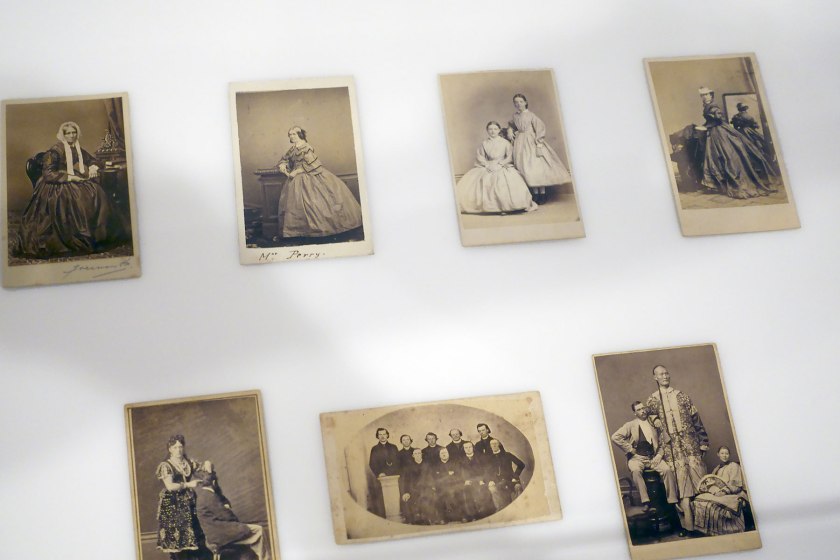
Installation view of the exhibition WHO ARE YOU: Australian Portraiture at NGV Australia, Federation Square, Melbourne showing a selction of cartes de visite: at top left, Freeman Brothers Studio, Sydney (Australia 1854-1900) Maria Windeyer (c. 1865-1868); at second left top, Batchelder & O’Neill (Australia active 1857-1863) Frances Perry (c. 1863); at second right top, Townsend Duryea (Australian born America, 1823-1888) Sarah and Ann Jacob c. 1866; at top right, Batchelder & O’Neill (Australia active 1857-1863) Lady Barkly (1863); at bottom left, James E. Bray (Australia 1832-1891) Madame Sibly, Phrenologist and Mesmerist (c. 1870); at centre bottom, Stephen Edward Nixon (England 1842 – Australia 1910) Catholic clergymen from the Diocese of Adelaide (c. 1862); and at bottom right, Archibald McDonald (Canada c. 1831 – Australia 1873, Australia from c. 1847) Chang the Chinese Giant with his wife Kin Foo and manager Edward Parlett (c. 1871)
Photo: Marcus Bunyan
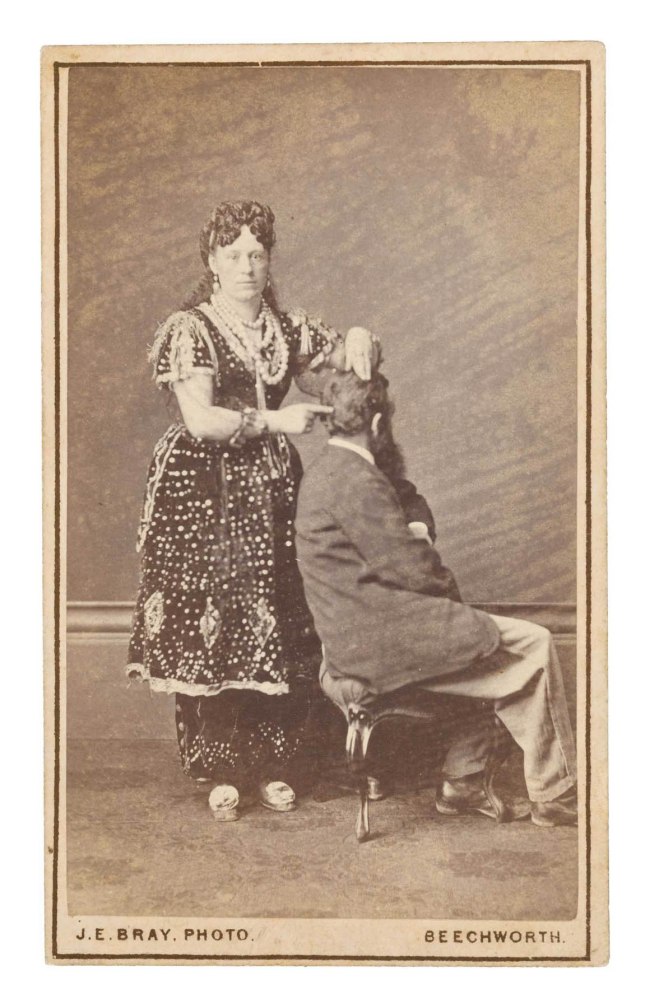
James E. Bray (Australia, 1832-1891)
Madame Sibly, Phrenologist and Mesmerist
c. 1870
albumen silver carte de visite photograph
Mount: 10.1 cm x 6.2cm
Image: 9.4 cm x 5.5cm
National Portrait Gallery, Canberra
Purchased, 2017
Marie Sibly (c. 1830-1894), mesmerist and phrenologist, performed in towns throughout Australia for nearly twenty years. Purportedly French-born, she arrived in Sydney around 1867 and worked as a clairvoyant, making her first stage appearances in 1868. By 1871 she was in Melbourne, ‘manipulating heads’ for packed houses at Weston’s Opera House on Bourke Street before embarking on a tour of Victoria. Through the 1870s she toured New South Wales and Queensland, her shows incorporating séances, phrenological readings and hypnotisms whereby audiences members were induced to fight, dance, sing or behave absurdly. A report of one performance described how she convinced two men to fetch a leg of lamb from the butcher; she then made them think they were dogs and they ate it. Her later repertoire included ‘baby exhibitions’ in which prizes were awarded to the specimens with the best mental and physical capacity. She took up land at Parkes in 1877 but continued touring regardless. By the mid-1880s she was in New South Wales again, performing with her daughter, ‘Zel the Magnetic Lady’, and advertising her range of remedies for conditions such as gout, rheumatism and neuralgia. She was known by various names throughout her career although it is unclear how many husbands she had. Having ‘retired from the platform’ she ran a store at Drake, near Tenterfield, where she died in April 1894.
James E Bray ran a business called the ‘Prince of Wales Photographic Gallery’ on George Street, Sydney, which was sold in late 1865. He then went to Victoria, and by early 1868 was reported as ‘having an extensive gallery built at his place of business, Camp Street, Beechworth’. There, he was enabled to ‘execute Every Variety of Photographic Portraiture’, including ‘Cartes de Viste, Tinted or Fully Colored in Water Colors’. He appears to have stocked portraits of international celebrities (such as the conman Arthur Orton, aka The Tichborne Claimant) in addition to taking likenesses for local citizens. Notably, he was among the photographers who documented the Kelly gang and their off-shoots: such as the 22 men of Irish descent who were banged up in Beechworth Gaol for four months without charge in 1879 on the off-chance they might be Kelly sympathisers. Another of Bray’s cartes shows constable Alexander Fitzpatrick, whose attempt to arrest Dan Kelly had initiated the gang’s formation in the first place. Marie Sibly performed in the Beechworth area on several occasions during Bray’s time there. Her reading of certain gentlemen’s heads in Eldorado in August 1871 was judged so accurate that it was assumed she’d ‘received some private information about the parties’; and at a séance in Wangaratta that year, ‘a young man, while under mesmeric influence’ had ‘rudely seized’ the wife of another chap, who struck said young man with a stick. In winter 1879 Sibly was in Beechworth, Chiltern, Corowa, Bright and other towns, variously causing offence, sensation or consternation, it seems, wherever she went – and thus becoming a ‘sure card’ for photographers.
Text from the National Portrait Gallery, Canberra website Nd [Online] Cited 28/06/2022
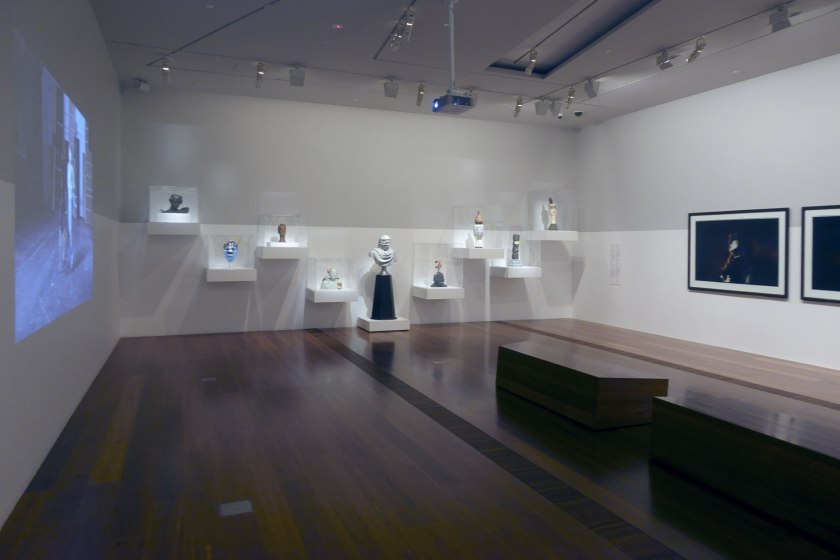
Installation view of the exhibition WHO ARE YOU: Australian Portraiture at NGV Australia, Federation Square, Melbourne
Photo: Marcus Bunyan

Ola Cohn (Australian, 1892-1964)
Lina (installation view)
1958
Earthenware
34.4 x 14.9 x 21.0cm
National Gallery of Victoria, Melbourne
Gift of Mrs Lina Bryans, 1969
© Centre for Adult Education & Box Hill Institute
Photo: Marcus Bunyan

Ola Cohn (Australian, 1892-1964)
Lina
1958
Earthenware
34.4 x 14.9 x 21.0cm
National Gallery of Victoria, Melbourne
Gift of Mrs Lina Bryans, 1969
© Centre for Adult Education & Box Hill Institute
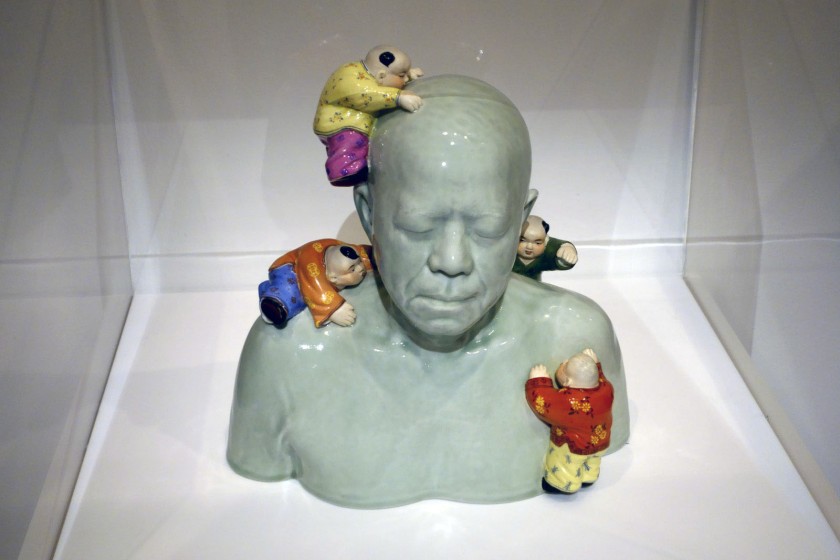
Ah Xian (Australian born China, b. 1960)
Dr John Yu (installation view)
2004
Glazed ceramic
42.0 x 42.0 depth 31.0cm
Commissioned with funds provided by Marilyn Darling AC 2004
Photo: Marcus Bunyan
Ah Xian came to Australia from Beijing in 1989, having already gained some recognition and experience as an artist here. His application for permanent residency took many years to process, and he worked for a long time as a house painter. He began casting porcelain busts and painting them with traditional Chinese designs in 1997; an artist-in-residency followed, he sold a bust to Sydney’s Powerhouse Museum, and he held his first solo show in Melbourne in 2000. The following year, he won the National Gallery of Australia’s inaugural National Sculpture Prize with his life-size painted cloisonne enamel figure Human human: “Human Human : Lotus Cloisonne Figure 1 (2000-2001)”.
Dr John Yu (b. 1934), retired paediatrician and hospital administrator, was born in Nanking, China and moved to Australia with his parents when he was three years old. Educated in Sydney, from 1961 he worked at the Royal Alexandra Hospital for Children (which became the New Children’s Hospital, Westmead), becoming Head of Medicine and serving as its Chief Executive for 19 years before retiring in 1997. For many years he chaired and served on diverse bodies related to children’s health, education, medicine and the arts. From 2004 he was Chair of VisAsia, promoting appreciation of Asian visual arts and culture. He has published a number of books and many papers on paediatrics, hospital management and the decorative arts. Accepting his Australian of the Year Award in 1996, Yu said, ‘I am proud of my Chinese heritage but even prouder to be an Australian’.
In his celadon bust, Ah Xian depicts Yu life-size with his eyes closed while four colourful miniature children clamber over him. In Chinese tradition, children indicate great prosperity and happiness. As Yu noted: ‘A lot of Chinese sculptures have young children climbing all over the subject. I was really pleased because it related to and reflected on my life work as a paediatrician.’
Text from the National Portrait Gallery, Canberra website updated 2018 [Online] Cited 28/06/2022
Ah Xian celebrates a once-threatened Chinese artisanal tradition of porcelain-ming and decoration. His portraits are a statement of creative freedom and his Chinese-Australian identity, which he shares with his sitter. The mould for this bust was cast in plaster from life – ‘a funny spooky feeling’ according to the subject, who was 1996 Australian of the Year, Dr John Yu. Yu observed of his portrait, ‘people might assume that the first thing that remains me of my heritage is my facial appearance. But it’s not. It’s actually the children … A lot of Chinese sculptures have young children climbing all over the subject. I was really pleased because it related to and reflected on my life work as a paediatrician’.
Wall text rom the exhibition

Ah Xian (Australian born China, b. 1960)
Dr John Yu
2004
Glazed ceramic
42.0 x 42.0 depth 31.0cm
Commissioned with funds provided by Marilyn Darling AC 2004
© Ah Xian

Ricardo Idagi (Australian / Meriam Mir, b. 1957)
False Evidence Appearing Real (installation view)
2012
Earthenware, under glaze, wood, steel, plastic and glassMeasurements
60.0 × 37.0 × 27.0cm
National Gallery of Victoria, Melbourne
Purchased, Victorian Foundation for Living Australian Artists, 2013
Photo: Marcus Bunyan

Brook Andrew (Australian, b. 1970)
I Split Your Gaze
1997, printed 2005
Gelatin silver photograph
National Gallery of Victoria, Melbourne
Purchased with funds from the Victorian Foundation for Living Australian Artists, 2005
‘I’ve cut the image in half and then reversed it so you can’t actually look at the person straight on. And I suppose that’s what racism is about. It’s about cutting racism down the centre. It’s about cutting differences down the centre. Neither part of the portrait in I split your gaze is whole and in being simultaneously halved and doubled the viewer is forced to stare blankly through the image, rather than making eye contact with the subject. Identity becomes mutable through repetition and we observe the man without really looking at him. The work operates as a metaphor for Australia as a society divided on issues concerning race relations.’ ~ Brook Andrew, 2005
Wall text from the exhibition
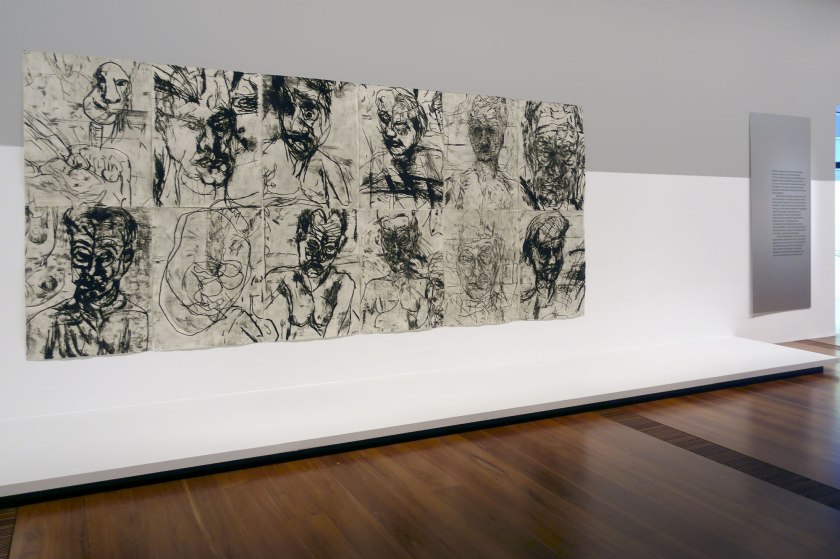
Mike Parr (Australian, b. 1945)
John Loane (printer) (Australian, b. 1950)
12 untitled self portraits (set 3) (installation view)
1990
Drypoint on 12 sheets of paper, unique state prints on paper
National Portrait Gallery, Canberra
Gift of Sara Kelly 2010. Donated through the Australian Government’s Cultural Gifts Program
Photo: Marcus Bunyan
In the early 1980s Mike Parr embarked no his ‘Self Portrait Project’, exploring representation of the psychological self. An artist who works across live performance, photography, works on paper, sculpture and installation, Parr said: ‘I am constantly finding ways to perform the alienation of likeness’. In this work, Parr’s self-image simultaneously coalesces and violently disintegrates across the drypoint plates. The work’s burrs – jagged edges where the needle has ripped through the metal – record the violence of the printing process. The butts hold more ink, creating the deep black lines and a ferocious visualisation of internal turmoil and chaos.
Wall text from the exhibition

Installation view of the exhibition WHO ARE YOU: Australian Portraiture at NGV Australia, Federation Square, Melbourne showing at centre, Peter Booth’s Painting (1977, below)
Photo: Marcus Bunyan
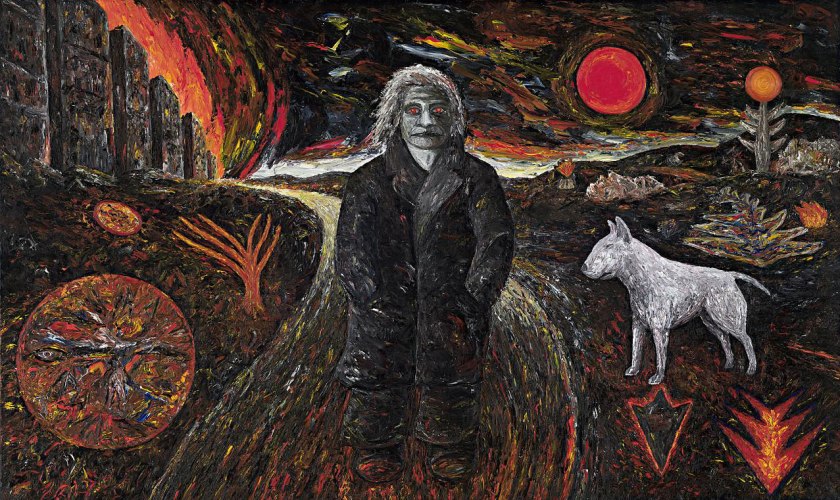
Peter Booth (Australian, b. 1940)
Painting
1977
Oil on canvas
182.5 × 304.0cm
National Gallery of Victoria, Melbourne
Gift of the artist in memory of Les Hawkins, 1978
© Peter Booth/Licensed by Copyright Agency, Australia

Installation view of the exhibition WHO ARE YOU: Australian Portraiture at NGV Australia, Federation Square, Melbourne showing at left, Selina Ou’s Anita ticket seller (2002m below); and at right, Peter Booth’s Painting (1977, above)
Photo: Marcus Bunyan
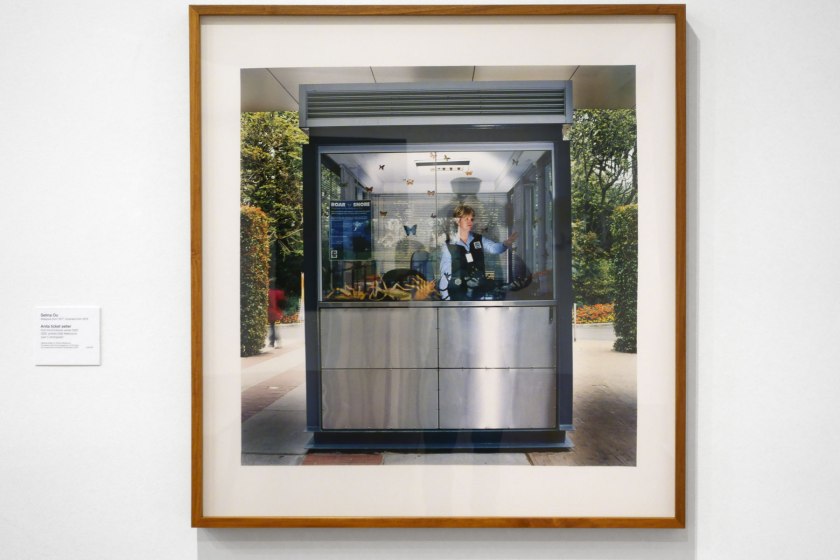
Selina Ou (Australian born Malaysia, b. 1977)
Anita ticket seller
2002, printed 2005
From the Enclosure series 2002
type C photograph
Image: 100.6 × 99.3cm irreg.
Sheet: 126.6 × 119.3cm
National Gallery of Victoria, Melbourne
Purchased with funds arranged by Loti Smorgon for Contemporary Australian Photography, 2005
© Selina Ou, represented by Sophie Gannon Gallery, Melbourne
Photo: Marcus Bunyan

Installation view of the exhibition WHO ARE YOU: Australian Portraiture at NGV Australia, Federation Square, Melbourne showing at second left, Petrina Hicks‘ Lauren (2003, below); at third right, Christian Waller‘s Destiny (1916, below); at second right, Charles Dennington‘s Adut Akech (2018, below); and at right, Tony Kearney‘s Gill Hicks (2016, below)
Photo: Marcus Bunyan

Petrina Hicks (Australian, b. 1972)
Lauren
2003
From the Lauren series 2003
Lightjet photograph
152.7 x 127.0cm (image and sheet)
National Gallery of Victoria, Melbourne
Purchased with funds arranged by Loti Smorgon for Contemporary Australian Photography, 2006
© Petrina Hicks. Courtesy of Michael Reid, Sydney; and This Is No Fantasy, Melbourne
In this series, Petrina Hicks draws on the tension between perfection and imperfection, the ideal and the real. The model, Lauren, has a look of serenity and otherworldliness – her pale skin, white hair and angelic pose are suggestive of a sculptural marble bust. However, what appears to be a picture of absolute perfection, is a skilfully manipulated image using complex studio lighting and digital technologies, techniques common to glamour and celebrity portraiture that subtly manipulate and remove physical imperfections. The result is a face that appears both fundamentally ‘real’ yet with a flawless quality, resulting in an uncanny and eerie element to the work.
Wall text from the exhibition
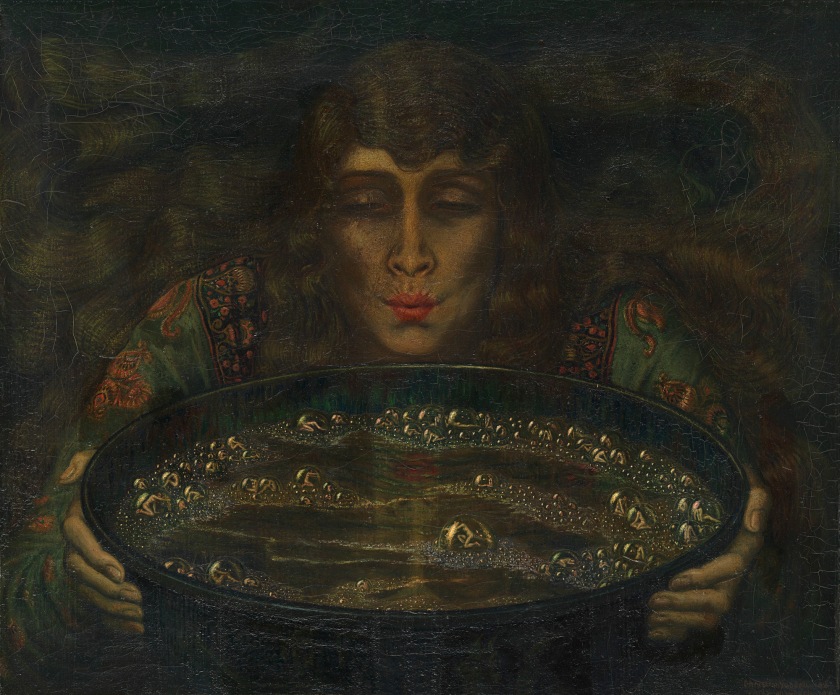
Christian Waller (Australian, 1894-1954)
Destiny
1916
Oil on canvas
National Gallery of Victoria, Melbourne
Purchased with funds donated from the Estate of Ouida Marston, 2011
Destiny, personified by a female figure, blows gently into a large bowl of water in which can be seen hundreds of tiny need figures floating within fragile bubbles. An allegory of unpredictable foreign, Destiny would have had a particular relevance in the early years of the First World War, a time when Australians were becoming aware of the scale of loss of life the war would bring. Painted in 1916 soon after the artist’s marriage to Napier Waller in late 1915, and in the same years that Waller left for active service in France, Destiny may also have had more personal associations for the artist.
Wall text from the exhibition

Charles Dennington (Australian, b. 1982)
Adut Akech (installation view)
2018, printed 2020
Inkjet print on paper
Image: 94.9 x 71.3cm
Sheet: 111.2 x 80cm
Gift of the artist 2020
© Charles Dennington
Photo: Marcus Bunyan

Charles Dennington (Australian, b. 1982)
Adut Akech
2018, printed 2020
Inkjet print on paper
Image: 94.9x 71.3cm
Sheet: 111.2 x 80cm
Gift of the artist 2020
© Charles Dennington
Adut Akech Bior (b. 1999), supermodel, was born in South Sudan and spent the first several years of her life in the UN’s Kakuma refugee camp in north-west Kenya, after her family fled from civil war. They came to Australia in 2008 and settled in Adelaide. Her break-out modelling assignment came at the age of sixteen, when she walked the runway for Yves Saint Laurent at Paris Fashion Week 2016. In 2017, she became only the second woman of colour to model bridal gowns for Chanel. The following year she featured in the Pirelli calendar, and made 33 appearances at Paris Fashion Week. She was selected by the Duchess of Sussex to feature in British Vogue’s ‘Forces for Change’ edition in 2019, which profiled her activism on humanitarian issues, the rights of asylum seekers, and racial and gender equality.
Charles Dennington’s portrait of Akech was originally taken for the December 2018 issue of Vogue Australia. Dennington discussed plans for the shoot with Akech in advance, giving him a deeper insight into the model’s personal life. This conceptual portrait is one of a group of images that present a funky and upbeat glimpse of the Sudanese-Australian model and her family at home in Adelaide.
Text from the National Portrait Gallery, Canberra website Nd [Online] Cited 28/06/2022

Tony Kearney (Australian, b. 1958)
Gill Hicks
2016
Inkjet print on paper, edition 1/5
Image: 129.3 cm x 101.5cm
Sheet: 138.0 cm x 110.0cm
Purchased 2016
© Tony Kearney
Gill Hicks AM MBE (b. 1968) is a peace advocate, author, musician and artist. Having grown up in Adelaide, she moved to London in 1991 and worked as publishing director for architectural magazine Blueprint and as a senior curator with the Design Council. On 7 July 2005 Hicks set out for work as usual; within hours, she was the last living casualty rescued from one of three Underground trains attacked by terrorists in the ‘7/7’ London bombings. Having lost 80 per cent of her blood, she was not expected to live. Both her legs were amputated below the knee. As soon as she was able to walk on prosthetics, Hicks visited Beeston, where three of the bombers had come from, and met members of their community, who embraced her. She returned to Adelaide in 2012, where she has continued her work within the arts, launching a studio and online business, M.A.D Minds.
Tony Kearney took this photograph of Hicks in a dark basement in one of Port Adelaide’s old woolstores. Although she was in pain, Kearney notes: ‘We worked together for more than two hours, Gill uncomplaining and cheerful. Sometimes she would need to sit absolutely still for up to sixteen seconds in order to achieve the right exposure.’
Text from the National Portrait Gallery, Canberra website Nd [Online] Cited 28/06/2022
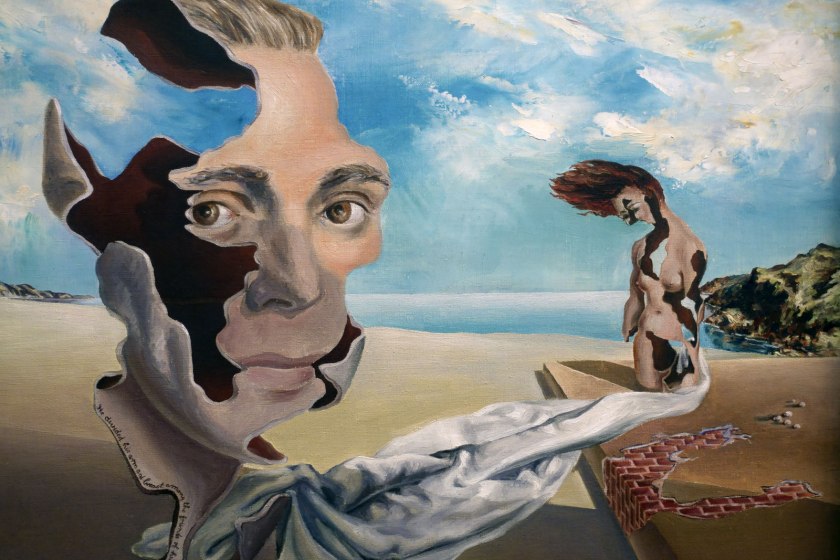
James Gleeson (Australian, 1915-2008)
We inhabit the corrosive littoral of habit (installation detail)
1940
Oil on canvas
National Gallery of Victoria, Melbourne
Anonymous gift, 1941
Photo: Marcus Bunyan
As an artist, writer and curator, James Gleeson was a key exponent of Surrealism in Australia. In 1937 he studied at Sydney Teachers’ College where he encountered the psychoanalytical theory of Sigmund Freud, and developed an interest in the art and literature of European artists associated with the Dada and Surrealist movements. He produced his first Surrealist paintings and poem-drawings soon after, in 1938. Although his style and subject matter continued to transform, Gleeson was committed to Surrealism throughout his sixty-year career and unsettling, dreamlike imagery remained a consistent thread in his work.
Wall text from the exhibition

Del Kathryn Barton (Australian, b. 1972)
inside another land 13 (installation view)
2017
Synthetic polymer paint on inkjet print
National Gallery of Victoria, Melbourne
Purchased, Victorian Foundation for Living Australian Artists, 2018
Photo: Marcus Bunyan
In this montage, Del Kathryn Barton creates post-human imagery where the female body is both human and plant. Artists belonging to the early twentieth century art movement Dadaism used collage to access the Freudian domain of the unconscious mind, and the great Dada artist Hannah Höch was a key proponent of photomontage in her exploration of the role of women in a changing world. Similarly, Barton uses collage to critique the illusion of an orderly world, in favour of absurdity. The visual delirium induces a kind of hallucinatory experience in which new creatures seem possible. In part, Barton incorporates imagery of the flower as a widely understood symbol of female sexuality: their physical resemblance to women’s genitalia is coupled with an associate significance in their blooming, invoking the creation of new life.
Wall text from the exhibition

Del Kathryn Barton (Australian, b. 1972)
inside another land 13
2017
Synthetic polymer paint on inkjet print
National Gallery of Victoria, Melbourne
Purchased, Victorian Foundation for Living Australian Artists, 2018

Rona Panangka Rubuntja (Australian / Arrente, b. 1970)
I’m black (Nicky Winmar), covered vase (installation view)
2015
Earthenware
(a-b) 53.1 x 24.8cm diameter (overall)
National Gallery of Victoria, Melbourne
Purchased, Victorian Foundation for Living Australian Artists, 2015
© Rona Panangka Rubuntja/Licensed by Copyright Agency, Australia
Photo: Marcus Bunyan
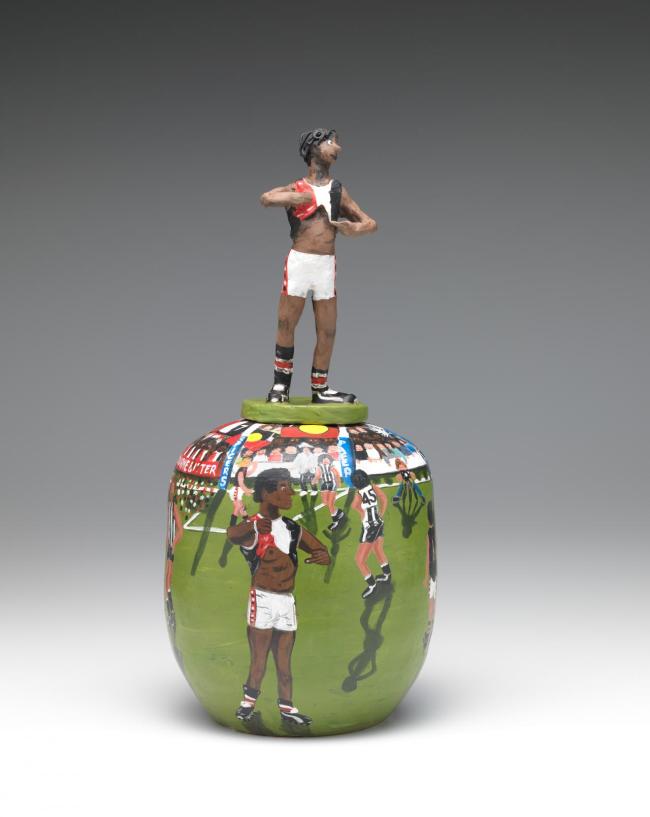
Rona Panangka Rubuntja (Australian / Arrente, b. 1970)
I’m black (Nicky Winmar), covered vase
2015
Earthenware
(a-b) 53.1 x 24.8cm diameter (overall)
National Gallery of Victoria, Melbourne
Purchased, Victorian Foundation for Living Australian Artists, 2015
© Rona Panangka Rubuntja/Licensed by Copyright Agency, Australia
Rona Panangka Rubuntja joined the Hermannsberg Potters in 1988 and has since established herself as a prominent ceramic artist. This work celebrates legendary AFL star Nicky Winmar, who in 1993 defiantly protested racial taunts by pointing to his skin colour. Winner’s action held widespread attention across Australian media and called to action the ongoing issues of racism in Australian sport. As the artist recalls, ‘I remember when Nicky Winmar lifted his shirt to show that he was black. We will always support Nicky Winmar’.
Wall text from the exhibition
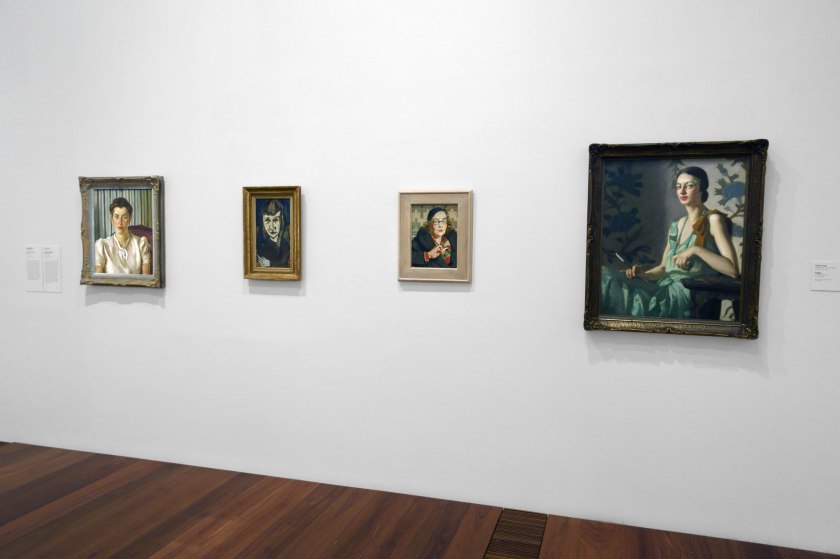
Installation view of the exhibition WHO ARE YOU: Australian Portraiture at NGV Australia, Federation Square, Melbourne showing at left, Adelaide Perry‘s Rachel Roxburgh (1939, below); at second left, Joy Hester‘s Pauline McCarthy (1945, below); at second right, Sybil Craig‘s Peggy (c. 1932, below); and at right, Constance Stokes‘ Portrait of a woman in a green dress (1930, below)
Photo: Marcus Bunyan
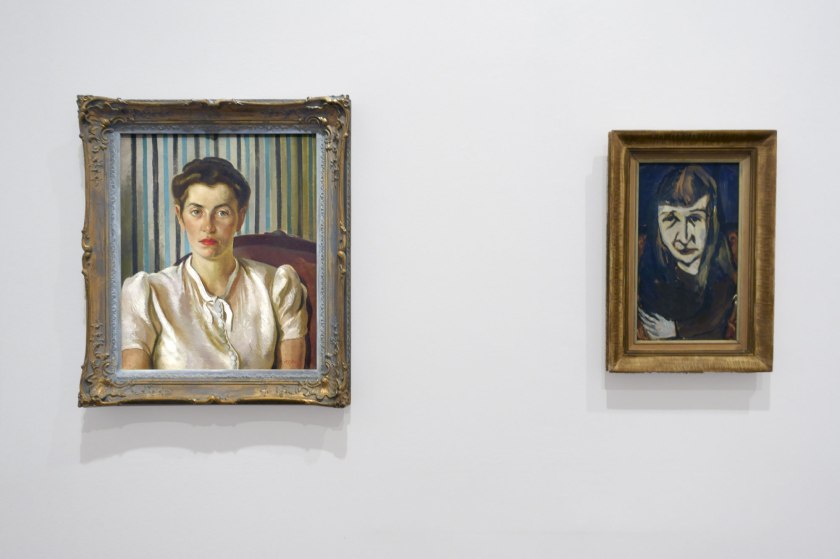
Installation view of the exhibition WHO ARE YOU: Australian Portraiture at NGV Australia, Federation Square, Melbourne showing at left, Adelaide Perry‘s Rachel Roxburgh (1939, below); at second left, Joy Hester‘s Pauline McCarthy (1945, below)
Photo: Marcus Bunyan

Adelaide Perry (Australian 1891-1973)
Rachel Roxburgh
1939
Oil on canvas
Frame: 77.0 cm x 67.0cm
National Portrait Gallery, Canberra
Purchased 2018
Adelaide Perry held her first solo exhibition in Sydney in 1927, when she was described by Art in Australia magazine as ‘better equipped perhaps than any of the artist of her generation in this country’. The recipient, in 1920, of the National Gallery of Victoria Travelling Scholarship, Perry had studied in Paris and at the Royal Academy Schools, and became a founding member of the Contemporary Group after settling in Sydney in 1926. In 1933 she established the Adelaide Perry School of Art. Artist and conservationist Rachel Roxburgh studies there and, like Perry, exhibited with the Society of Artists, the Contemporary Group and at the Macquarie Galleries in the 1930s.
Wall text from the exhibition
Rachel Roxburgh BEM (1915-1991), artist, educator, conservationist, and heritage campaigner, was born in Sydney and studied at East Sydney Technical College and the Adelaide Perry Art School in the early 1930s. Subsequently, she exhibited with the Contemporary Group, the Society of Artists and at the Macquarie Galleries, and in 1940 organised an exhibition in aid of the Sydney Artists’ and Journalists’ Fund. During World War II she joined a Voluntary Aid Detachment and qualified as a nurse at Sydney Hospital. After the war she spent time in Europe, furthering her studies at the London Central and Hammersmith Art Schools and travelling and sketching in France, Italy, Spain and south-west England. She held her first solo exhibition after returning to Sydney in 1956 and the same year became a member of the newly-formed Potters Society with whom she also exhibited. During the same period she joined the National Trust of Australia (NSW), later becoming a member of its council (1961-1976) and executive (1961-1963). She also served on the Trust’s women’s committee and as a member of the survey committee worked to identify and classify the colonial architectural heritage of New South Wales. A school art teacher for over twenty years, Roxburgh also wrote several articles and books on colonial Australian architecture.
Text from the National Portrait Gallery, Canberra website Nd [Online] Cited 28/06/2022

Joy Hester (Australian, 1920-1960)
Pauline McCarthy
1945
Oil on cardboard
45.7 x 26.0cm
National Gallery of Victoria, Melbourne
June Sherwood Bequest, 2021
© Joy Hester Estate/Licensed by Copyright Agency, Australia
Joy Hester is known for her distinctive style of portraiture, charged with great emotion and dramatic feeling. Hester’s preferred techniques were drawing and brush and ink, and this portrait of Pauline McCarthy is a rare painting in oils by the artist. From 1938 until 1947 Hester was part of the circle of artists now known as the Angry Penguins and was associated with the group who gathered at the home of Sunday and John Reed. Hester was also a regular visitor to Pauline and Jack McCarthy’s Fitzroy bookshop and private lending library, Kismet. When Hester was diagnosed with Hodgkin’s disease at the age of twenty-seven, McCarthy provided her with both emotional and physical support. Hester died from the illness at forty years of age.
Wall text from the exhibition

Sybil Craig (England 1901 – Australia 1909, Australia from 1902)
Peggy
c. 1932
Oil on canvas
40.4 x 30.4cm
National Gallery of Victoria, Melbourne Purchased, 1978
© The Estate of Sybil Craig

Constance Stokes (Australian, 1906-1991)
Portrait of a woman in a green dress (installation view)
1930
Oil on canvas
National Gallery of Victoria, Melbourne
Bequest of Michael Niall, 2019
Photo: Marcus Bunyan

Installation view of the exhibition WHO ARE YOU: Australian Portraiture at NGV Australia, Federation Square, Melbourne showing at second left, Polly Borland’s HM Queen Elizabeth II (2002, below); at second right, Atong Atem’s Adut (2015, below); and at right, Treahna Hamm’s Barmah Forest breastplate (2005)
Photo: Marcus Bunyan

Polly Borland (Australia, b. 1959, England 1989-2011, United States from 2011)
HM Queen Elizabeth II
2002
Type C photograph on paper
National Portrait Gallery, Canberra
Purchased, 2002
© Polly Borland. Reproduced courtesy of Polly Borland and Anna Schwartz Gallery

Atong Atem (South Sudanese born Ethiopia, b. 1994)
Adut
2015, printed 2019
From the Studio series 2015
Digital type C print
Image: 59.4 x 84.1cm
Sheet: 63.6 x 92.7cm
ed. 3/10
National Gallery of Victoria, Melbourne
Purchased, Victorian Foundation for Living Australian Artists, 2019
© Atong Atem, courtesy Mars Gallery, Melbourne
‘The Studio series … has developed into an exploration of my blackness and my identity and culture through African cultural iconography, black visual languages, and diasporic traditions represented in the act of posing for a photograph. The photos are traditional, staged studio photographs similar to those found in my family albums and the photo albums of many people in the diaspora – they’re bright, colourful and depict a very precarious moment in African history between traditionalism and cultural changes brought on by colonialism … This Studio series responds to the ethnographic gaze of colonial photographs of black people and speaks to the importance of creating and owning one’s own narrative and depictions.’ ~ Atong Atem, 2019
Wall text from the exhibition


Vincent Namatjira (Australian / Anangu Pitjantjatjara Yankunytjatjara, b. 1983)
Australia in black and white (installation views)
2018
Ink on paper
(a-p) 56.0 x 38.0cm (each)
National Gallery of Victoria, Melbourne
Purchased, Victorian Foundation for Living Australian Artists, 2019
© Vincent Namatjira/Copyright Agency, Australia
Photos: Marcus Bunyan
I’m interested in people and their stories, and how someone from today is connected with the past. I like to paint people who are famous, and paint them here in my community. Painting them in the desert puts them into an unexpected place. Having just a little bit of humour can take the power out of a serious situation, whether something is happening to you right now, or it happened long ago – it lets you be in a little bit of control again, you can get a bit of cheeky revenge. A sense of humour and a paintbrush is a powerful thing.’ ~ Vincent Namatjira
Wall text from the exhibition

Vincent Namatjira (Australian / Anangu Pitjantjatjara Yankunytjatjara, b. 1983)
Australia in black and white (detail)
2018
Ink on paper
(a-p) 56.0 x 38.0cm (each)
National Gallery of Victoria, Melbourne
Purchased, Victorian Foundation for Living Australian Artists, 2019
© Vincent Namatjira/Copyright Agency, Australia
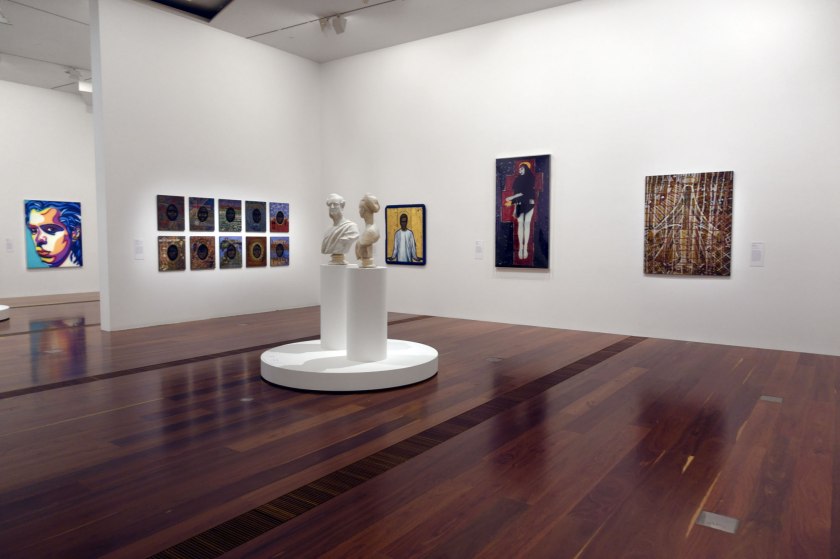
Installation view of the exhibition WHO ARE YOU: Australian Portraiture at NGV Australia, Federation Square, Melbourne showing centre on the pedestal, Charles Summers’ Edmund FitzGibbon and Sarah FitzGibbon (1877); at left, Howard Arkley’s Nick Cave (1999, below); at second left, Julie Dowling’s Federation 1901-2001 series (2001, below and at second right, Julie Rrap’s Persona and shadow: Madonna (1984, below)
Photo: Marcus Bunyan
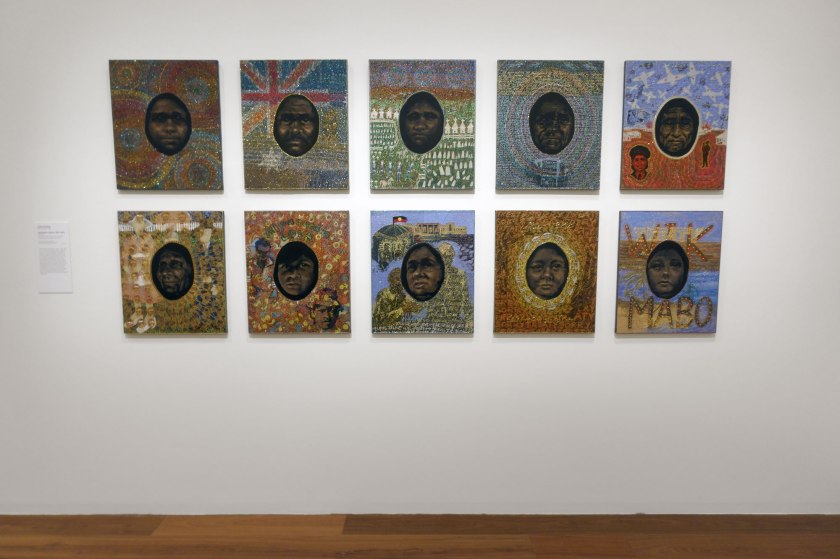
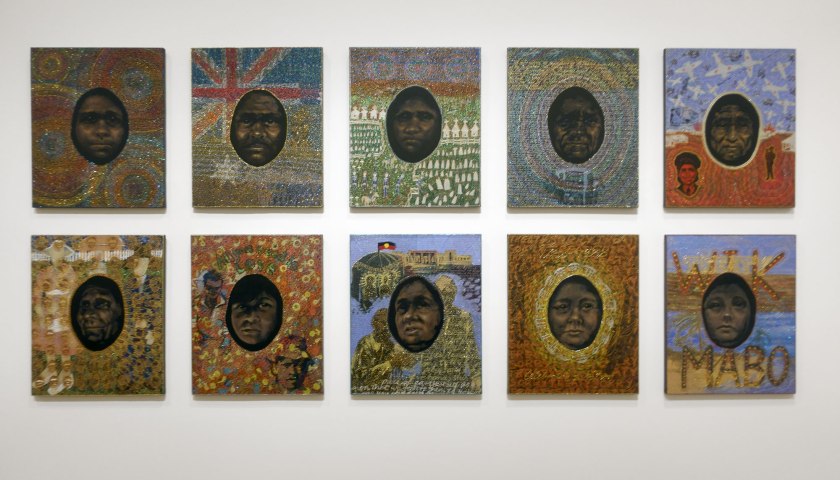
Julie Dowling (Australian / Badimaya, b. 1969)
Federation series: 1901-2001 (installation views)
2001
synthetic polymer paint, earth pigments, metallic paint and glitter on canvas
(1) 60.3 × 50.5cm (Melbin 1901-1910)
(2) 60.4 × 50.5cm (Uncle Sam 1910-1920)
(3) 60.2 × 50.4cm (Auntie Dot 1920-1930)
(4) 60.3 × 50.5cm (Ruby 1930-1940)
(5) 60.2 × 50.5cm (Mollie 1940-1950)
(6) 60.4 × 50.5cm (George 1950-1960)
(7) 60.3 × 50.4cm (Nan 1960-1970)
(8) 60.3 × 50.4cm (Ronnie 1970-1980)
(9) 60.4 × 50.5cm (Carol 1980-1990)
(10) 60.4 × 50.5cm (Julie 1990-2001)
National Gallery of Victoria, Melbourne
Purchased through the NGV Foundation with the assistance of Rupert Myer, Governor, 2001
© Julie Dowling/Licensed by Copyright Agency, Australia
Photos: Marcus Bunyan
Julie Dowling’s Federation series: 1901-2001 is a series of history paintings produced in response to the Centenary of Federation. The work registers Dowling’s dismay that the Australian Constitution did not included First Nations people when the country was declared a Federation. The narrative cycle of ten canvases, each symbolising a particular diva, presents a profound and multidimensional First Peoples history of the twentieth century. Like a family tree of resilience, the series portrays the faces of ten individual members of Dowling’s family, each affected by policies and events of history.
Wall text from the exhibition
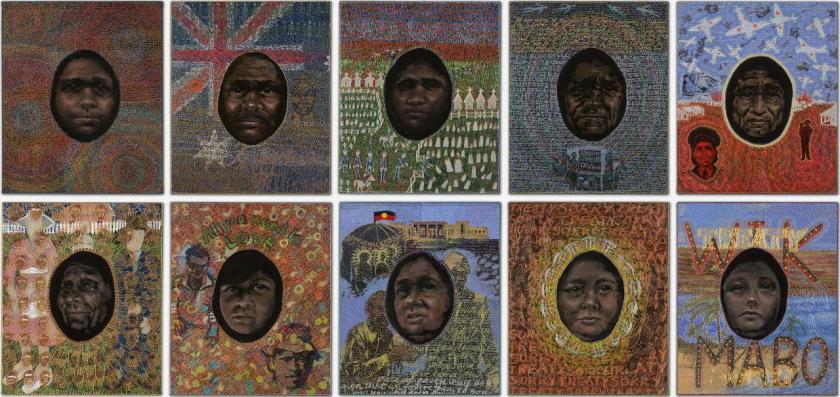
Julie Dowling (Australian / Badimaya, b. 1969)
Federation series: 1901-2001
2001
synthetic polymer paint, earth pigments, metallic paint and glitter on canvas
(1) 60.3 × 50.5cm (Melbin 1901-1910)
(2) 60.4 × 50.5cm (Uncle Sam 1910-1920)
(3) 60.2 × 50.4cm (Auntie Dot 1920-1930)
(4) 60.3 × 50.5cm (Ruby 1930-1940)
(5) 60.2 × 50.5cm (Mollie 1940-1950)
(6) 60.4 × 50.5cm (George 1950-1960)
(7) 60.3 × 50.4cm (Nan 1960-1970)
(8) 60.3 × 50.4cm (Ronnie 1970-1980)
(9) 60.4 × 50.5cm (Carol 1980-1990)
(10) 60.4 × 50.5cm (Julie 1990-2001)
National Gallery of Victoria, Melbourne
Purchased through the NGV Foundation with the assistance of Rupert Myer, Governor, 2001
© Julie Dowling/Licensed by Copyright Agency, Australia

Julie Dowling (Australian / Badimaya, b. 1969)
Julie
2001
From the Federation series: 1901-2001 2001
synthetic polymer paint, earth pigments, metallic paint and glitter on canvas
60.4 × 50.5cm
National Gallery of Victoria, Melbourne
Purchased through the NGV Foundation with the assistance of Rupert Myer, Governor, 2001
© Julie Dowling/Licensed by Copyright Agency, Australia

Julie Dowling (Australian / Badimaya, b. 1969)
Nan (detail)
2001
From the Federation series: 1901-2001 2001
synthetic polymer paint, earth pigments, metallic paint and glitter on canvas
60.4 × 50.5cm
National Gallery of Victoria, Melbourne
Purchased through the NGV Foundation with the assistance of Rupert Myer, Governor, 2001
© Julie Dowling/Licensed by Copyright Agency, Australia
Photo: Marcus Bunyan

Installation view of the exhibition WHO ARE YOU: Australian Portraiture at NGV Australia, Federation Square, Melbourne showing at second left, Brenda L. Croft‘s Matilda (Ngambri) (2020, below); at third right, William Buelow Gould‘s John Eason (1838); at second right, Augustus Earle‘s Captain Richard Brooks (1826-1827); and at right, Augustus Earle‘s Mrs Richard Brooks (1826-1827)
Photo: Marcus Bunyan

Brenda L. Croft (Anglo-Australian / Gurindji/Malngin/Mudburra, b. 1964)
Prue Hazelgrove (wet plate collodion process technical assistant)
Richard Crampton (printer)
Matilda (Ngambri) (installation view detail)
2020
From the Naabami (Thou shall/will see): I am/we are Barangaroo series
Inkjet print (from original tintype, wet plate collodion process) on archival paper, ed. 4/5 + 3 A/P
Image: 119.7 x 90.9cm
Sheet: 140.3 x 99.9cm
National Portrait Gallery, Canberra
Purchased with funds provided by The Calvert-Jones Foundation 2020
© Brenda L. Croft/Copyright Agency, 2022
Photo: Marcus Bunyan
Ngambri woman, Dr Matilda House, is an activist who has dedicated her life to the pursuit of social justice and equity for First Nations peoples since the 1960s. Dr House is renowned for her work in establishing the Aboriginal Legal Service in Queanbeyan and her ongoing support for the Aboriginal Tent Embassy. Using a photographic technique known as a collodion wet plate process, Dr Brenda L. Croft created a powerful series honouring the spirit of Cammeraygal woman, Barangaroo (c. 1750-1791) – one of the Eora Nations earliest influential figures. This portrait of Dr House forms part of the suite, and like Barangaroo, her resilience, cultural authority and fiercely held connection to place continues to inspire many contemporary First Nations women.
Wall text from the exhibition

Brenda L. Croft (Anglo-Australian / Gurindji/Malngin/Mudburra, b. 1964)
Prue Hazelgrove (wet plate collodion process technical assistant)
Richard Crampton (printer)
Matilda (Ngambri)
2020
From the Naabami (Thou shall/will see): I am/we are Barangaroo series
Inkjet print (from original tintype, wet plate collodion process) on archival paper, ed. 4/5 + 3 A/P
Image: 119.7 x 90.9cm
Sheet: 140.3 x 99.9cm
National Portrait Gallery, Canberra
Purchased with funds provided by The Calvert-Jones Foundation 2020
© Brenda L. Croft/Copyright Agency, 2022
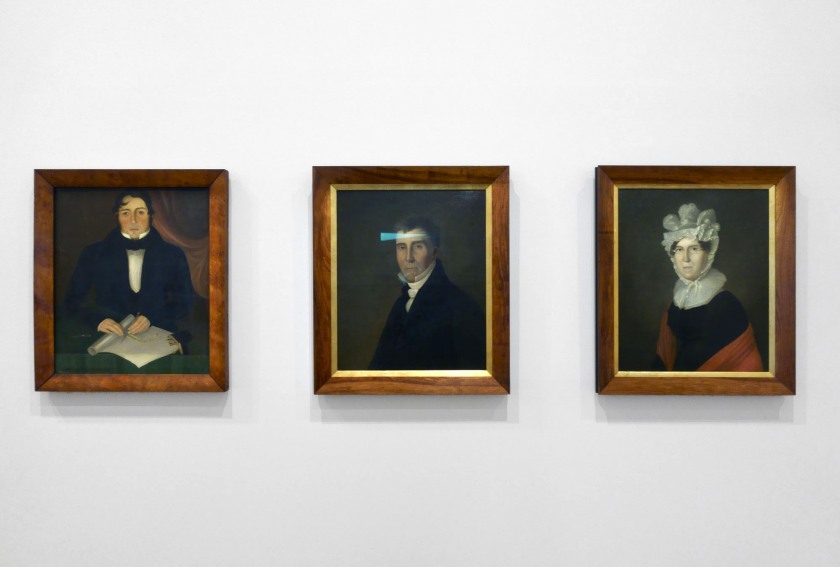
Installation view of the exhibition WHO ARE YOU: Australian Portraiture at NGV Australia, Federation Square, Melbourne showing at left, William Buelow Gould‘s John Eason (1838); at centre, Augustus Earle‘s Captain Richard Brooks (1826-1827); and at right, Augustus Earle‘s Mrs Richard Brooks (1826-1827)
Photo: Marcus Bunyan
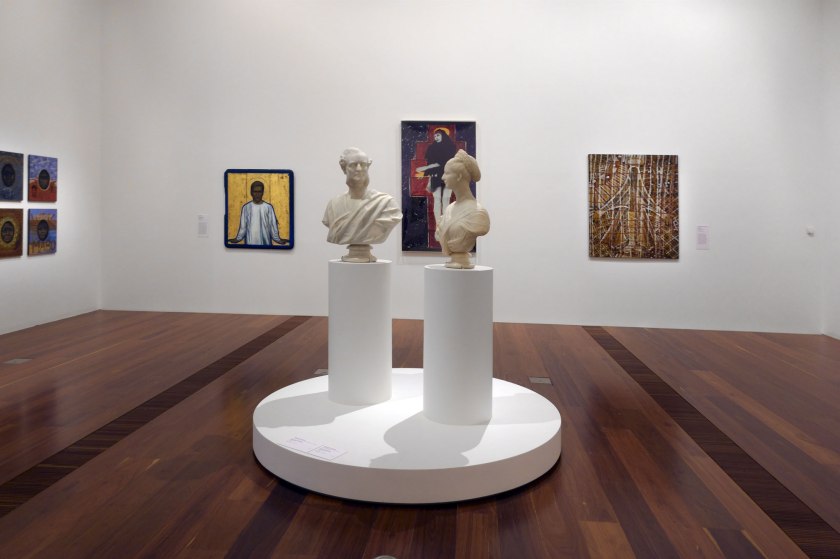
Installation view of the exhibition WHO ARE YOU: Australian Portraiture at NGV Australia, Federation Square, Melbourne showing at second left background, AñA Wojak‘s Acacius (Stigmata) – Tony Carden (1991, below); at centre background, Julie Rrap‘s Persona and shadow: Madonna (1984, below); and at centre on pedestal, Charles Summers‘ Edmund FitzGibbon and Sarah FitzGibbon (1877)
Photo: Marcus Bunyan
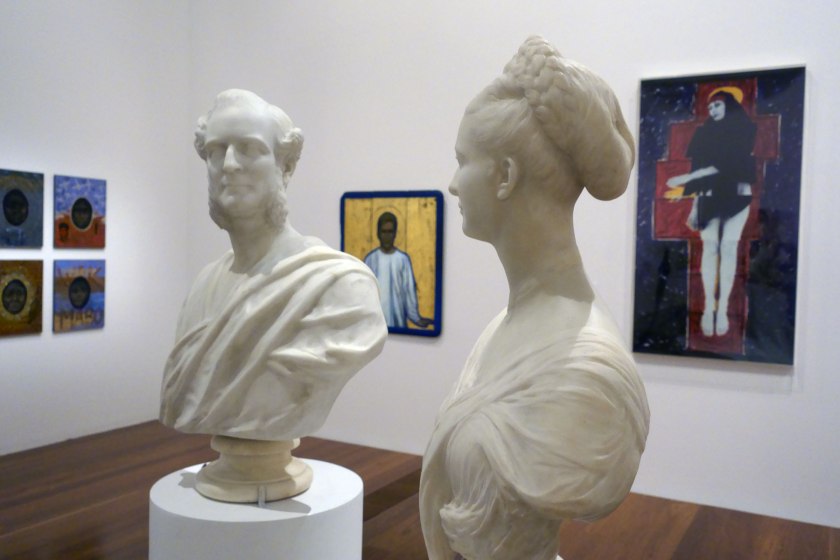
Installation view of the exhibition WHO ARE YOU: Australian Portraiture at NGV Australia, Federation Square, Melbourne showing at centre on pedestal, Charles Summers‘ Edmund FitzGibbon and Sarah FitzGibbon (1877); at centre background, AñA Wojak‘s Acacius (Stigmata) – Tony Carden (1991, below); and at right, Julie Rrap‘s Persona and shadow: Madonna (1984, below)
Photo: Marcus Bunyan

AñA Wojak (Australian, b. 1954)
Acacius (Stigmata) – Tony Carden (installation view)
1991
Oil and gold leaf on cedar panel
Support: 121.5 x 103.0cm
Gift of Lesley Saddington 2015
© AñA Wojak
Photo: Marcus Bunyan
AñA Wojak describes themselves as a ‘cross-disciplinary artist working in performance, painting, assemblage, installation and theatre design, with a particular interest in site-specificity, ritual and altered states’. Born in Australia, they studied in Gdansk, Poland in the period of martial law, attaining a master’s degree in fine arts in 1983. Wojak has been an Archibald finalist twice, a Portia Geach finalist several times and a Sculpture by the Sea finalist four times; they won the Blake Prize for religious art in 2004.
Anthony Carden (1961-1995), activist, studied acting in New York in the early 1980s before returning home to work in theatre, film and television in Sydney and Melbourne. After being diagnosed with AIDS, he joined ACTUP (AIDS Coalition to Unleash Power) and became a lobbyist for better standards of medical care, improved hospital facilities, and effective safe sex education. An activist against discrimination in all its forms, he was a prominent advocate for people living with HIV/AIDS. With Clover Moore, then the Member for Bligh in the New South Wales Legislative Assembly, he helped raise $1 million for the refurbishment of St Vincent’s Hospital’s Ward 17 South, Australia’s first dedicated ward for HIV/AIDS patients. He died five years after his diagnosis.
AñA Wojak met Carden at an ACTUP meeting in 1991, at which time the artist had begun working on a series exploring ideas of sainthood and martyrdom. Wojak painted Carden in the guise of Saint Acacius, an early Christian martyr, as he was ‘someone who was working for the rights of others whilst at the same time suffering himself’. Employing gold leaf and a blue paint derived from lapis lazuli, the work is intended to evoke Byzantine icons and Italian Renaissance altarpieces. The portrait was displayed in Don’t Leave Me This Way: Art in the Age of AIDS at the National Gallery of Australia in 1994-1995; at Carden’s wake; and later in Ward 17 South before being purchased by Carden’s mother, Lesley Saddington.
Text from the National Portrait Gallery, Canberra website Nd updated 2021 [Online] Cited 02/07/2022

AñA Wojak (Australian, b. 1954)
Acacius (Stigmata) – Tony Carden
1991
Oil and gold leaf on cedar panel
Support: 121.5 x 103.0cm
Gift of Lesley Saddington 2015
© AñA Wojak
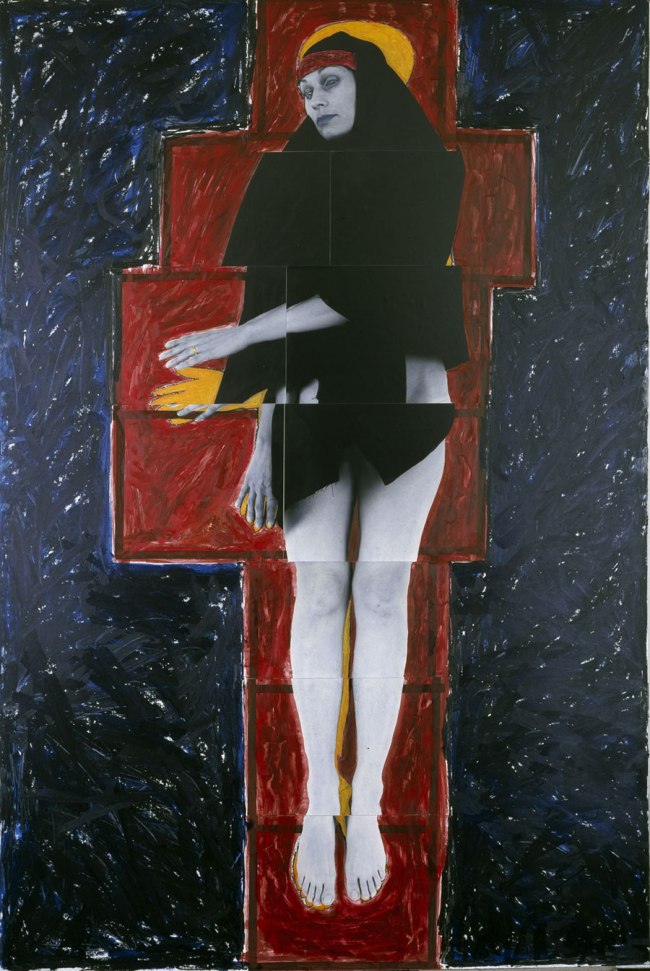
Julie Rrap (Australian, b. 1950)
Persona and shadow: Madonna
1984
Cibachrome photograph
Image and sheet: 194.7 × 104.6cm
National Gallery of Victoria, Melbourne
Michell Endowment, 1984
© Julie Rrap
Julie Rrap dissects and subverts conventional visions of women in art history, so often depicted as ‘the Madonna’. This work is from a series called Persona and Shadow in which Rrap responded to her experience of seeing so few women artists represented in major contemporary art shows in Europe during the early 1980s. Rap takes outlines from work by Edvard Munch and incorporates a fractured photographic self-portrait. Her resulting vision personally and powerfully counters the dominant narrative of women in the art world.
Wall text from the exhibition
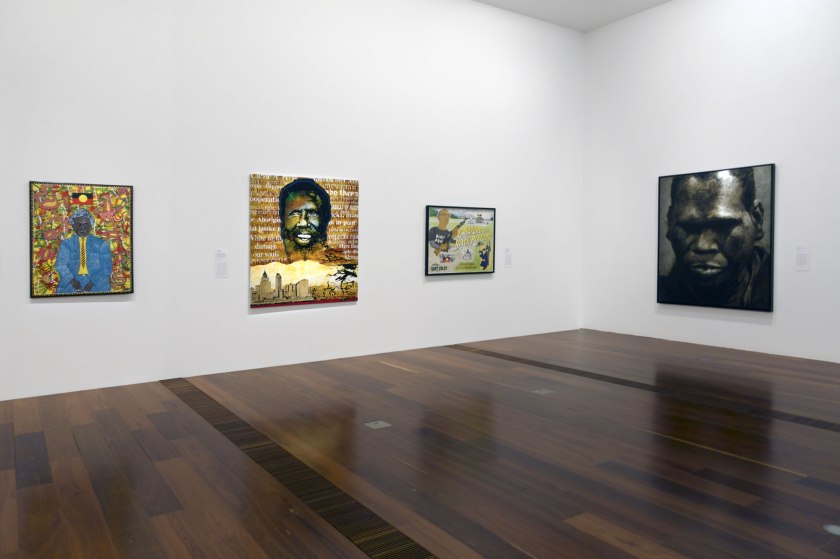
Installation view of the exhibition WHO ARE YOU: Australian Portraiture at NGV Australia, Federation Square, Melbourne showing at second left, John Citizen’s Eddie Mabo (after Mike Kelley’s ‘Booth’s Puddle’ 1985, from Plato’s Cave, Rothko’s Chapel, Lincoln’s Profile) No. 3 (1996, below); at third right, TextaQueen’s Creature from the Black Platoon starring Gary Foley 2011 (2011, below); and at right, Guido Maestri’s Geoffrey Gurrumul Yunupingu (2009, below)
Photo: Marcus Bunyan

John Citizen (Gordon Bennett, Australian 1955-2014)
Eddie Mabo (after Mike Kelley’s ‘Booth’s Puddle’ 1985, from Plato’s Cave, Rothko’s Chapel, Lincoln’s Profile) No. 3 (installation view)
1996
Synthetic polymer paint on canvas
Support: 168.0 x 152.5cm
Purchased with funds provided by L Gordon Darling AC CMG 1999
© Gordon Bennett Estate
Photo: Marcus Bunyan
John Citizen is the artistic alter ego of Australian artist Gordon Bennett (1955-2014), painter and multi-media artist, addressed issues of identity and power in a postcolonial context. Within two years of graduating from the Queensland College of Art in 1988 he was awarded the prestigious Moët and Chandon Fellowship. He had numerous solo exhibitions and was represented in many travelling exhibitions within Australia and overseas. Of indigenous Australian and Anglo-Celtic descent, he was concerned with the use of language in delineating ethnocentric boundaries, viewing his work as ‘history painting’ in that it indicated the ways in which history is constructed after the event. Bennett is represented under both John Citizen and Gordon Bennett in many state, regional and tertiary collections.
Koiki (Eddie) Mabo (1937-1992), Torres Strait Islander man, initiated a legal case for native title against the State of Queensland in 1982. Along with his fellow Meriam people, Mabo was convinced that he owned his family’s land on Murray Island (Mer) in Torres Strait. By contrast, Queensland Crown lawyers argued that on annexation in 1879, all the land had become the property of the Crown. In 1992, the seven Justices of the High Court found 6-1 in favour of Mabo and his co-plaintiffs, overturning the accepted view that Australia had been terra nullius (empty land) before white settlement. Mabo died before the historic decision, which was to lead to the Land Title Act of 1993, and permanently to alter the way Australians think about Aboriginal land ownership.
John Citizen is the artistic alter ego of Australian artist Gordon Bennett (1955-2014). Bennett, who worked under his own name and that of John Citizen, grew up in Nambour, Queensland and only learned of his mother’s Indigenous heritage in his early teens. He went to art school as a mature student. Stating early in his career that ‘the bottom line of my work is coming to terms with my Aboriginality,’ he continued to engage with questions of cultural and personal identity, interrogating Australia’s colonial past and postcolonial present through a succession of allusive postmodern works. He won the John McCaughey Memorial Art Prize of the National Gallery of Victoria in 1997, and the NGV mounted a touring exhibition, Gordon Bennett, in 2007-2008. Bennett said that when he began to think about Eddie Mabo he ‘could not think of him as a real person … I only [knew] the Eddie Mabo of the “mainstream” news media, a very two-dimensional “copy” of the man himself.’ In making his portrait of Mabo, he used a newspaper image and headlines from newspaper articles about the Native Title furore, and combined them with an image by the American artist Mike Kelley. ‘To me the image of Eddie Mabo stood like the eye of a storm,’ Bennett said, ‘calmly asserting his rights while all around him the storm, a war of words and rhetoric, raged.’
Text from the National Portrait Gallery, Canberra website Nd updated 2020 [Online] Cited 02/07/2022
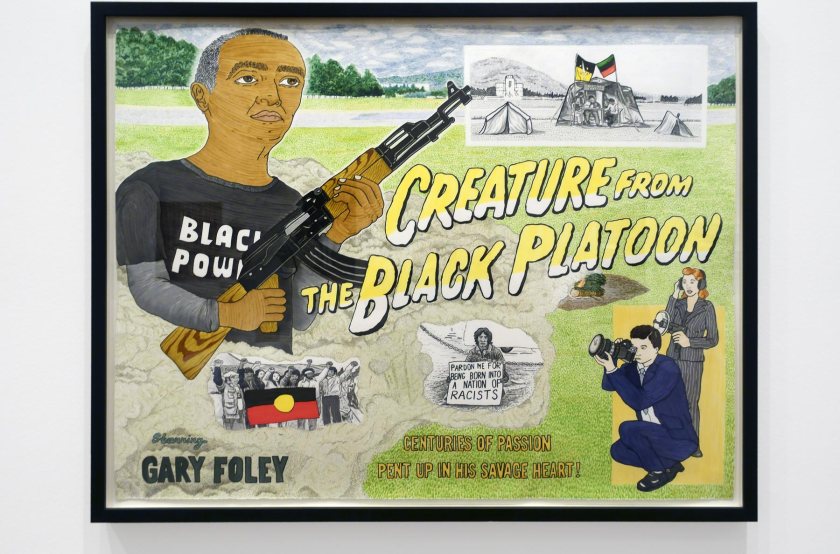
TextaQueen (Australian, b. 1975)
Creature from the Black Platoon starring Gary Foley 2011 (installation view)
2011
From the series We don’t need another hero
Fibre-tipped pen on paper
Frame: 119.0 x 135.0cm
Sheet: 97.5 x 127.2cm
National Portrait Gallery, Canberra
Purchased, 2011
Photo: Marcus Bunyan
Through a series of fictional movie posters, TextaQueen explores a re-writing of colonial history by subverting roles of power. This work combines film posters to subvert the original leading white film cast, creating a mash-up of Gary Foley as a powerful Blak militia. Foley is a renowned Indigenous activist, known for his involvement in the black Power Movement in Australia, which saw the formation of the Aboriginal Legal Service and Medical Service Redfern in the 1970s to counter the problem of police harassment. Here, TextQueen poses Foley as an outlaw of his post-apocalypse, representing him as a survivor while simultaneously creating a platform for the Indigenous experiences of colonisation and racism to be acknowledged and recognised.
Wall text from the exhibition
Gary Foley (b. 1950) Indigenous activist and historian, has written extensively on Indigenous political movements and maintains the Koori History Website, an intensive history archive and education resource. Of Gumbainggir descent, at seventeen Foley moved from his native Grafton to Sydney. There, inspired by the biography of African-American human rights activist Malcolm X, he was instrumental in establishing Sydney’s Aboriginal Legal Service and Aboriginal Medical Service, and in 1972 he came to the Aboriginal Tent Embassy in Canberra. The first Indigenous Director of the Aboriginal Arts Board, he was Senior Curator for Southeastern Australia at Museum Victoria from 2001 to 2005. Since 2005 Foley has lectured and undertaken postgraduate research at the University of Melbourne.
TextaQueen’s (b. 1975) portrait of Gary Foley is from a series featuring ‘people of colour as outlaws of their post-apocalypse, drawn as if posters for fictional movies. As an artist of colour … I’ve sought out peers from various sociocultural and racial backgrounds to propose characters, costumes, and fictional surrounds to represent themselves as survivors of their Armageddon.’ Gary Foley launched the exhibition of the series in Melbourne.
Text from the National Portrait Gallery, Canberra website Nd [Online] Cited 02/07/2022

Guido Maestri (Australian, b. 1974)
Geoffrey Gurrumul Yunupingu (installation view)
2009
Oil on linen
National Portrait Gallery, Canberra
Gift of the artist 2011
Donated through the Australian Government’s Cultural Gifts Program
Photo: Marcus Bunyan
Born blind, Geoffrey Gurrumul Yunupingu (1970-2017), was a talented musician with an extraordinary voice. Gurrumul was a self-taught instrumentalist, playing guitar, piano, drunks and yidaki. Growing up on the remote island of Gallwin’ku (Elcho Island), Gurrumul was taught all Yolngu culture in song, dance, art and ceremony. His gentle songs draw reference to these teachings of sacred animals, the sea and seasons, ancestors and reverence for the land. Guido Maestri’s portrait of the musician was created after the artist saw Gurrumul perform in Sydney on New Year’s Eve 2008. Using just one colour and applied by building upon layers of thin oil paint, this portrait plays homage ad respect to one of Australia’s most influential musicians.
Wall text from the exhibition

Guido Maestri (Australian, b. 1974)
Geoffrey Gurrumul Yunupingu
2009
Oil on linen
National Portrait Gallery, Canberra
Gift of the artist 2011
Donated through the Australian Government’s Cultural Gifts Program

Ricky Maynard (Australian / Big River/Ben Lomond, b. 1953)
Arthur, Wik elder
2000
From the series Returning to places that name us
Gelatin silver photograph
96.1 × 121.3cm irreg.
National Gallery of Victoria, Melbourne
Gift of Milton and Penny Harris, 2007
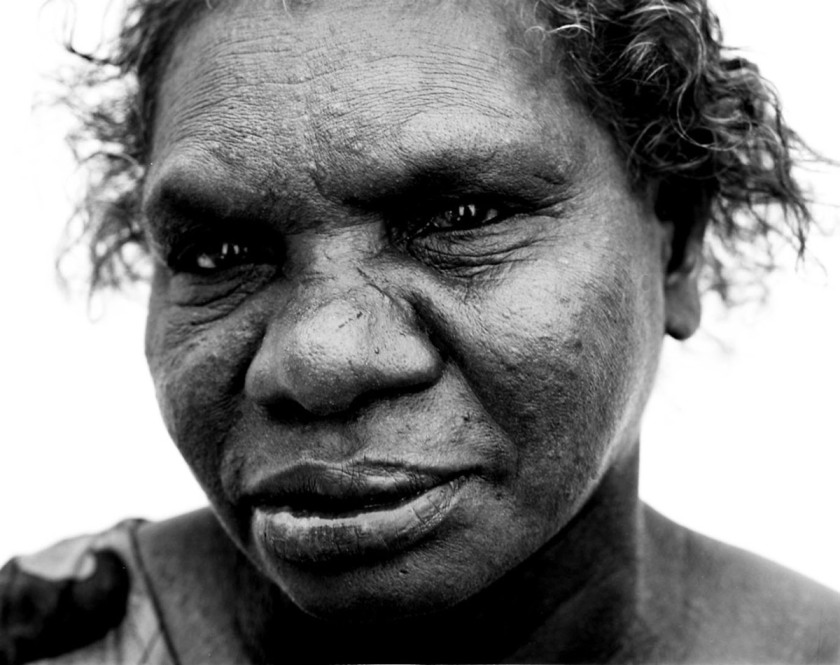
Ricky Maynard (Australian / Big River/Ben Lomond, b. 1953)
Wik Elder, Gladys Tybingoomba
2000
From the series Returning to places that name us
Gelatin silver photograph
95.5 × 123.0cm
National Gallery of Victoria, Melbourne
Gift of Milton and Penny Harris, 2007
These intimate portraits of Wik Elders from the community of Aurukun, Far North Queensland, were inspired by the hard-fought battle for custodianship and recognition of the Wik people’s connection to traditional land and waterways. In this image, Maynard documents cultural leader and activist Gladys Tybingoompa, who is remembered today as a prolific figure in the Wik vs Queensland Case and a trailblazer for Indigenous land rights across Australia.
Wall text from the exhibition

Installation view of the exhibition WHO ARE YOU: Australian Portraiture at NGV Australia, Federation Square, Melbourne showing at left, Peter Corlett’s The connoisseur II (1984); at second left, Howard Arkley’s Nick Cave (1999, below)
Photo: Marcus Bunyan

Howard Arkley (Australia 1951-1999)
Nick Cave
1999
Synthetic polymer paint on canvas
175.2 x 135.2 x 4.3cm
National Portrait Gallery, Canberra
Commissioned with funds provided by L Gordon Darling AC CMG 1999
© Estate of Howard Arkley. Licensed by Kalli Rolfe Contemporary Art
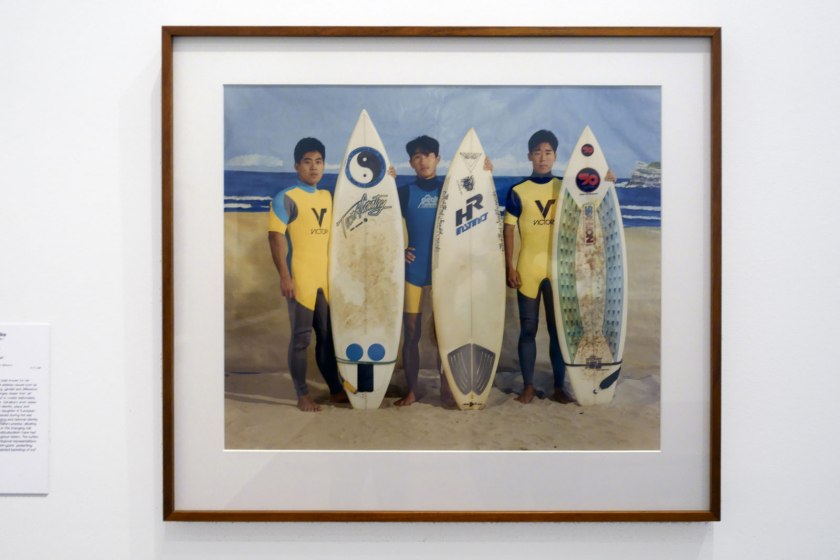
Anne Zahalka (Australian, b. 1957)
The surfers (installation view)
1989
Type C photograph
76.4 x 92.5cm
National Gallery of Victoria, Melbourne
Purchased, 1991
© Anne Zahalka/Licensed by Copyright Agency, Australia
Photo: Marcus Bunyan
Anne Zahalka is best known for her photographs that address issues such as racial stereotyping, gender and difference. Using images largely drawn from art historical sources to create elaborately constructed sets, Zahalka’s work raises questions about identity, place and nationhood. The daughter of European immigrants displaced during the war, themes of belonging and national identity are intrinsic to Zahalka’s practice, allowing her to comment on the changing role migration and multiculturalism have had in Australia throughout history. The surfers challenge stereotypical representations of Australian beach-goers, presenting them against a painted backdrop of surf and sand.
Wall text from the exhibition
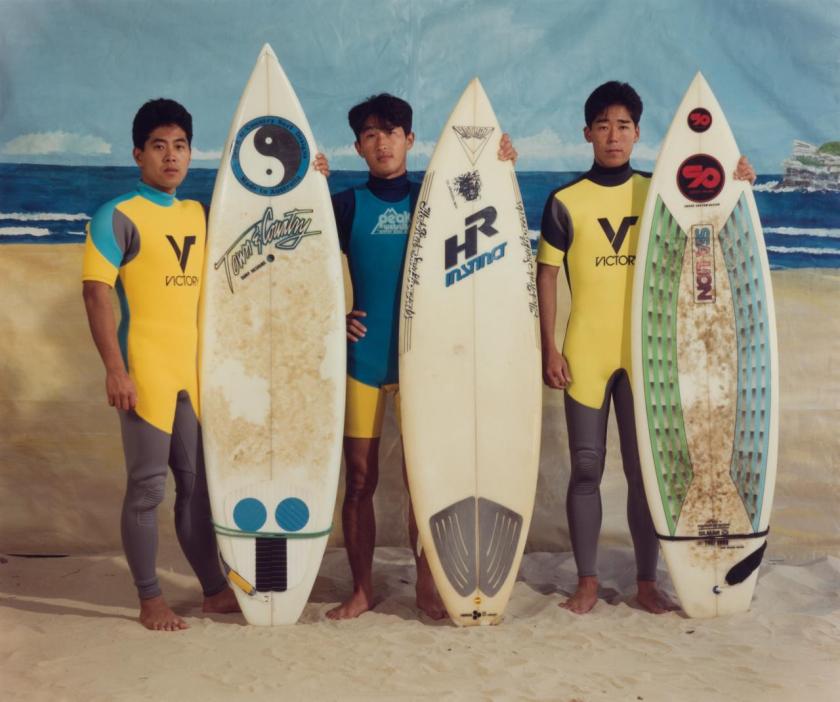
Anne Zahalka (Australian, b. 1957)
The surfers
1989
Type C photograph
76.4 x 92.5cm
National Gallery of Victoria, Melbourne
Purchased, 1991
© Anne Zahalka/Licensed by Copyright Agency, Australia
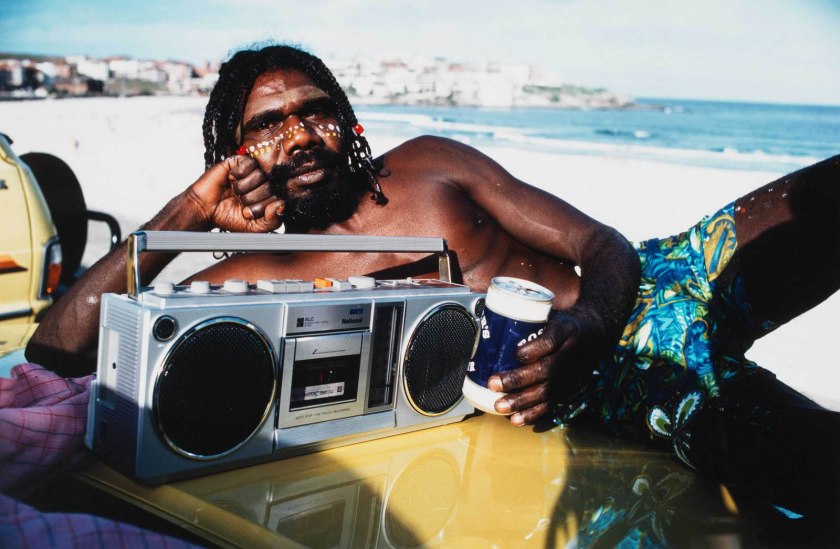
Tracey Moffatt (Australian, b. 1960)
The Movie Star (David Gulpilil)
1985
Type C photograph on paper
Image: 50.7 x 77.3cm
Frame: 74.5 x 99.0cm
Gift of the artist 1998. Donated through the Australian Government’s Cultural Gifts Program
Courtesy of the artist and Roslyn Oxley9 Gallery, Sydney
© Tracey Moffatt
One of Australia’s most acclaimed contemporary artists, Tracey Moffatt grew up in Brisbane and moved to Sydney after studying at the Queensland College of Art. She worked in photography, video and filmmaking, helped establish the Boomalli Aboriginal Artists Cooperative, and was part of the group of creatives engaged in reshaping the representation of First Nations peoples in the visual and performing arts. When Moffatt photographed him in 1985, Yolngu man David Gulpilil AM (1953-2021) had already appeared in several major film and television productions, including Walkabout (1971), Storm Boy (1976), The Last Wave (1977) and The Timeless Land (1980). This portrait of him was shown in NADOC ’86, which Wiradjuri / Kamilaroi artist Michael Riley described as the first exhibition where Aboriginal artists ‘were dictating … how they wanted to show images of their own people.’ Moffatt’s image of Gulpilil lazing at Bondi Beach might seem benignly tongue-in-cheek, but in fact makes an incisive reference to colonialism and the dispossession on which Australia’s supposedly egalitarian, laid-back lifestyle is based.
This work and Moffatt’s portrait of Nunukul and Yugambeh dancer Russell Page (1968-2002) were the first two photographs acquired by the National Portrait Gallery.
Text from the National Portrait Gallery, Canberra website Nd [Online] Cited 02/07/2022
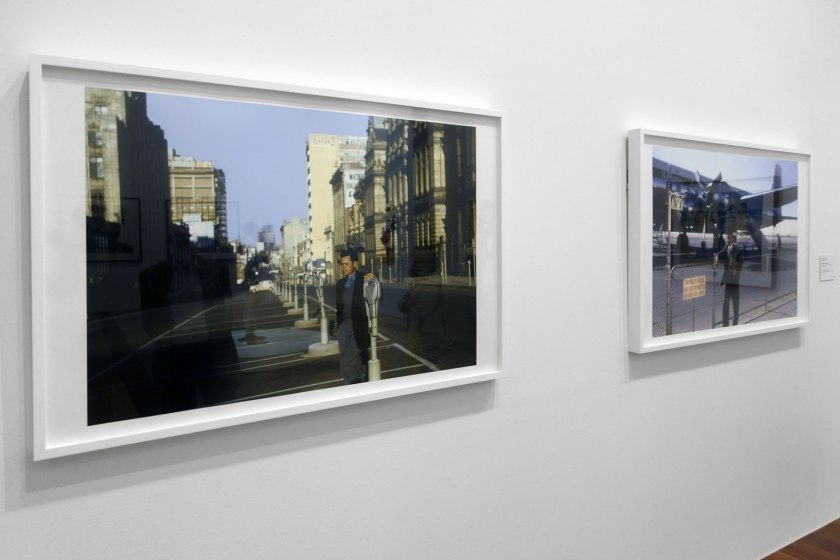
Installation view of the exhibition WHO ARE YOU: Australian Portraiture at NGV Australia, Federation Square, Melbourne showing photographs from Brenda L. Croft’s A man bout town series (2004, below)
Photo: Marcus Bunyan
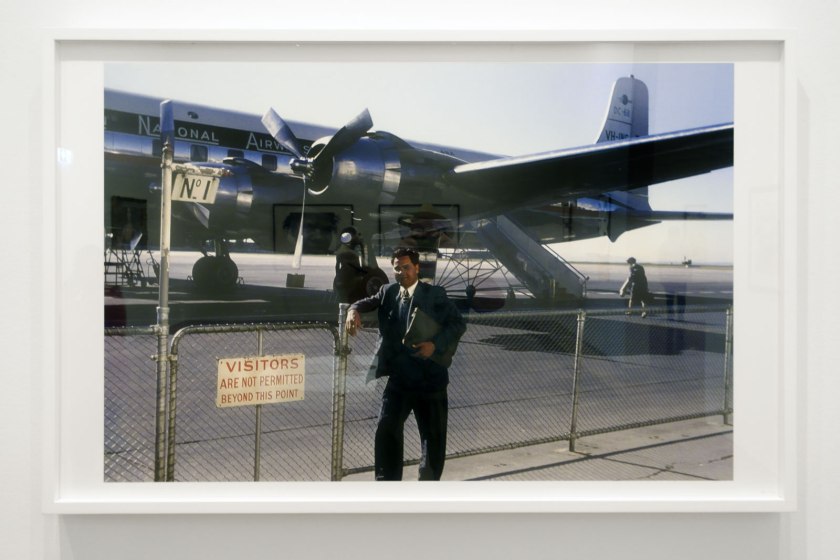
Brenda L. Croft (Australian / Gurindji/Mutpurra, b. 1965)
A hostile landscape (installation view)
2003, printed 2004
From A man about town series 2004
84.0 × 124.8cm
National Gallery of Victoria, Melbourne
Purchased with funds arranged by Loti Smorgon for Contemporary Australian Photography, 2004
Photo: Marcus Bunyan
Brenda Croft stumbled upon the two photographs A hostile landscape and A man about town in 1997, while sorting the material possessions of her late father. As Croft has written, ‘I carried these images around in my mind for the next seven years, returning to them often and wondering about the city and countryscapes, the period in which they were set and the anonymous people in them’. The two photographs show Croft’s father as a solitary figure in the urban landscape. These depictions contrast with typical representations of the ‘businessman’ within society, which portray a white, middle-class man. These photographs also work to reposition prevailing imagery of Aboriginal Australians living purely in remote areas, as opposed to city environments.
Wall text from the exhibition

Brenda L. Croft (Australian / Gurindji/Mutpurra, b. 1965)
A man about town
2003, printed 2004
From A man about town series 2004
84.0 × 124.8cm
National Gallery of Victoria, Melbourne
Purchased with funds arranged by Loti Smorgon for Contemporary Australian Photography, 2004
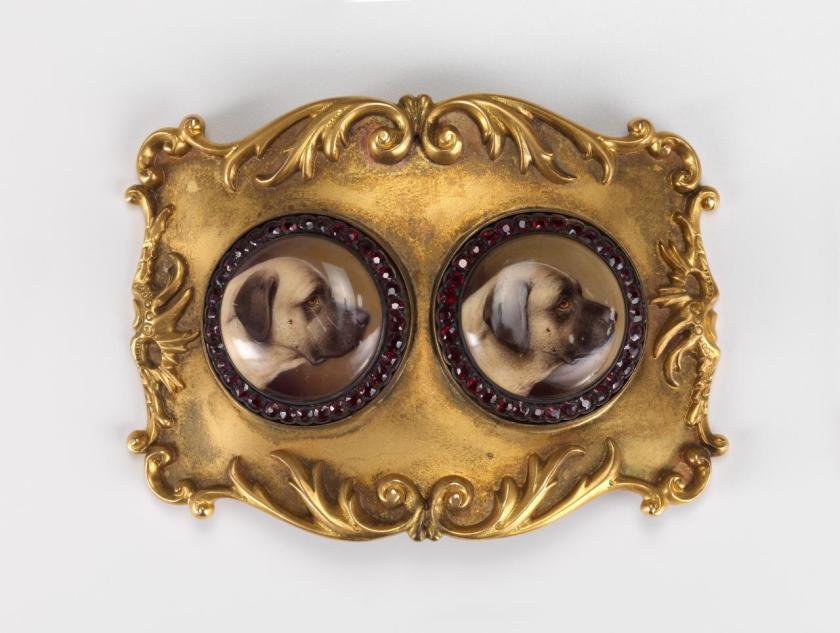
Edward Schafer & Co., Melbourne (retailer)
Belt buckle
c. 1900
15 ct gold, garnets, enamel
(a-b) 6.2 x 8.3 x 1.8cm (overall)
National Gallery of Victoria, Melbourne
The Altmann Collection of Australian Silver
Presented through The Art Foundation of Victoria by John and Jan Altmann, Founder Benefactors, 1986

Michael Riley (Australian / Wiradjuri/Kamilaroi, 1960-2004)
Maria
1986, printed 2013
From the Michael Riley Portraits 1984-1990 series
Inkjet print on paper
39.1 x 40.9cm
National Portrait Gallery, Canberra.
Purchased 2013
© Michael Alan Riley/Copyright Agency, 2022

Brook Andrew (Australian, b. 1970)
Trent Walter (printer) (Australian, b. 1980)
Marcia Langton
2009
Screenprint on paper
252.0 x 242.0 x 7.1cm
National Portrait Gallery, Canberra
Commissioned with funds provided by Marilyn Darling AC 2009
© Brook Andrew/Copyright Agency, 2022

John Nixon (Australian, b. 1949)
Self Portrait (non-objective composition) (yellow cross)
1990
Enamel paint on plywood
177.6 x 165.0cm
National Gallery of Victoria, Melbourne
Purchased through The Art Foundation of Victoria with the assistance of Chase Manhattan Overseas Corporation, Fellow, 1991
© Courtesy of the artist
The Ian Potter Centre: NGV Australia
Federation Square
Corner of Russell and
Flinders Streets, Melbourne
Opening hours:
Daily 10am – 5pm
National Gallery of Victoria website
LIKE ART BLART ON FACEBOOK
Back to top





































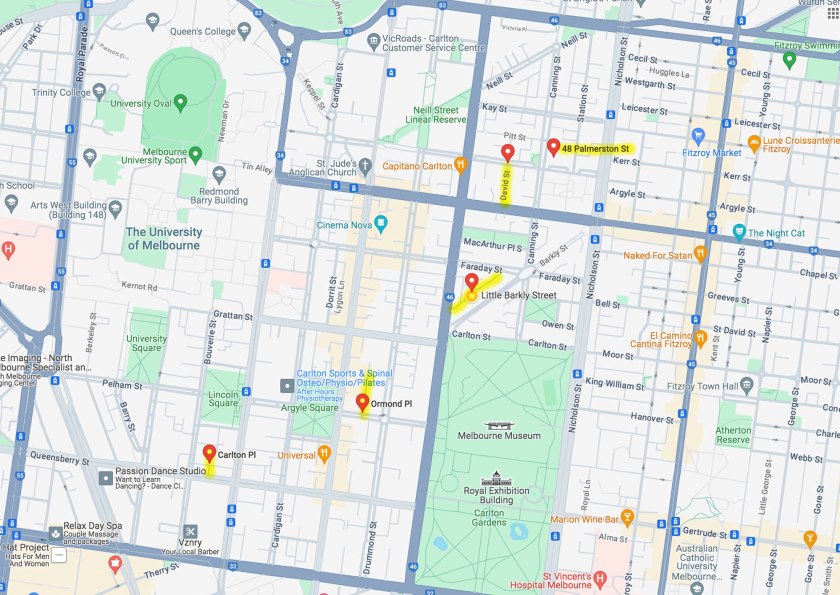


















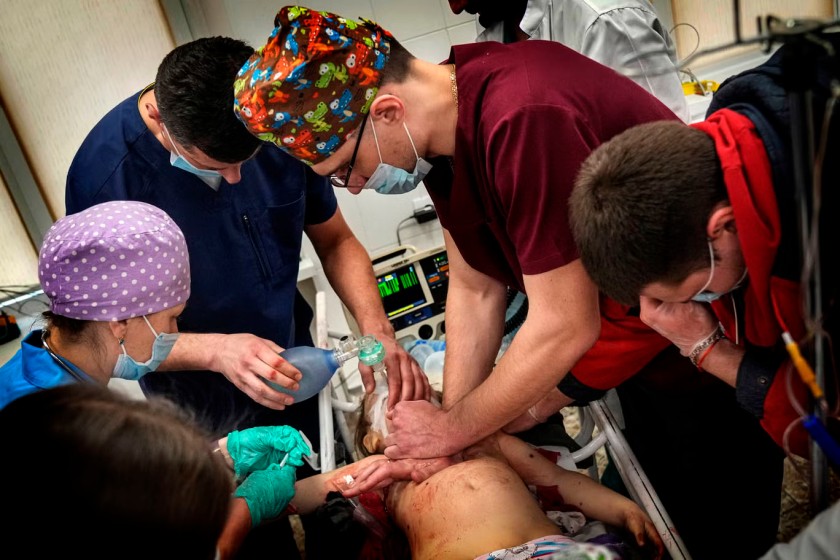

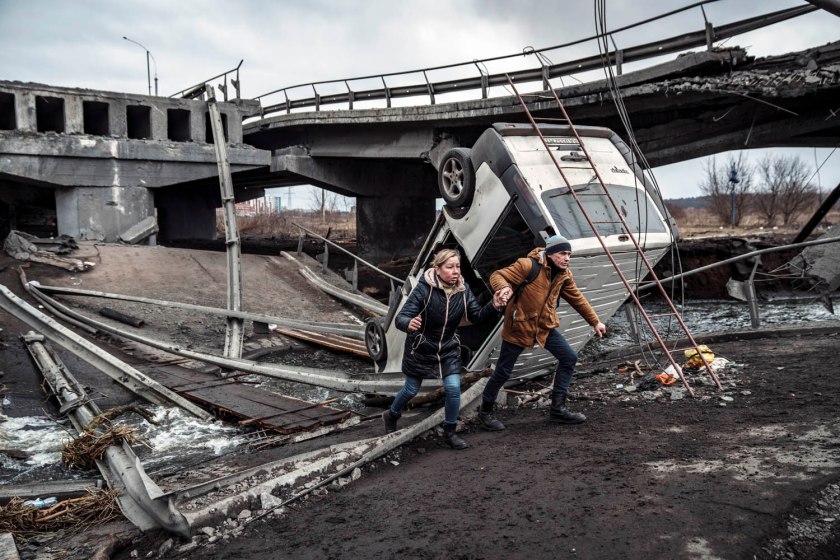
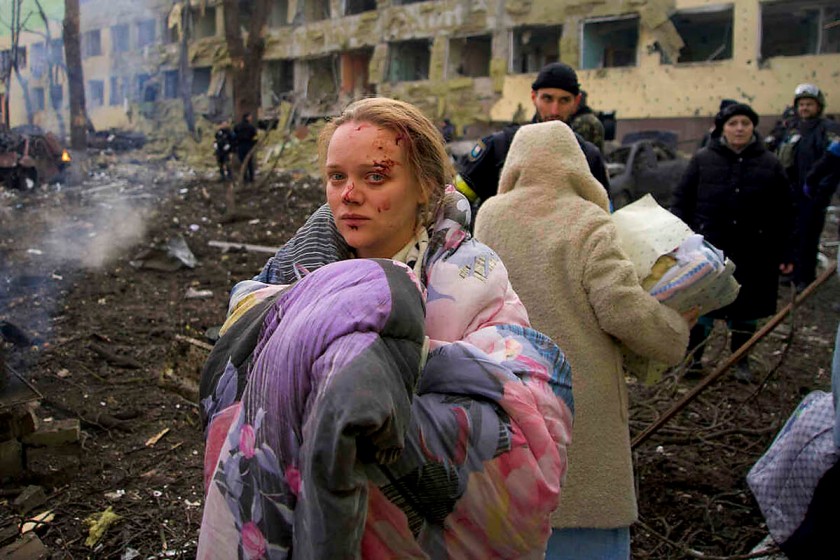
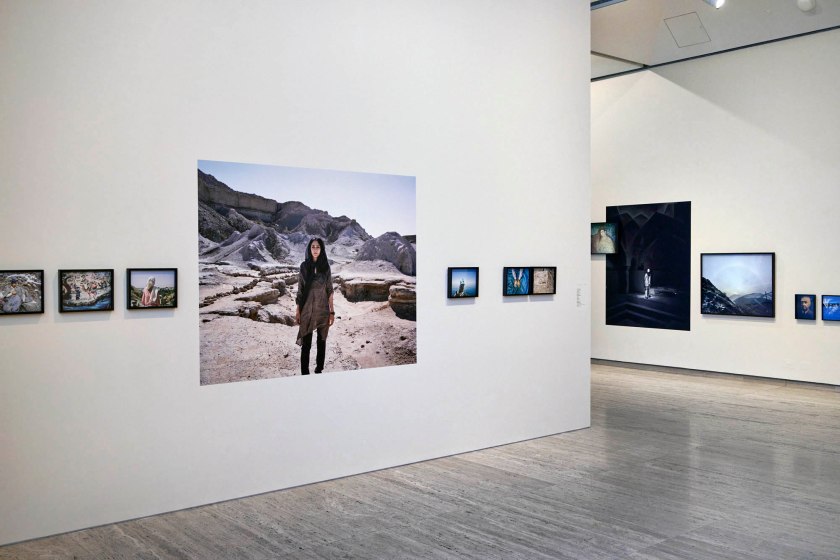
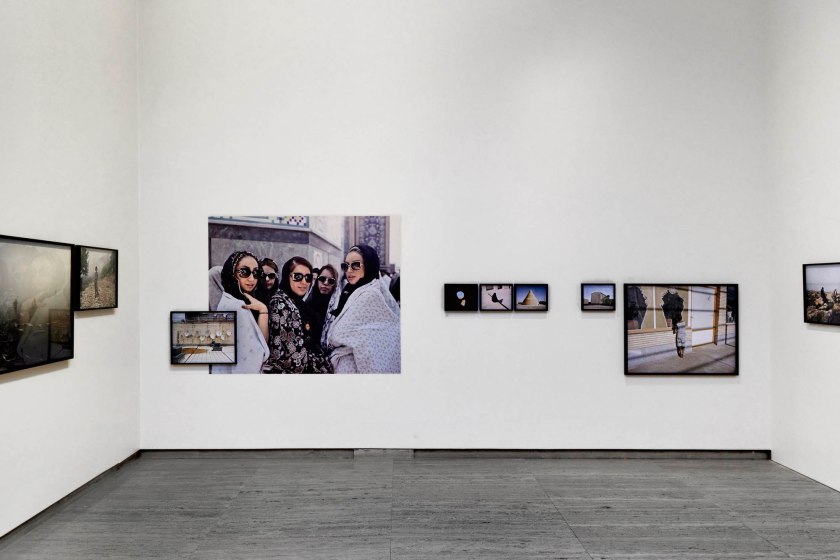

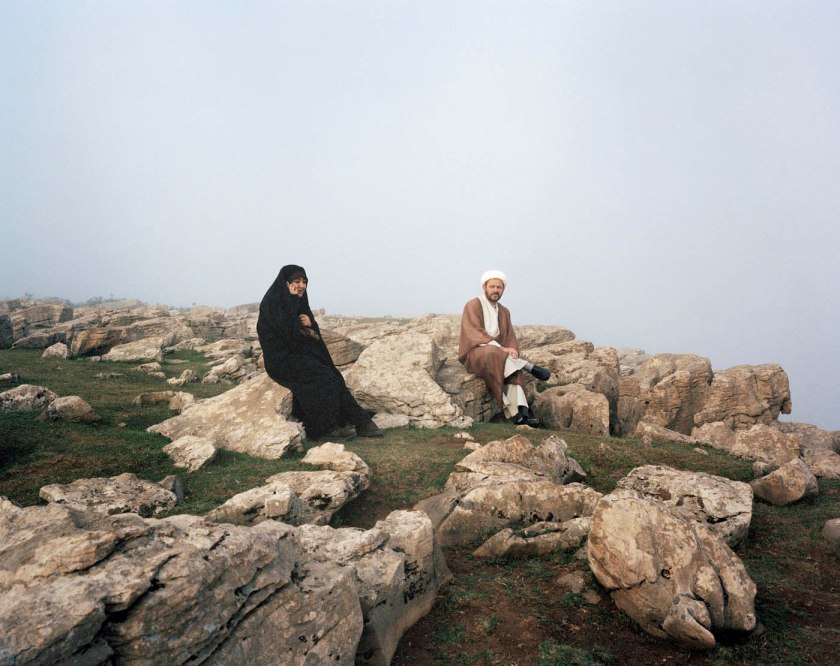
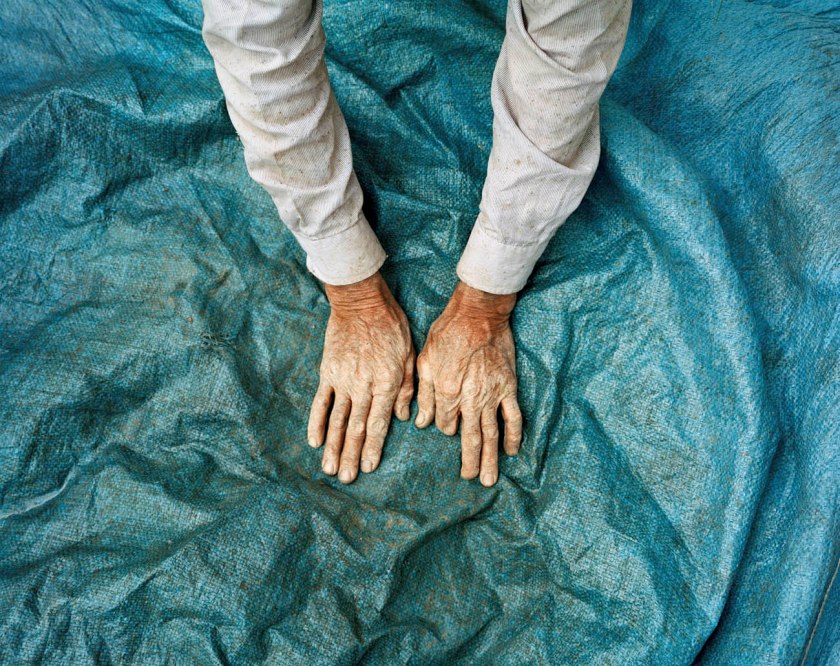
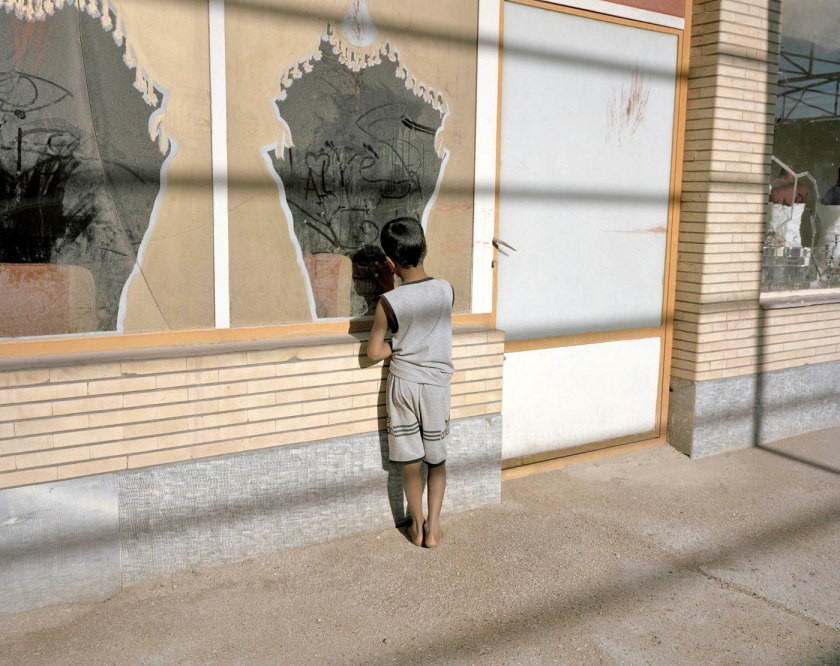
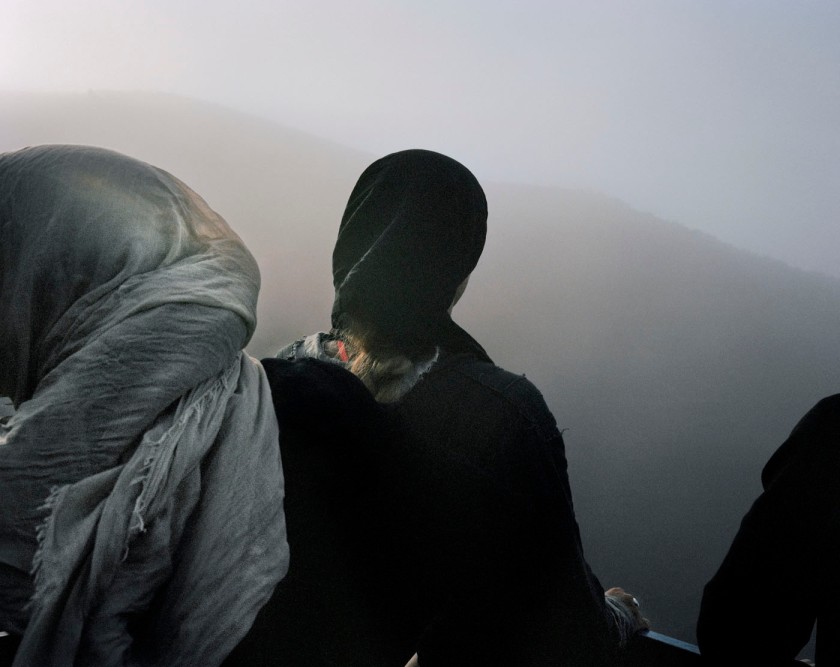

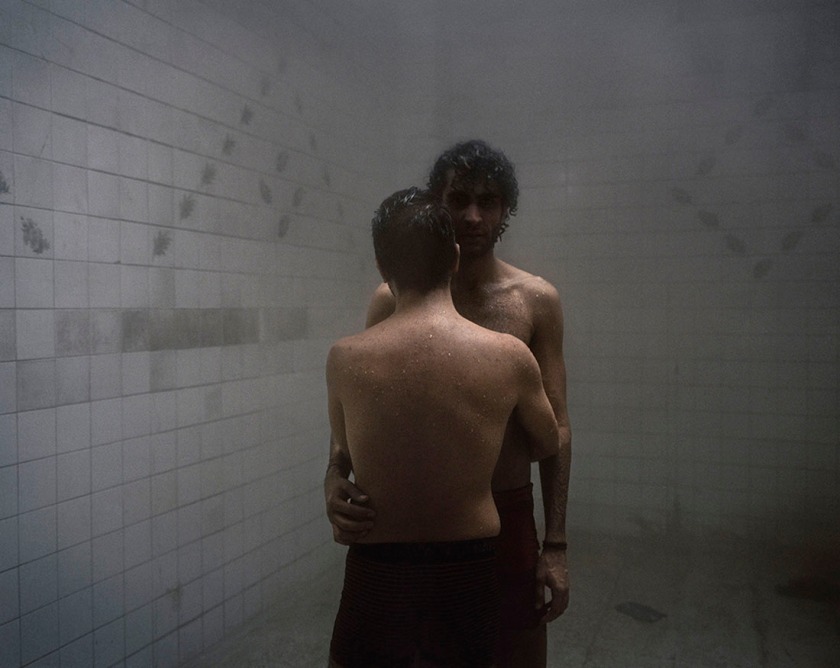
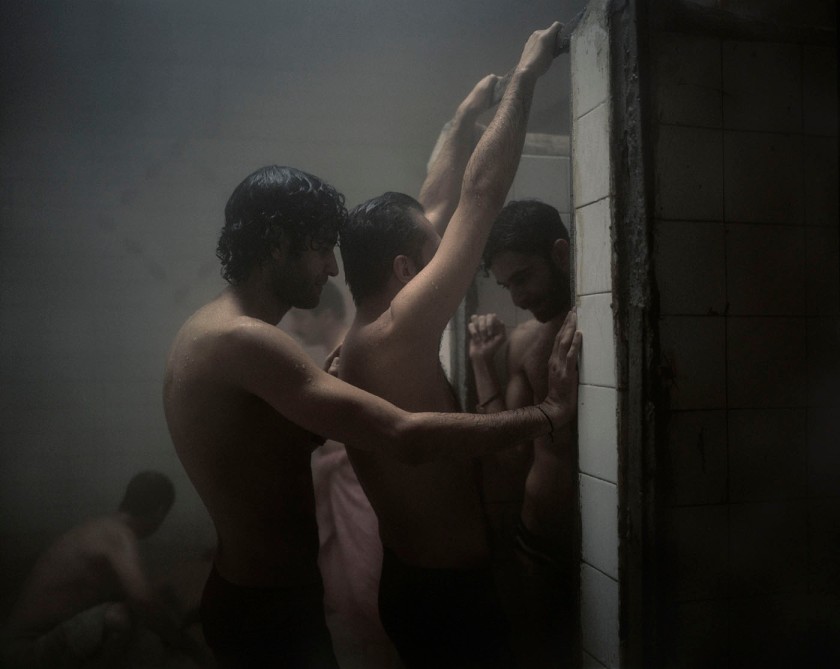
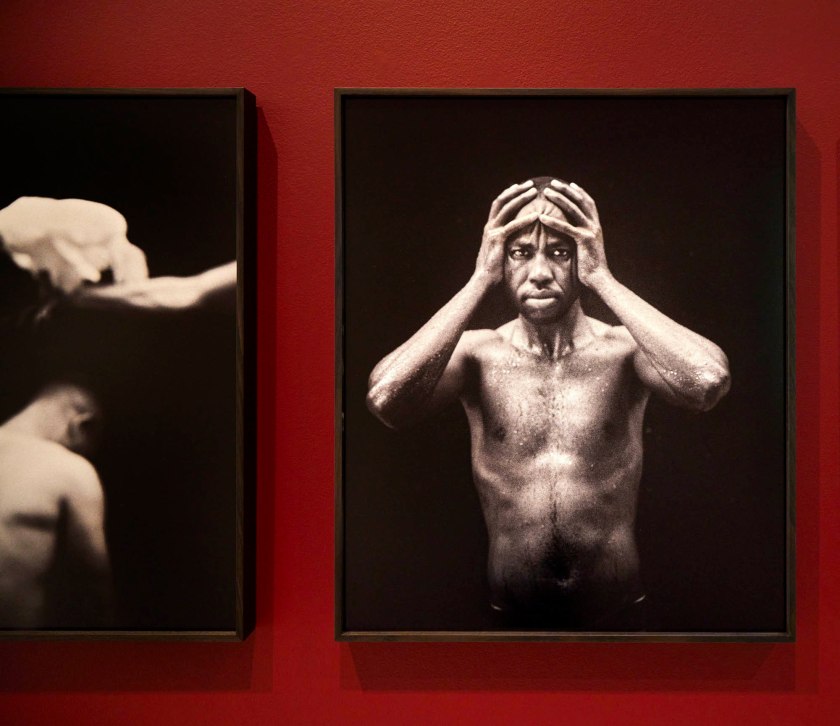
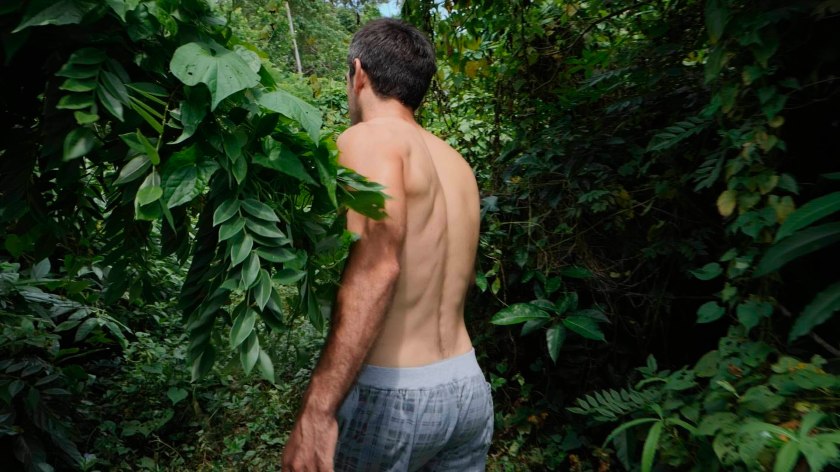

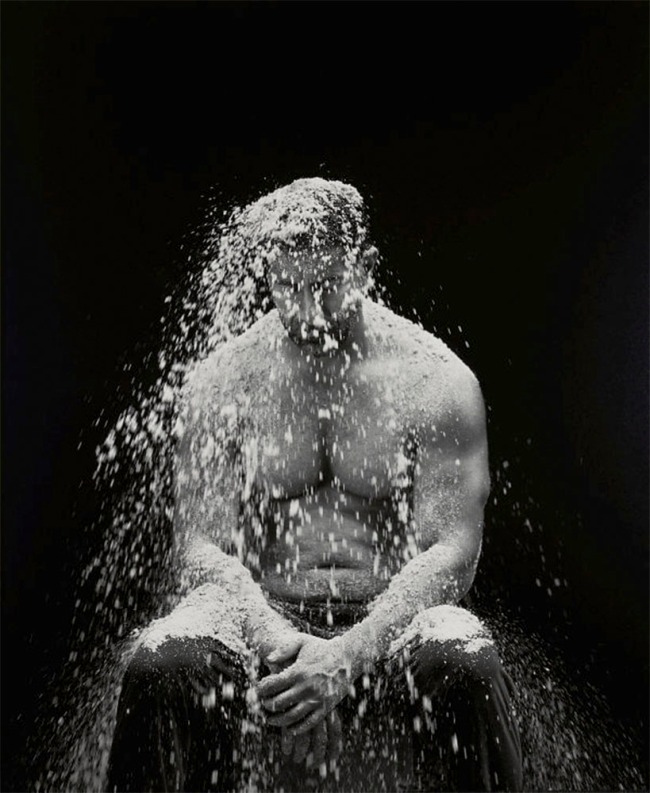
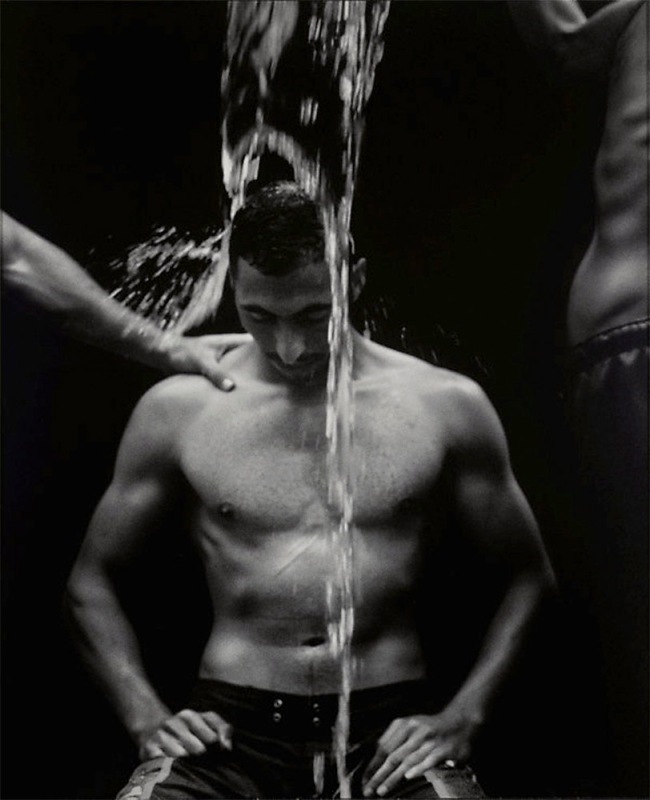
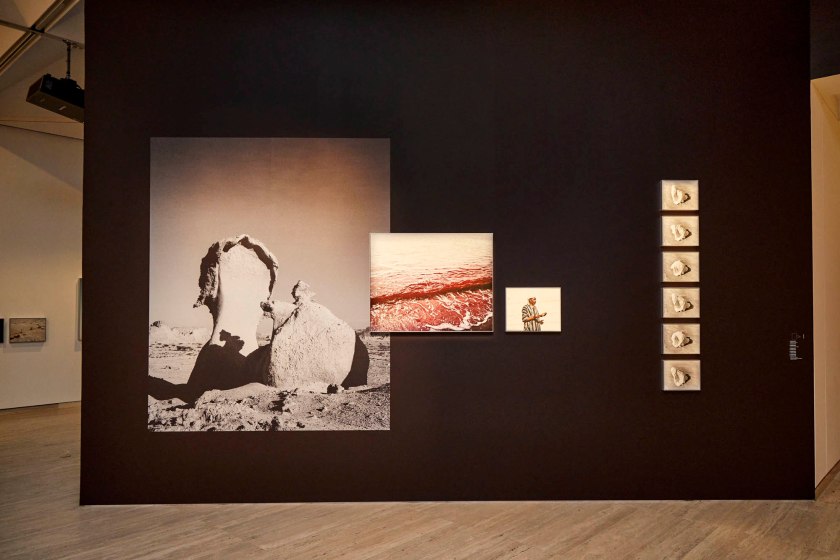


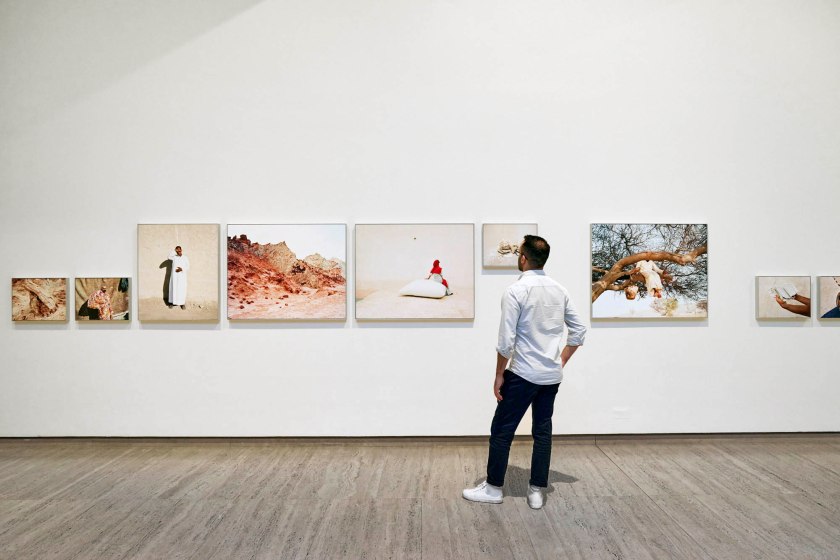


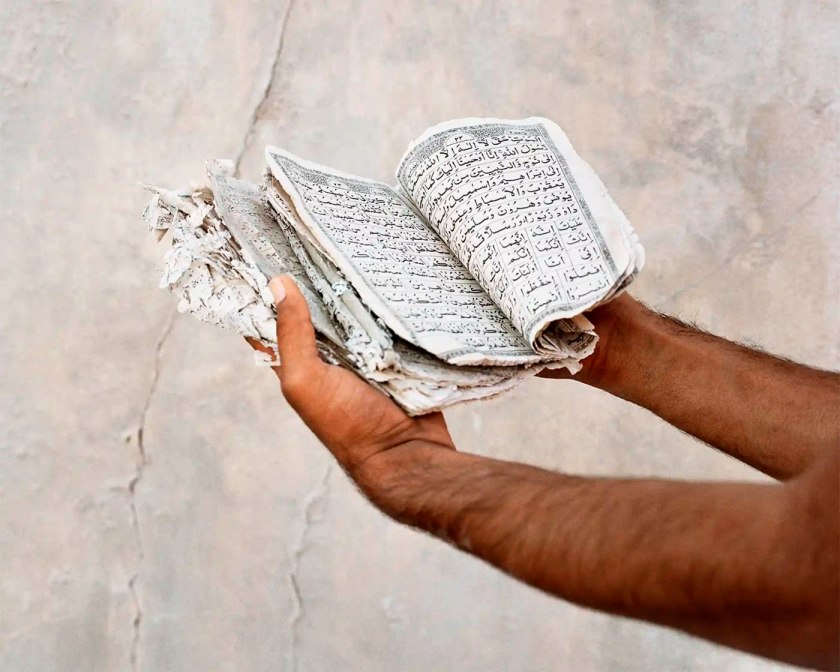


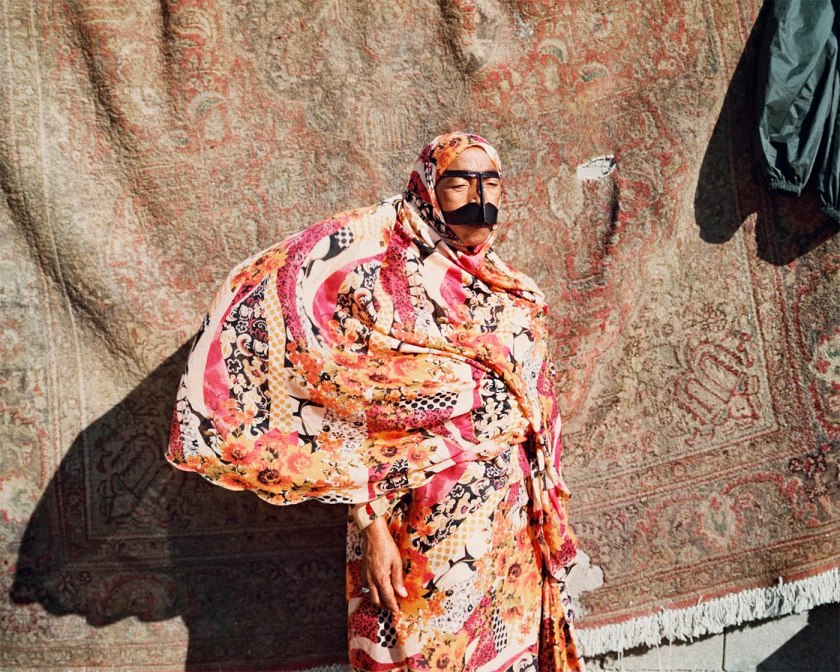
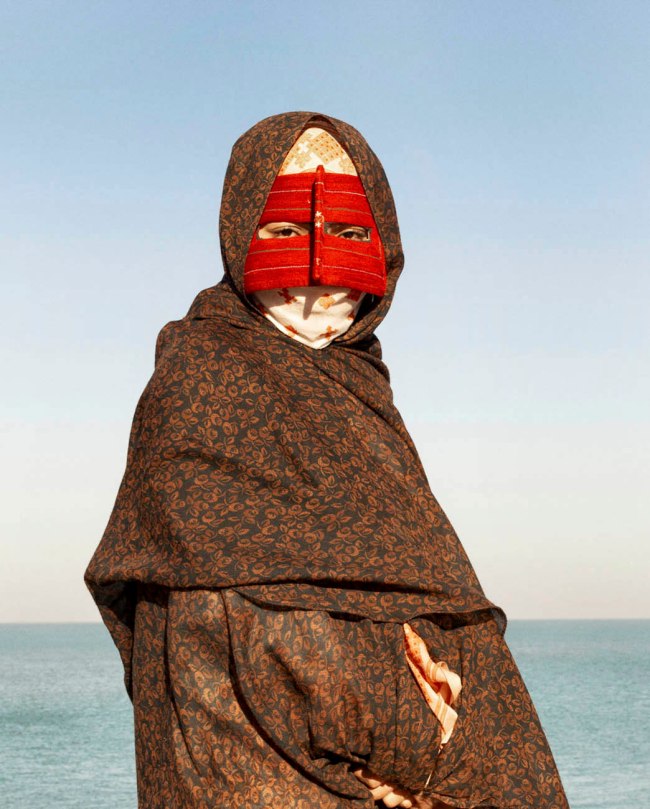


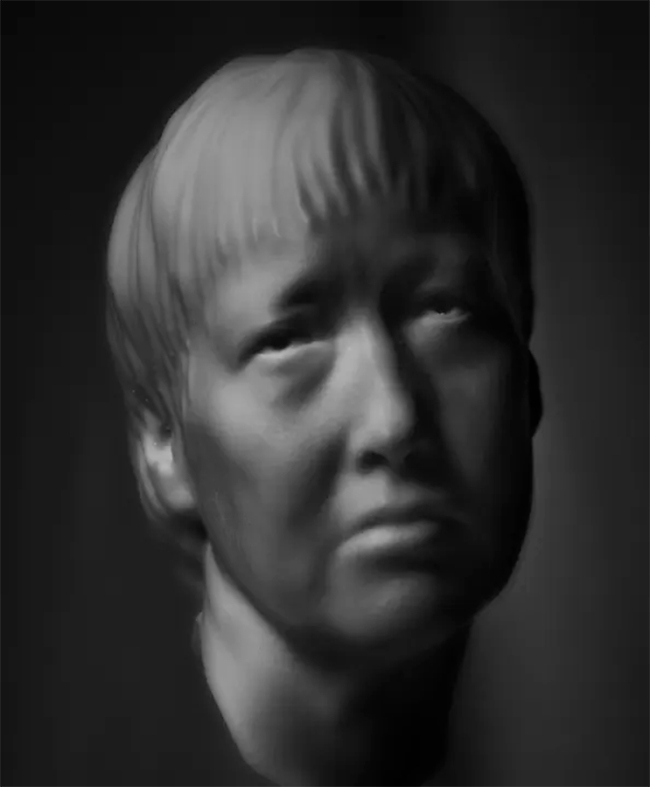
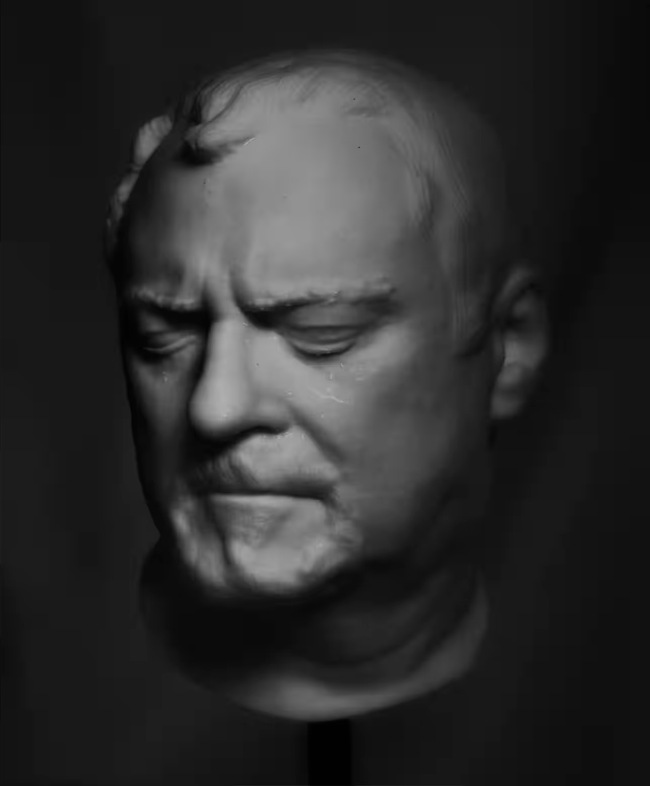
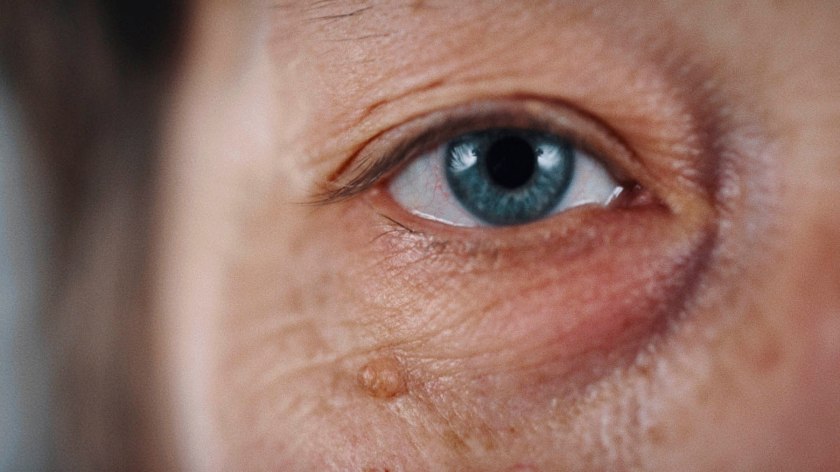

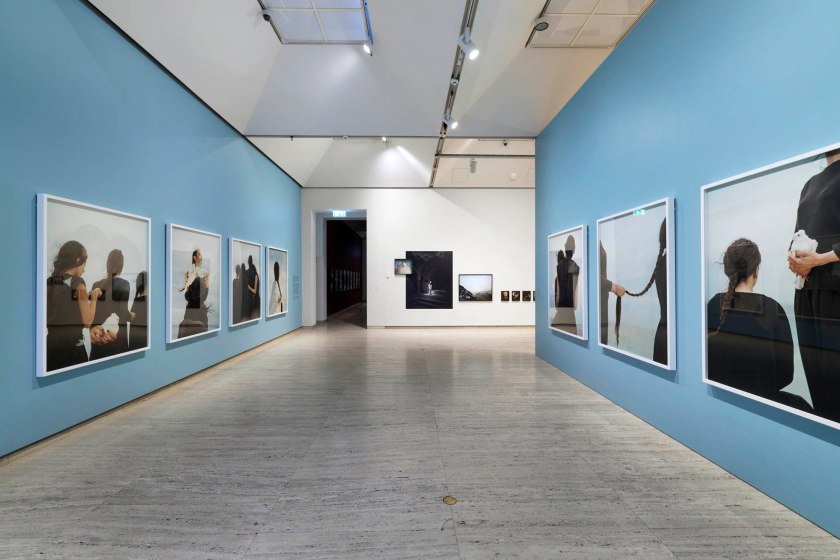

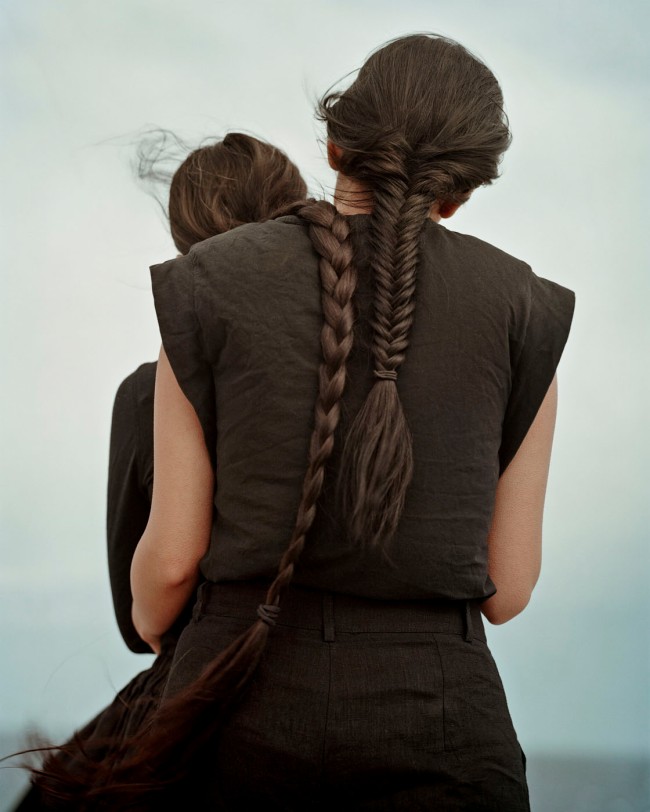
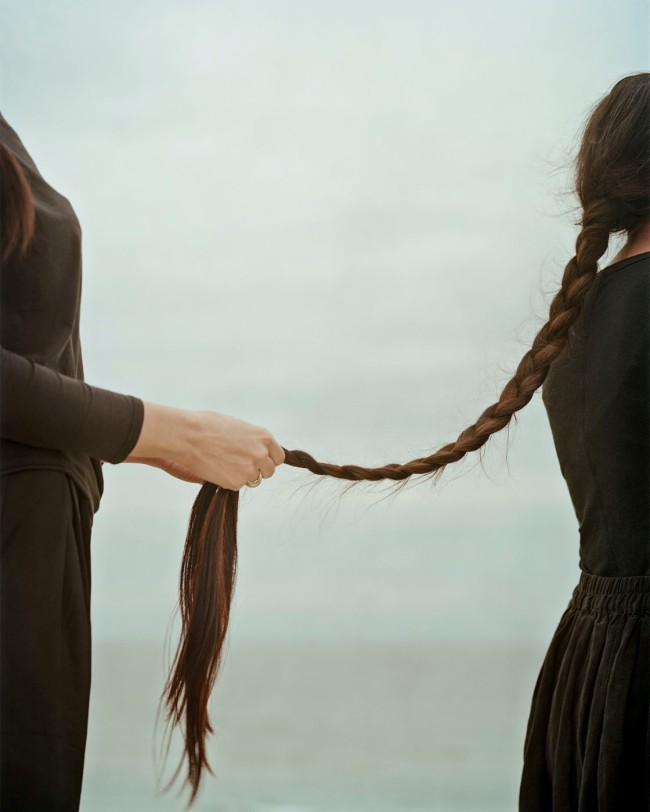
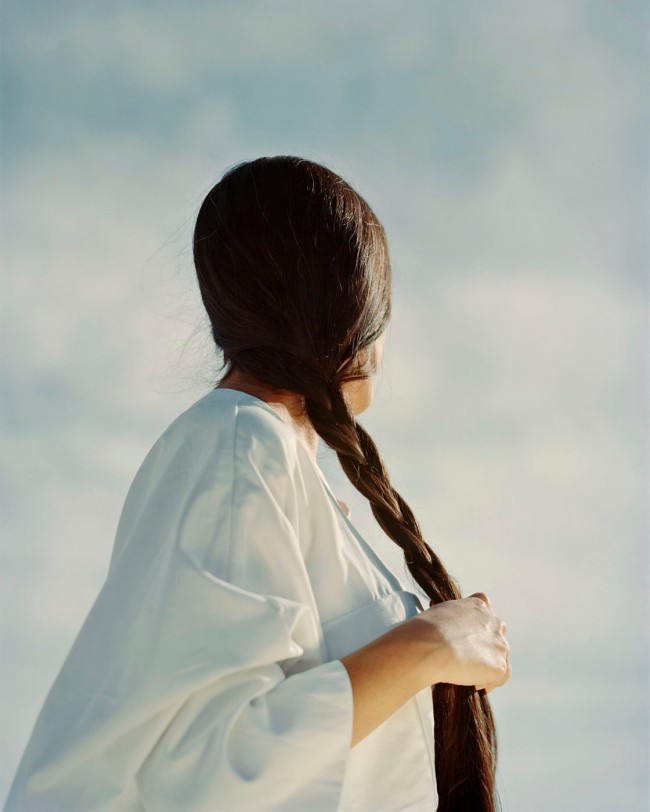
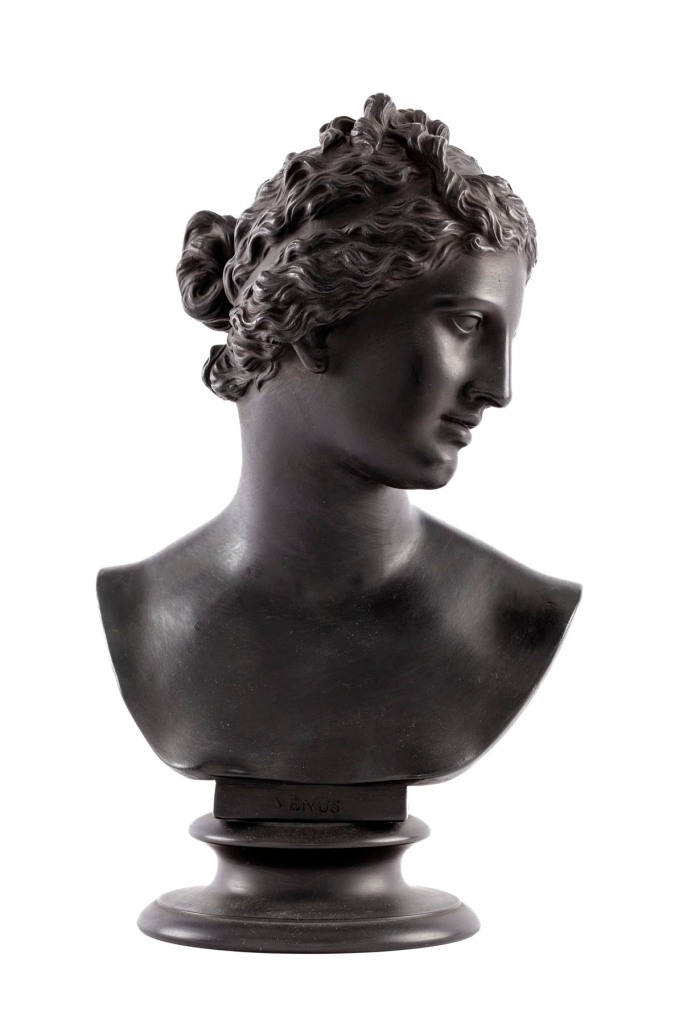
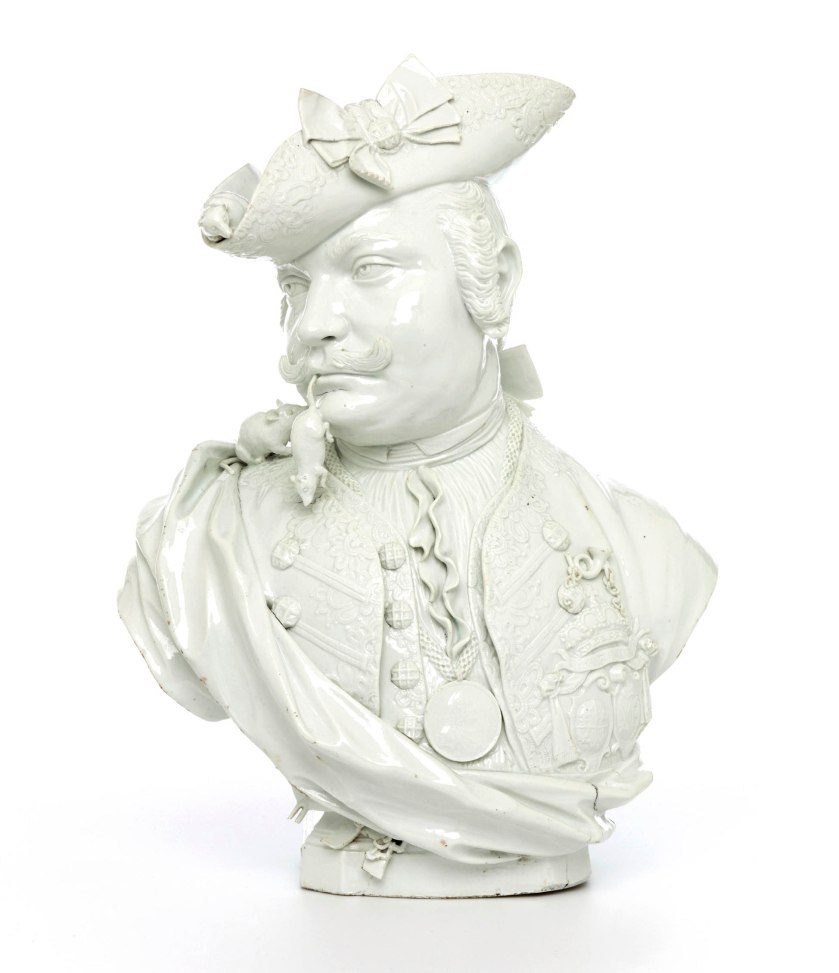
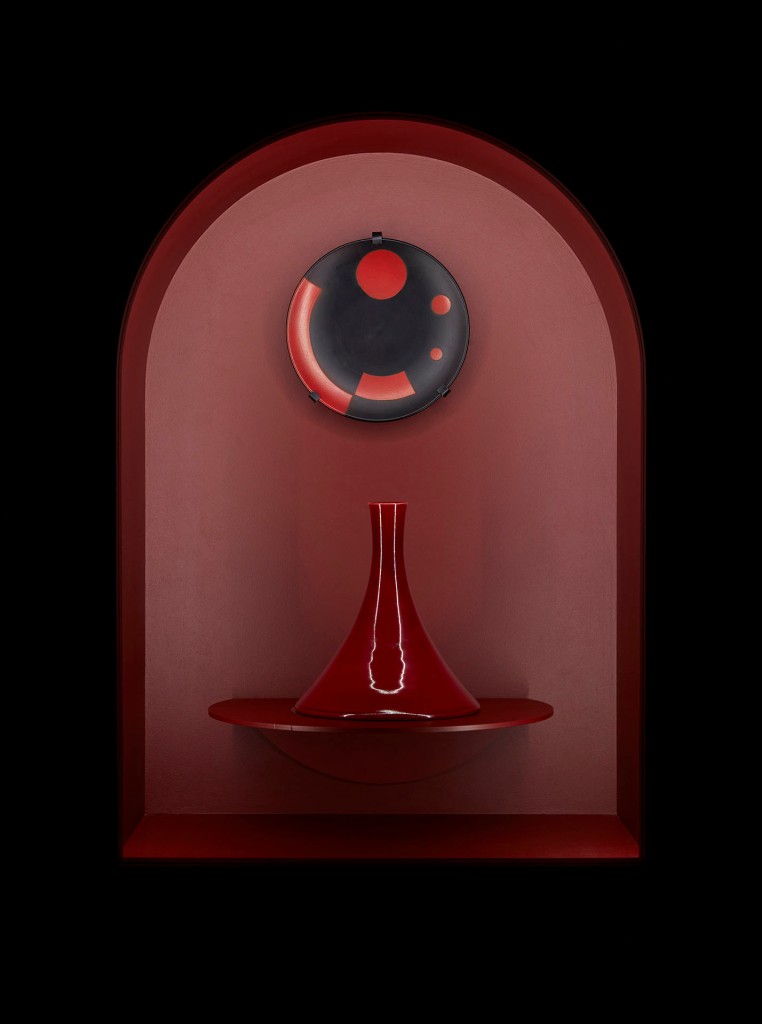

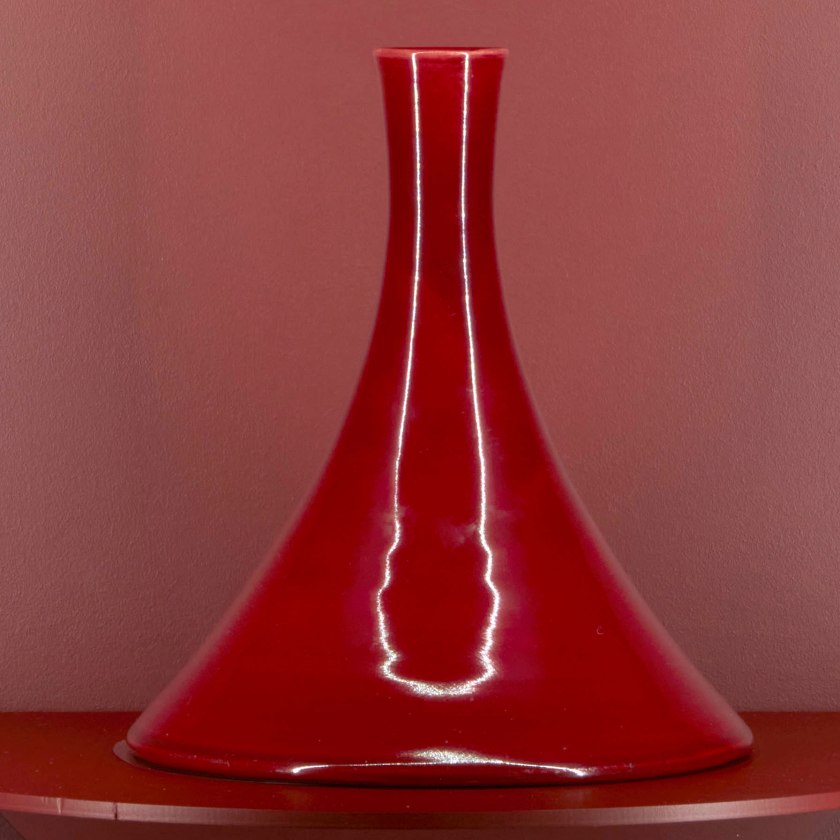
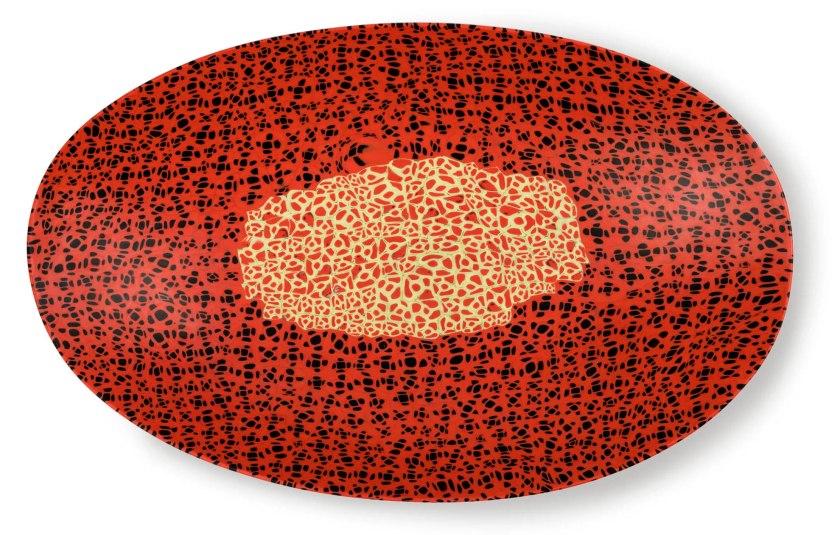

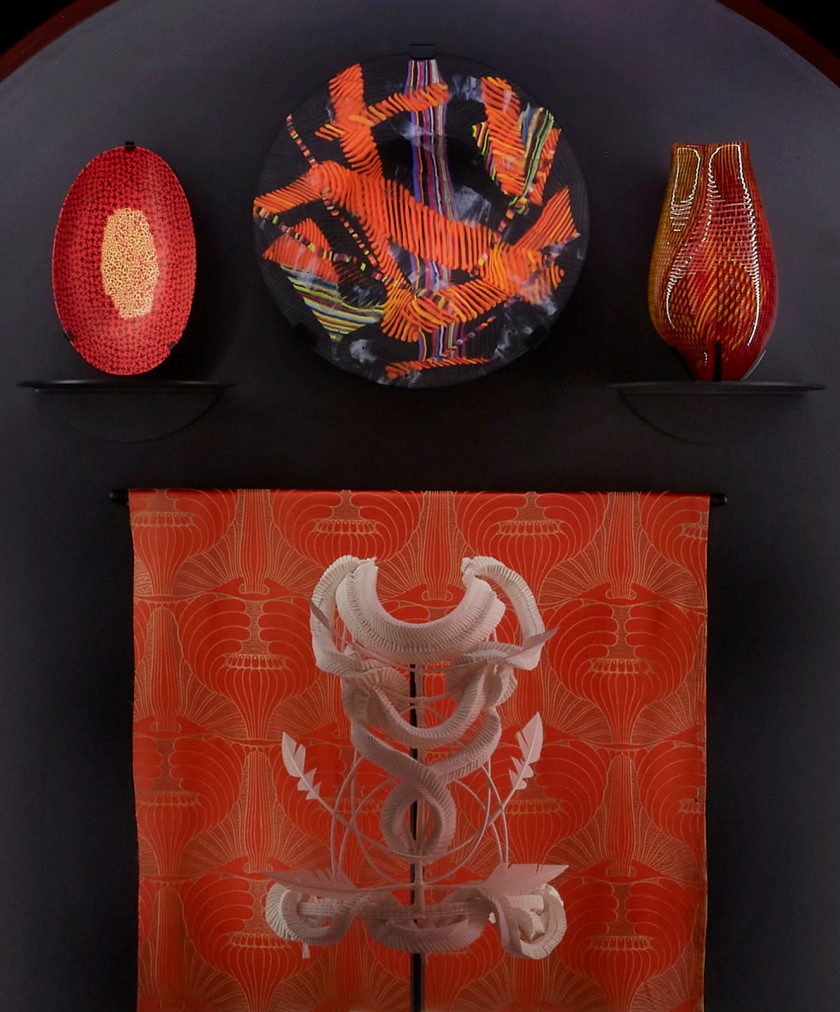

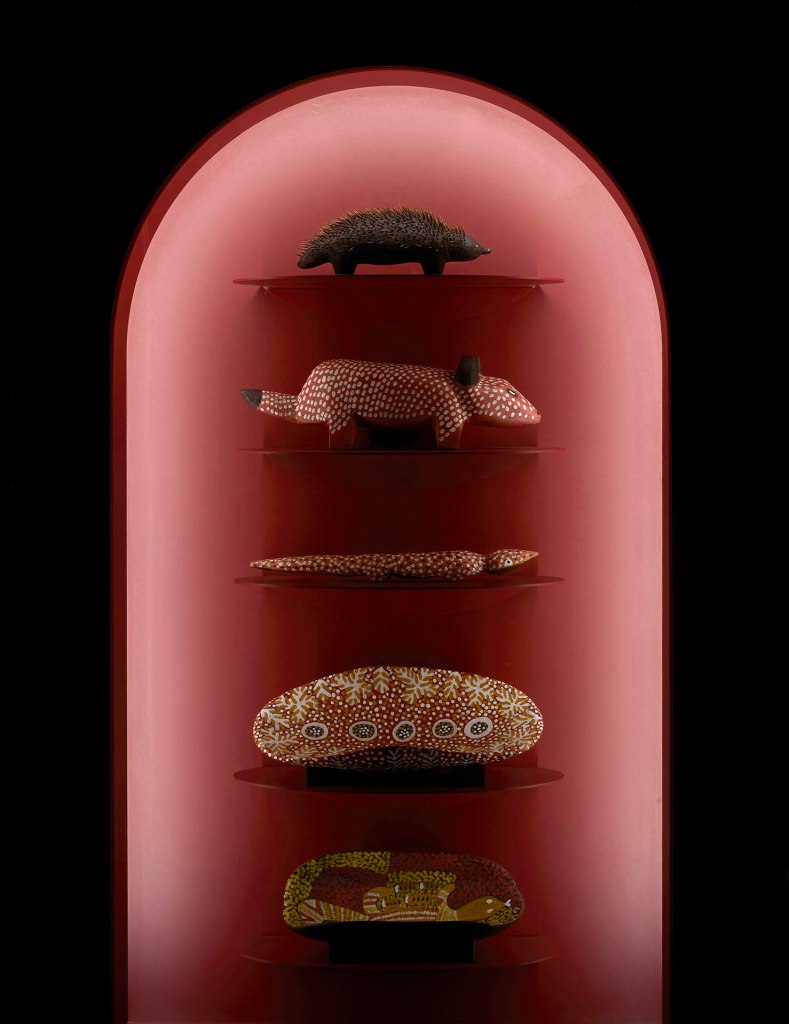
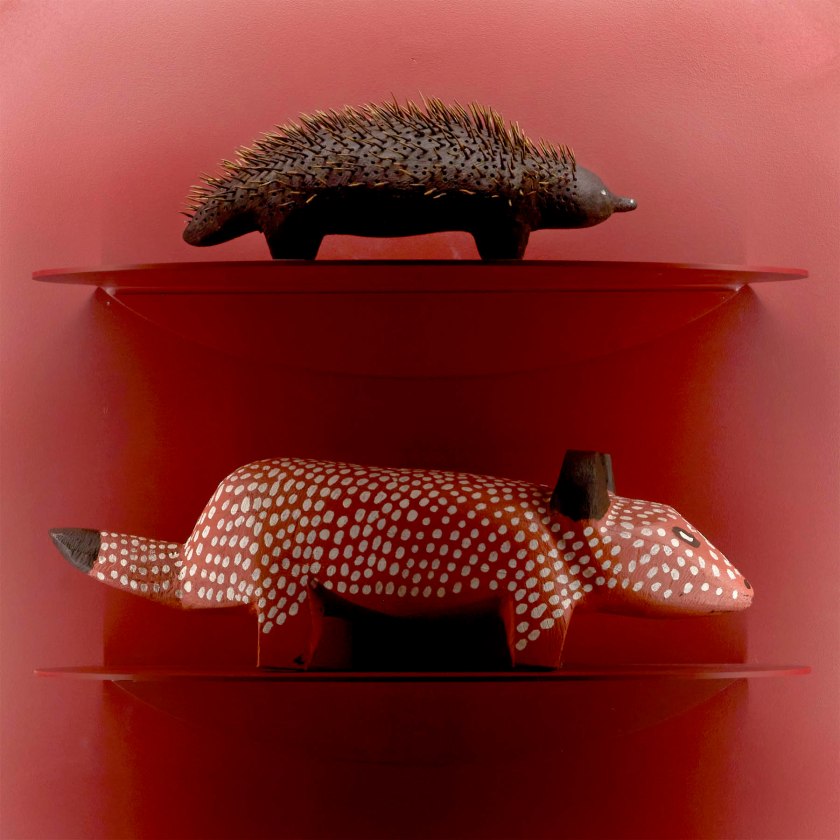
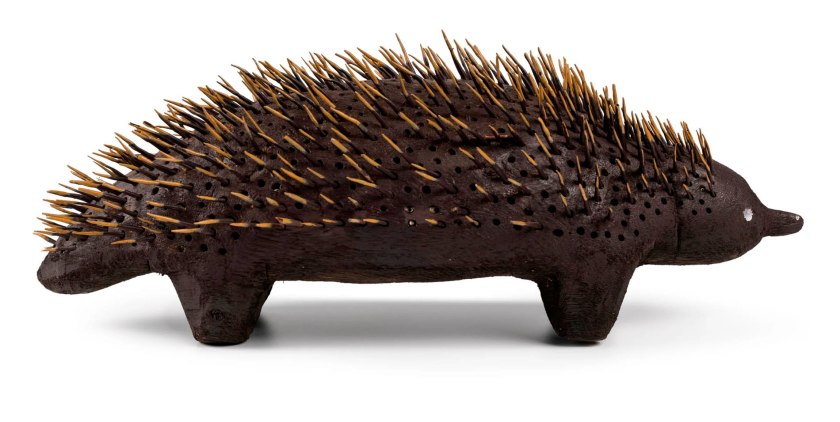
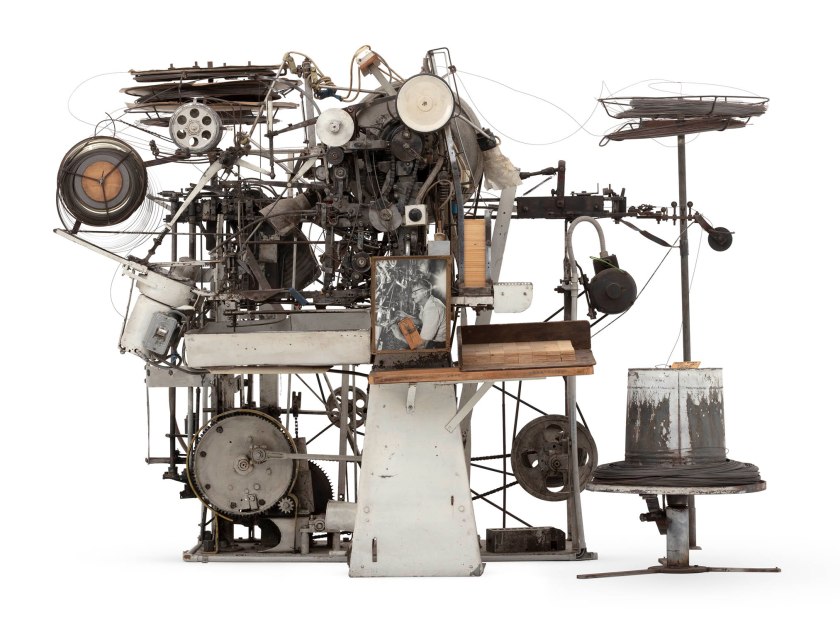
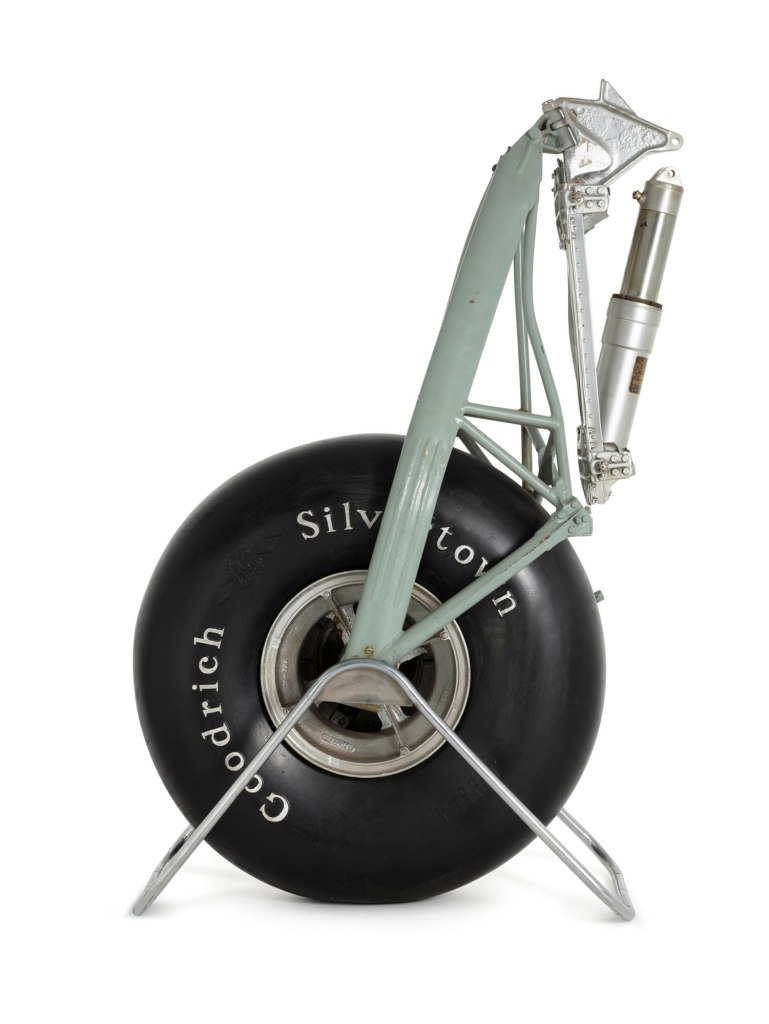
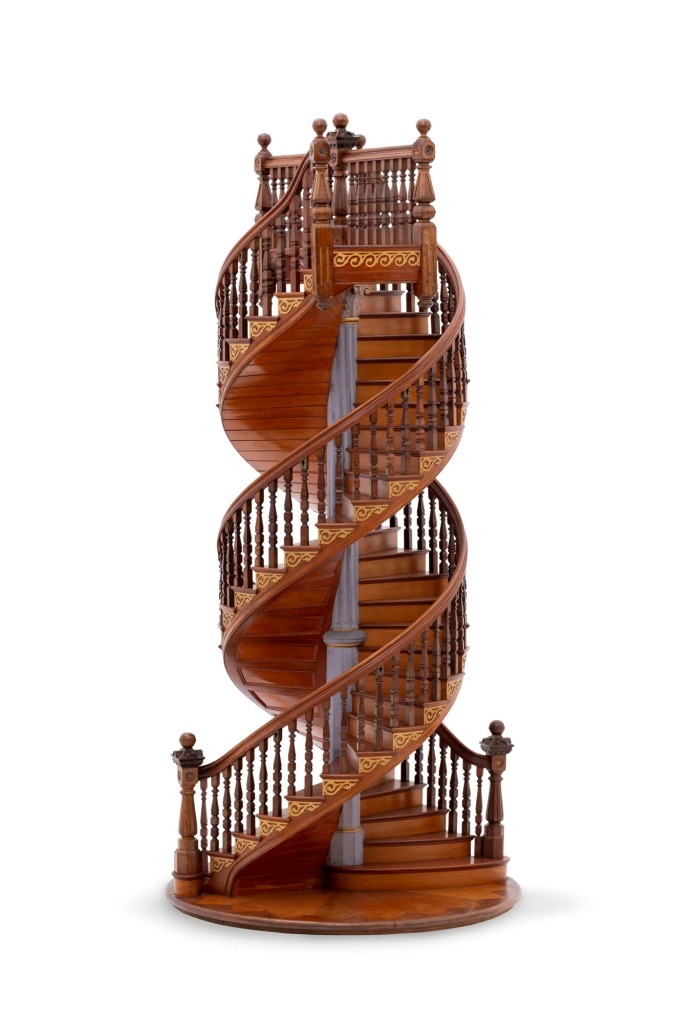
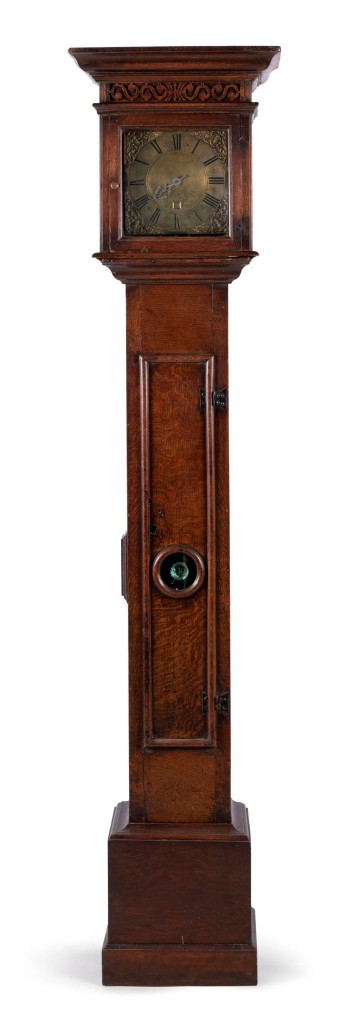
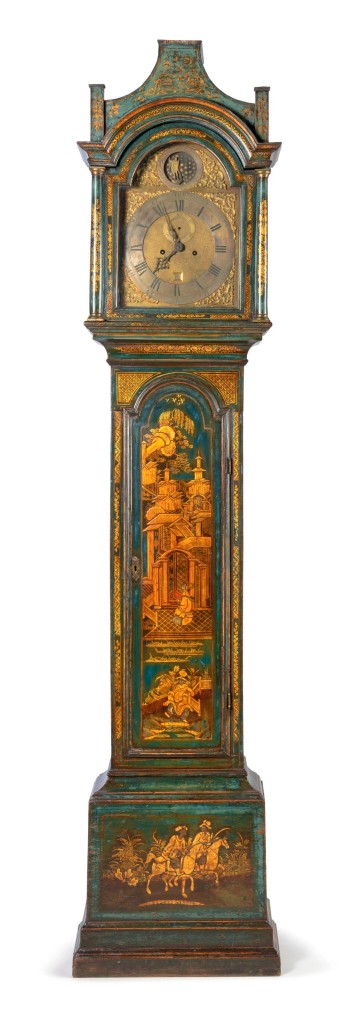



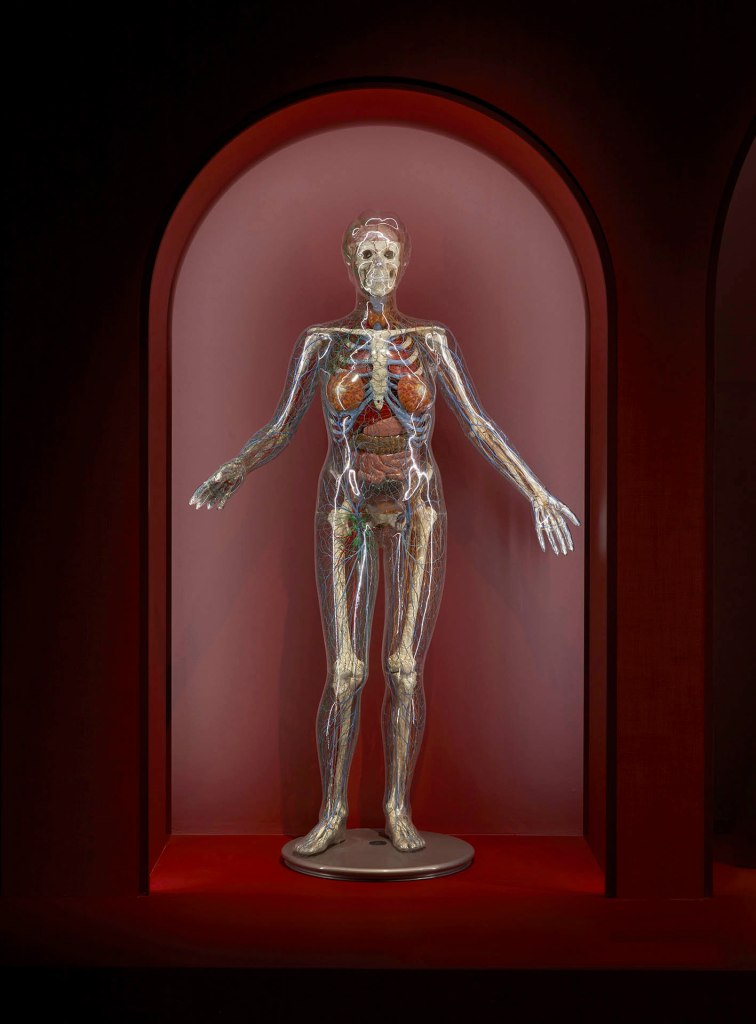

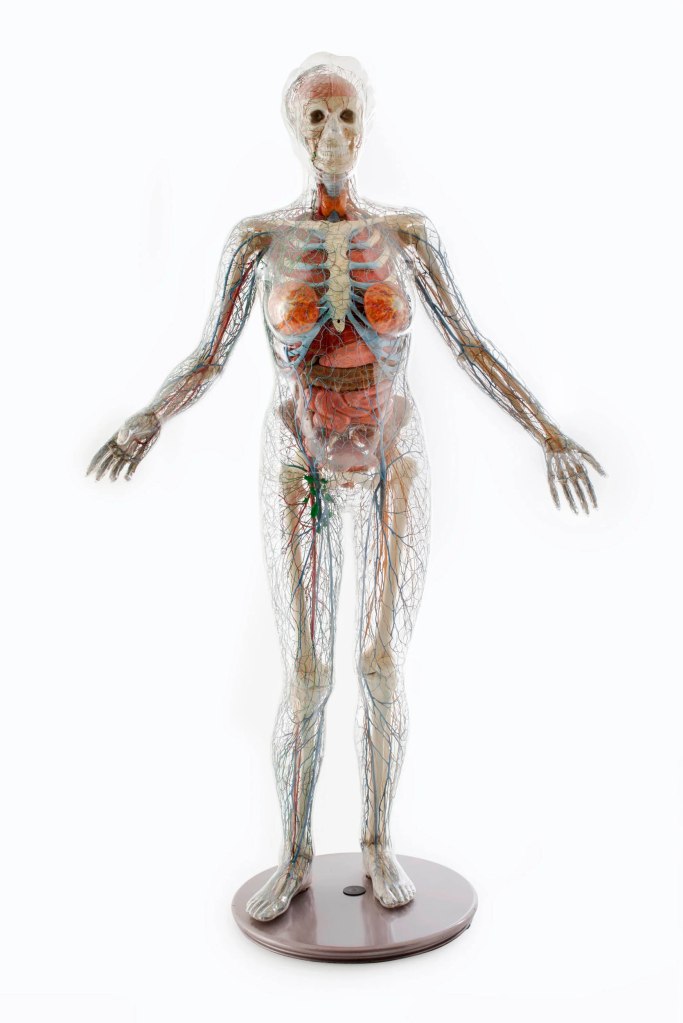
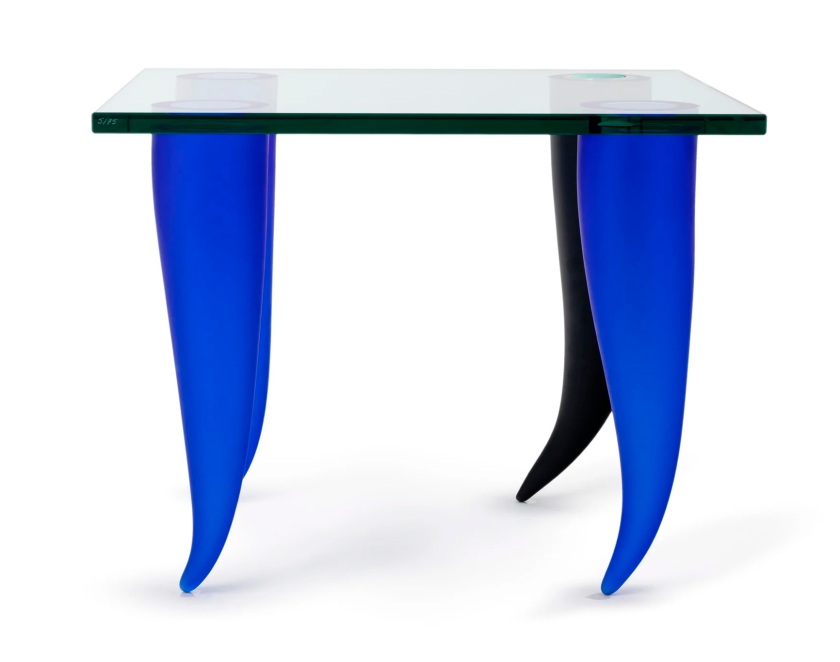
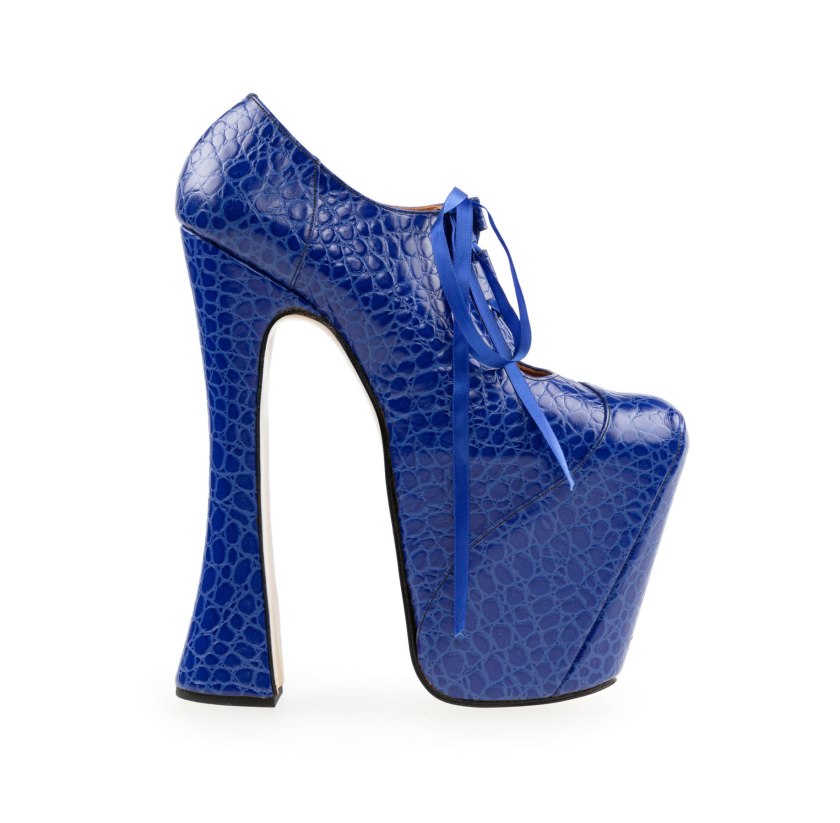
![J Hubert Newman (photographer, Sydney, New South Wales, Australia) (Australian, c. 1835-1916) 'Untitled [young boy in sailor suit]' Nd J Hubert Newman (photographer, Sydney, New South Wales, Australia) (Australian, c. 1835-1916) 'Untitled [young boy in sailor suit]' Nd](https://artblart.files.wordpress.com/2023/10/newman-young-boy-in-sailor-suit.jpg?w=720&h=1024)

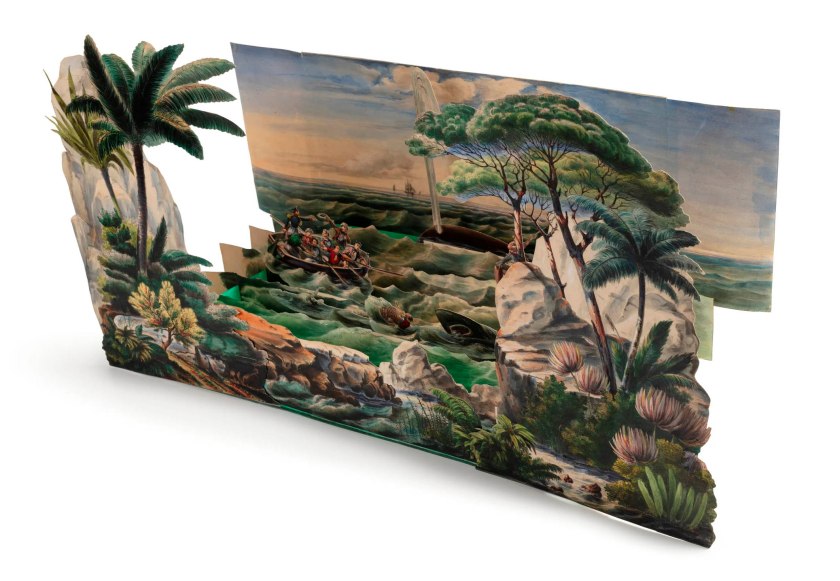
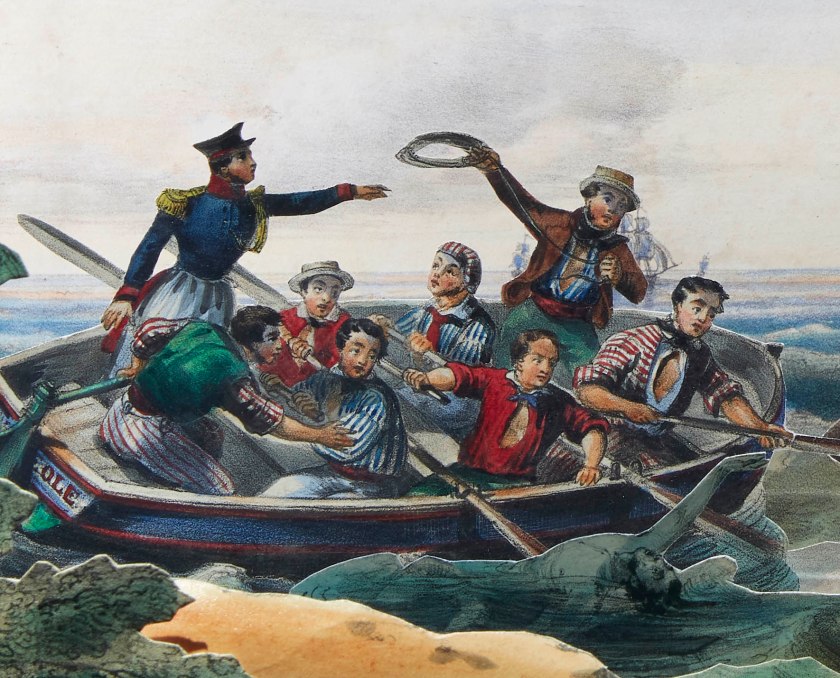

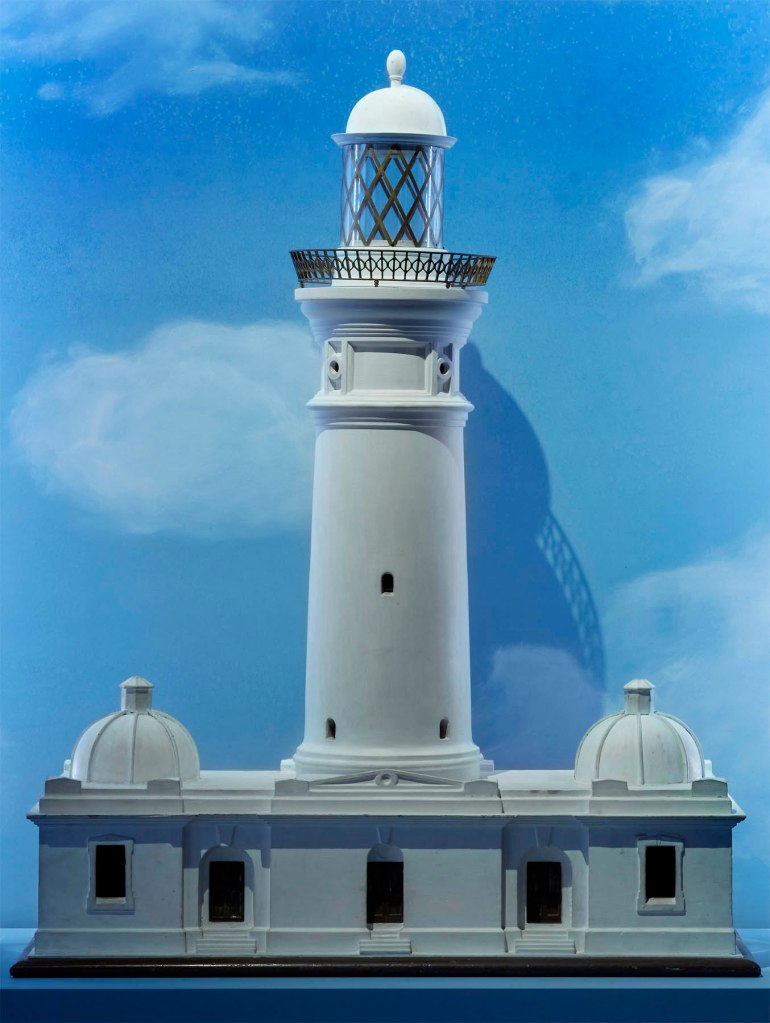
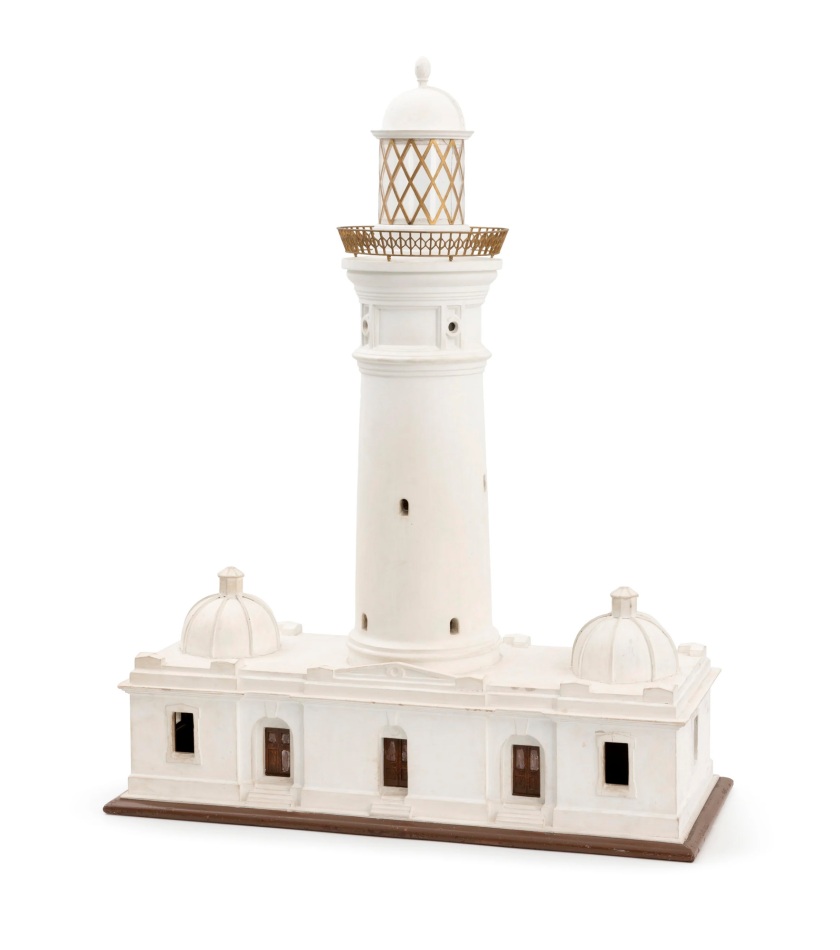
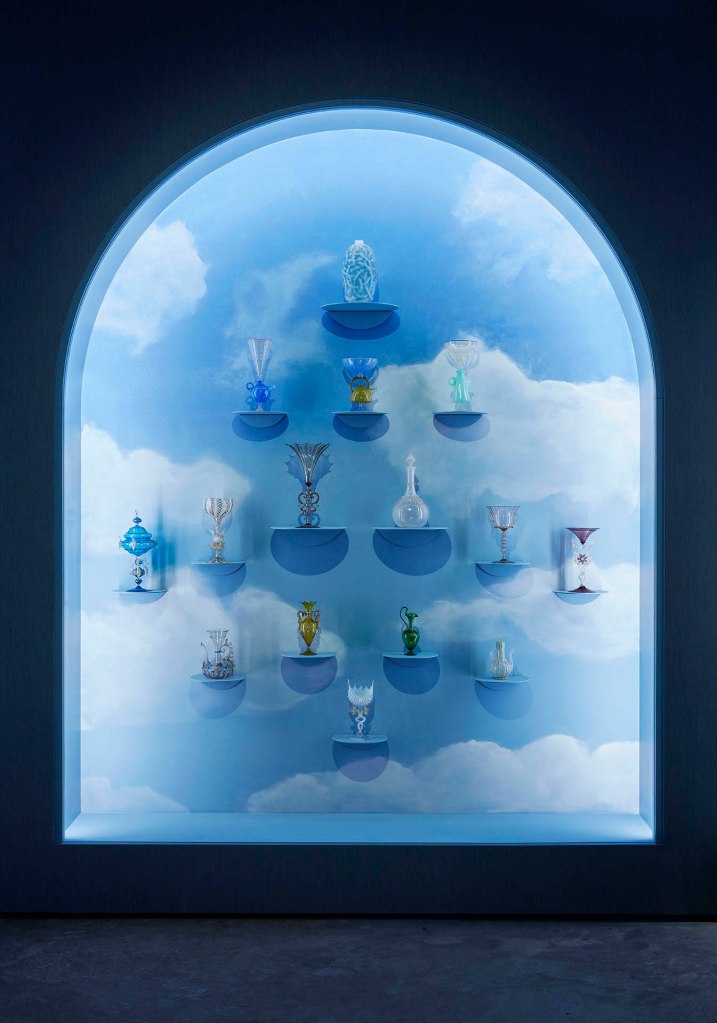
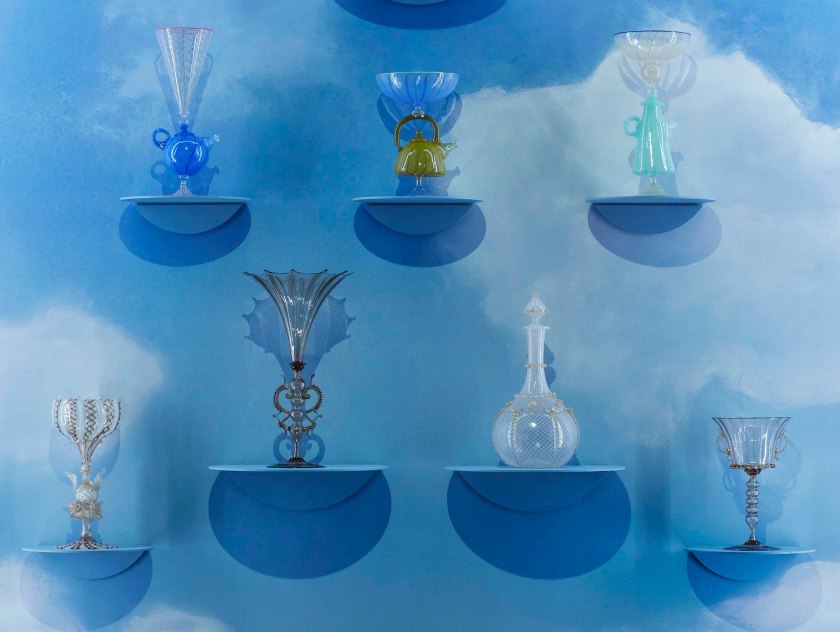

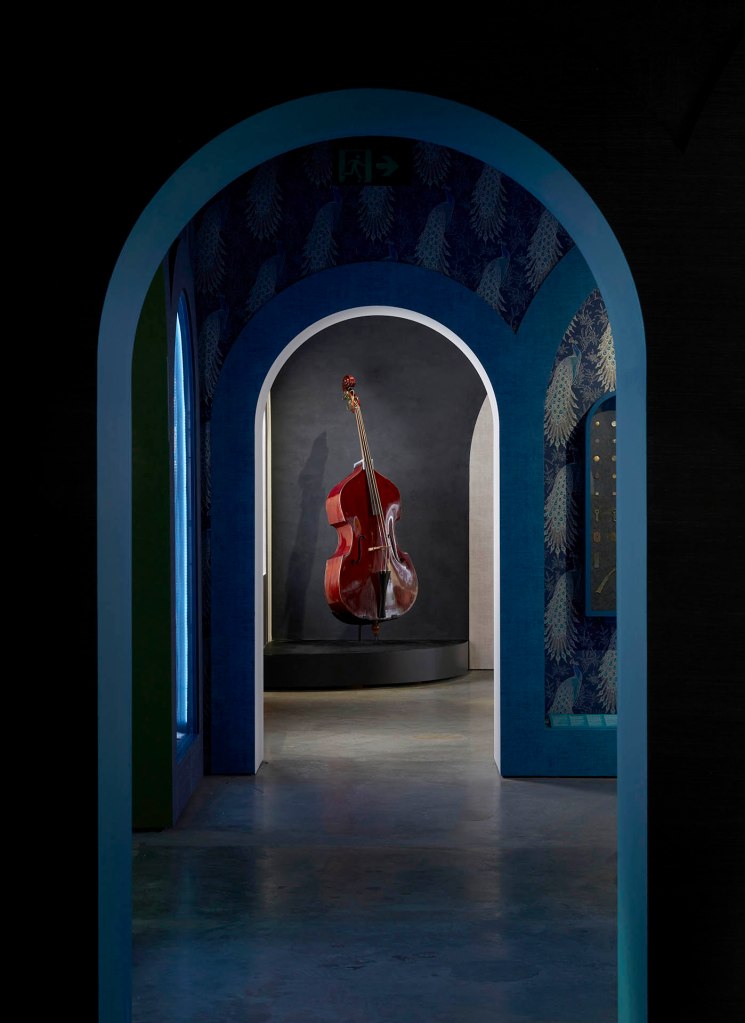


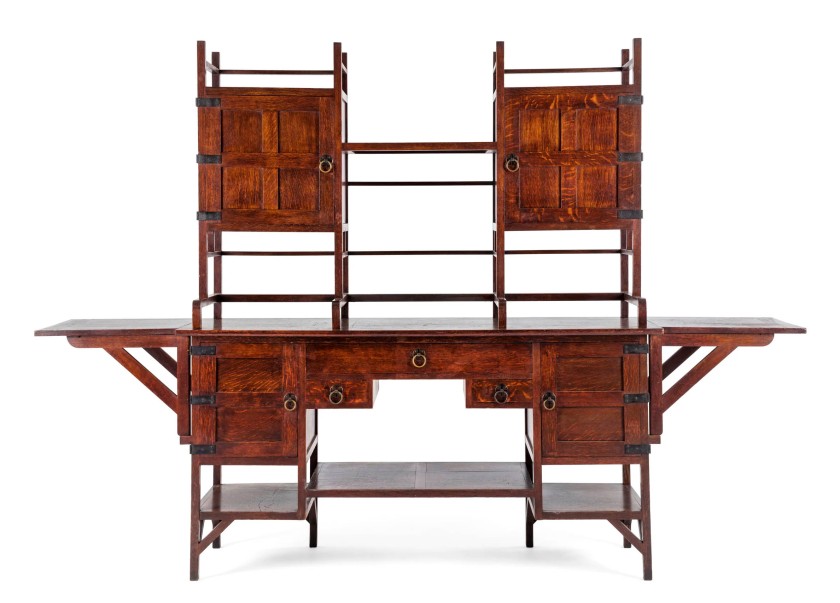
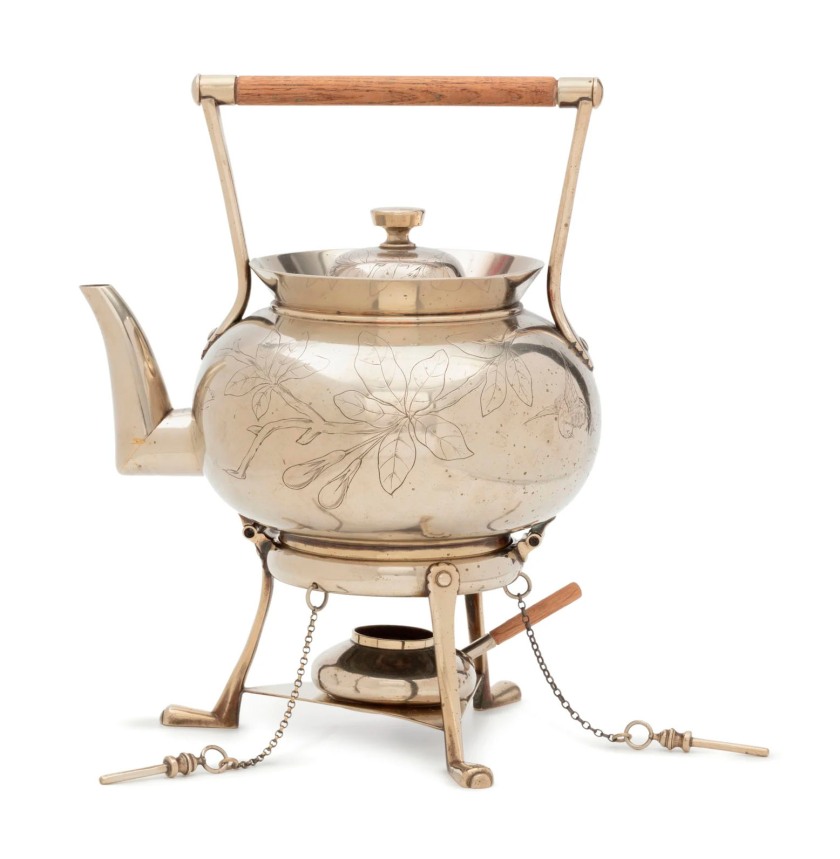
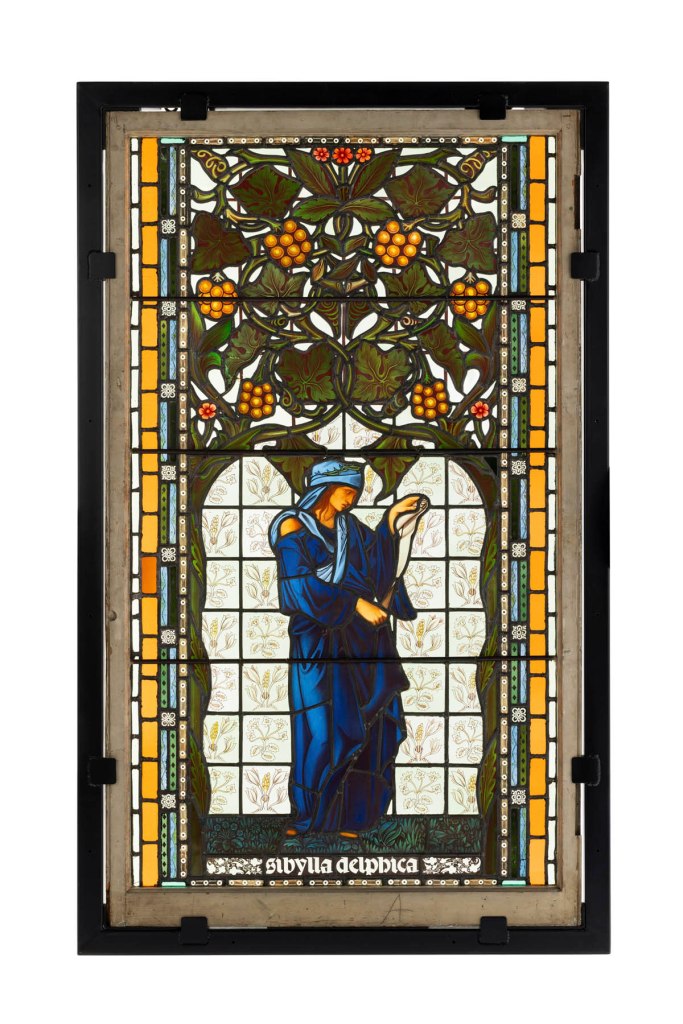
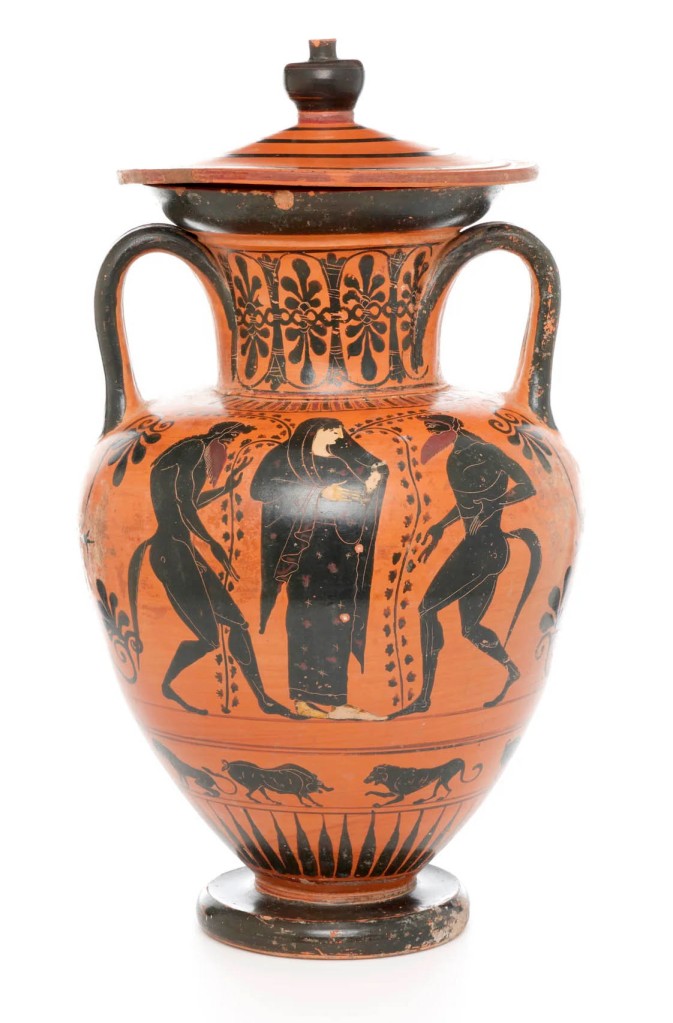

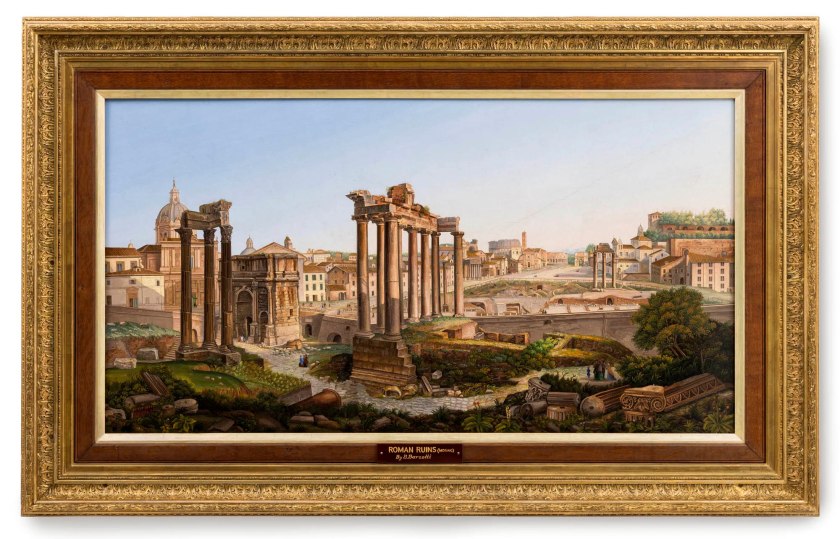

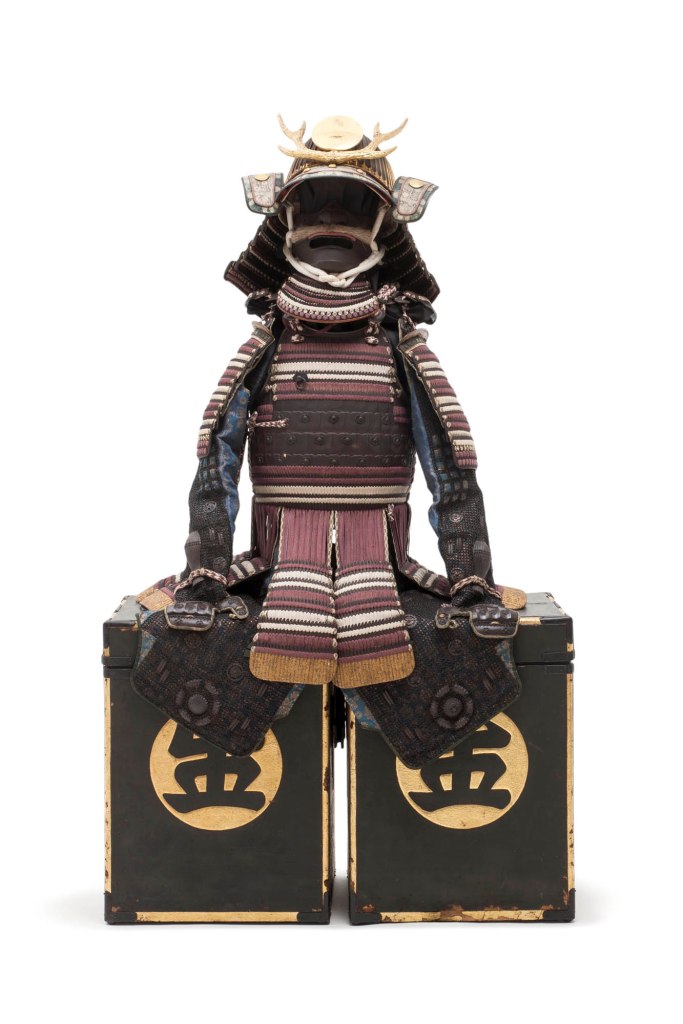
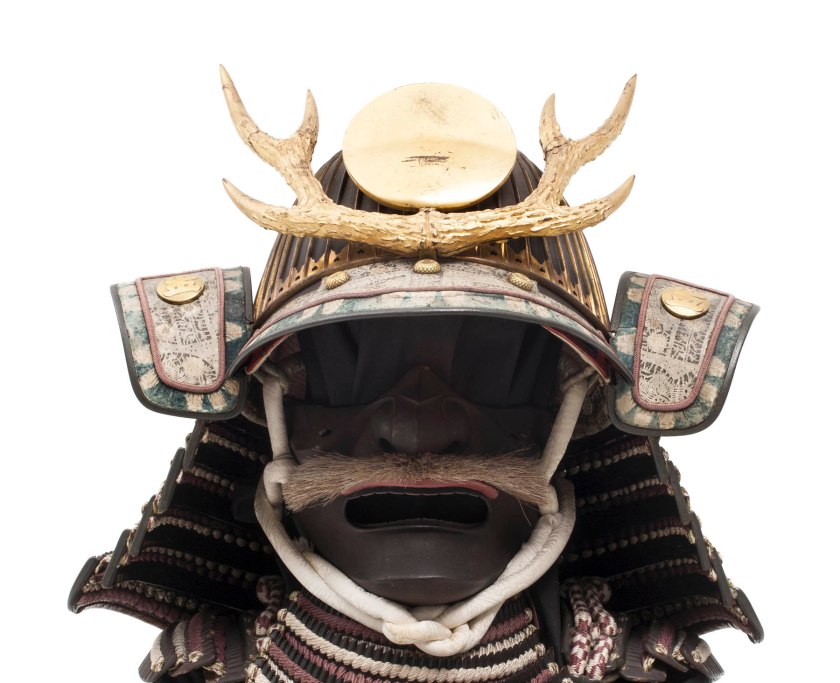


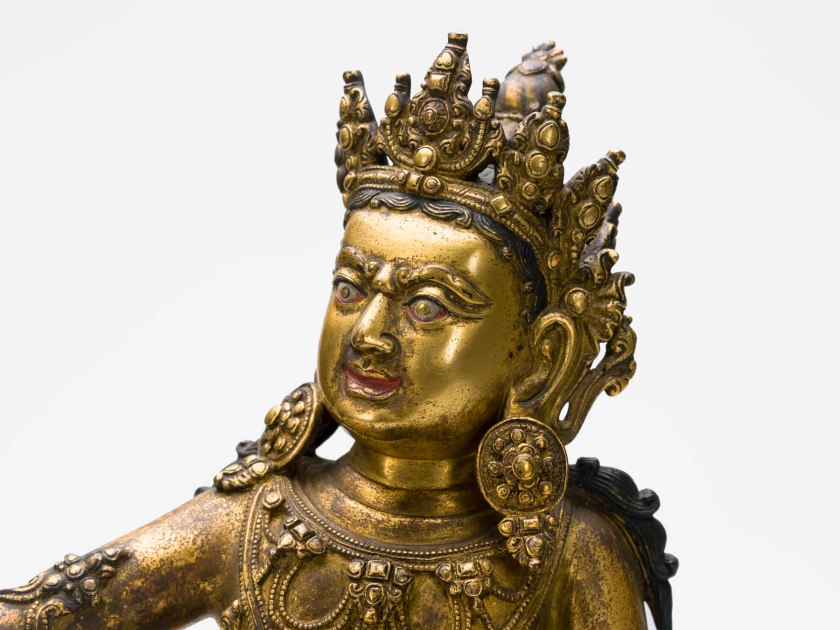


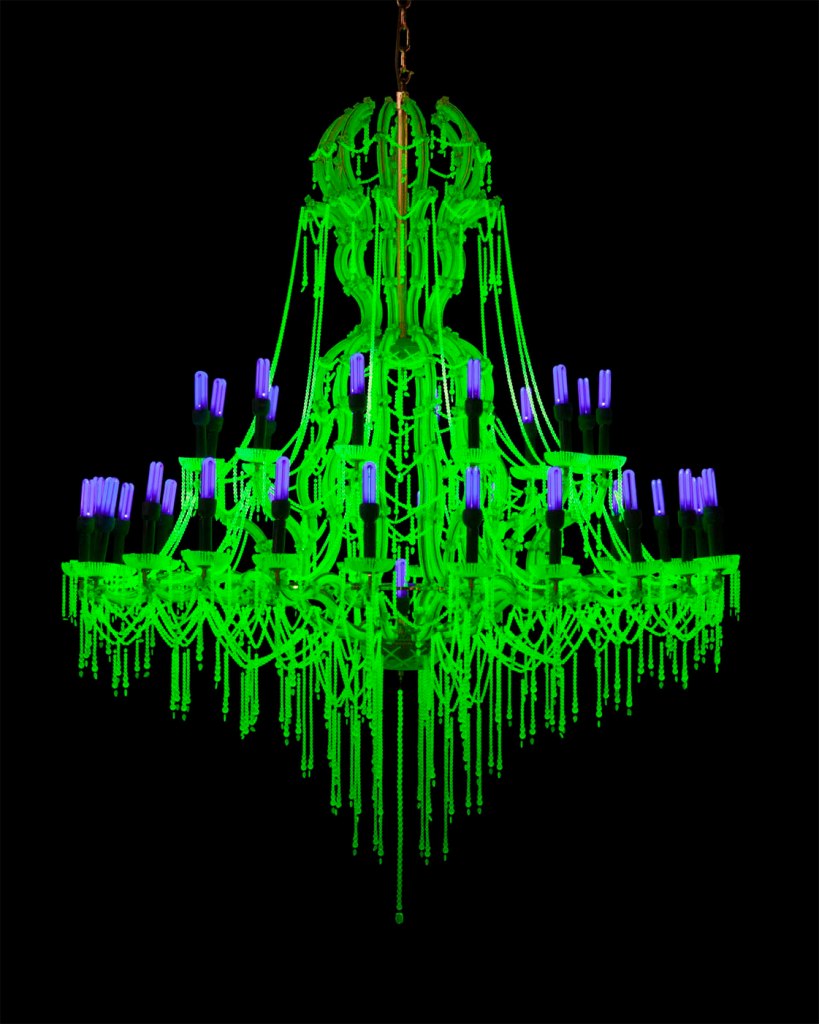

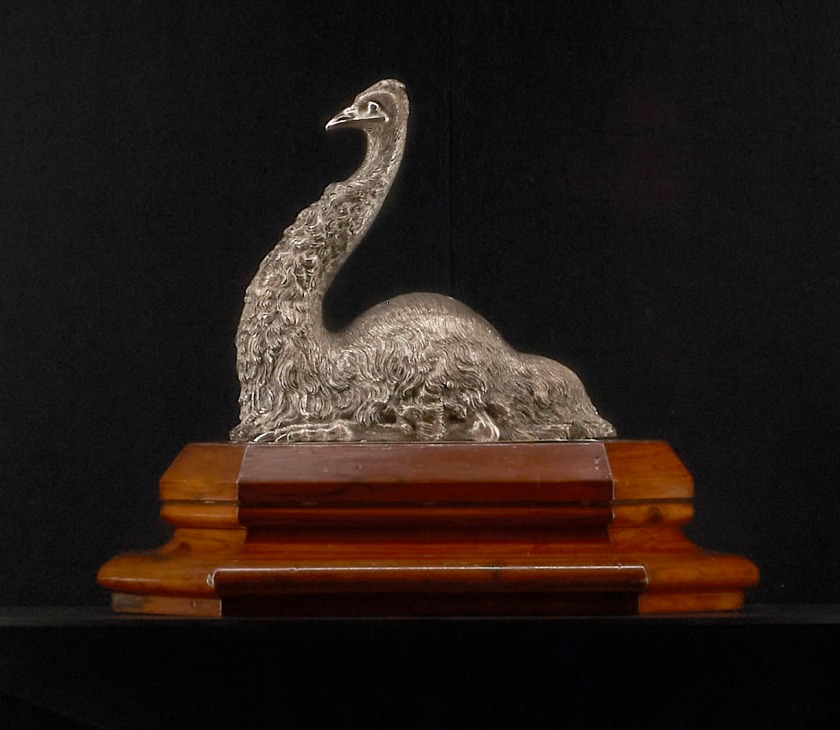

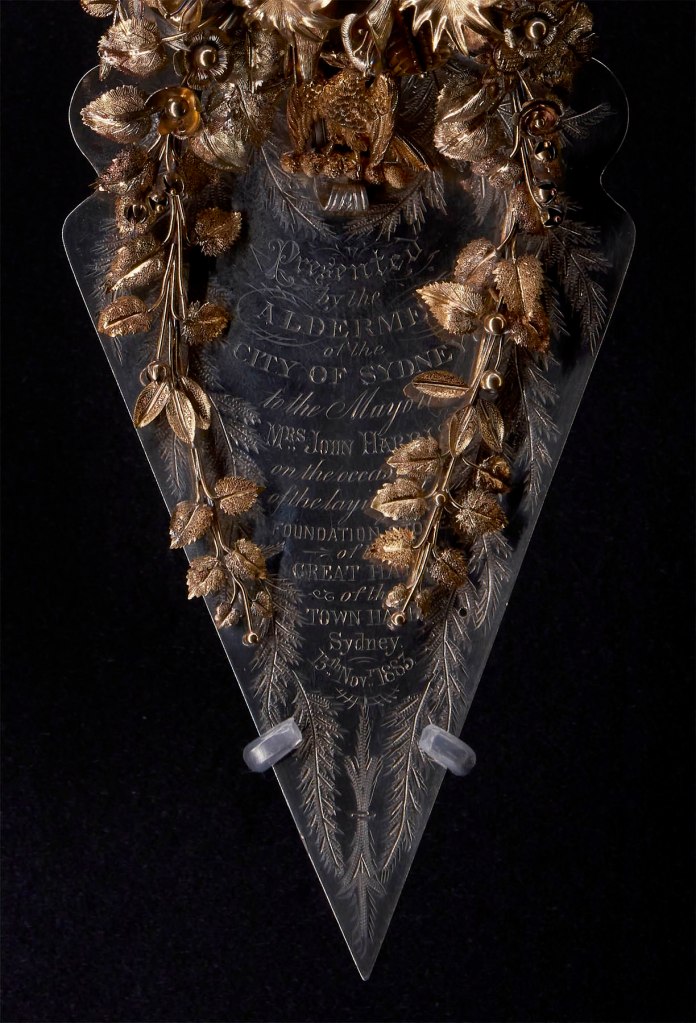

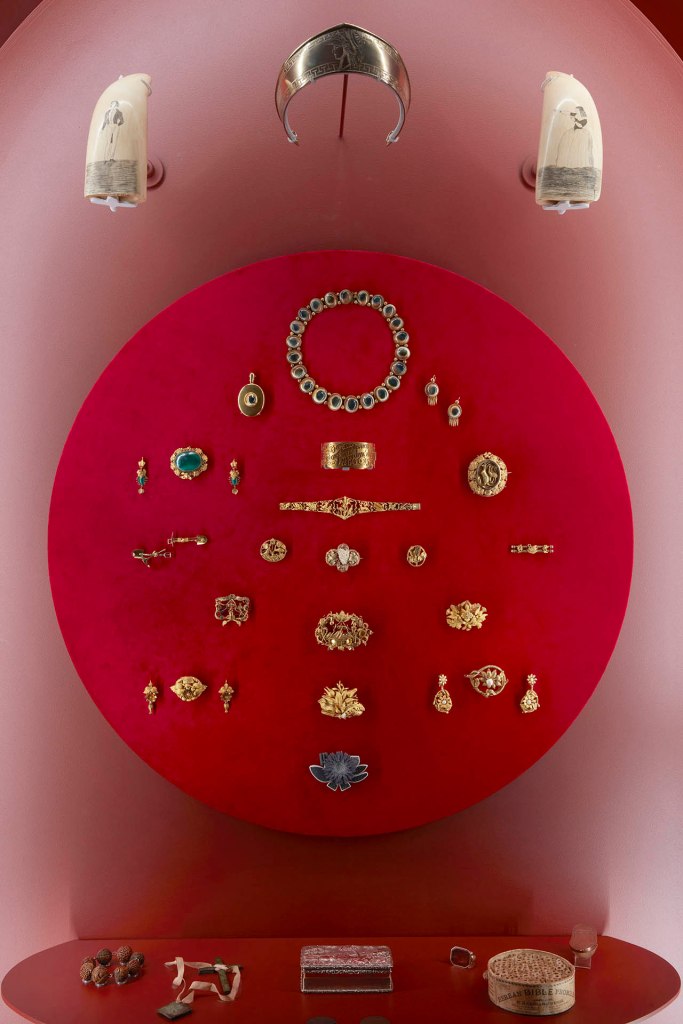
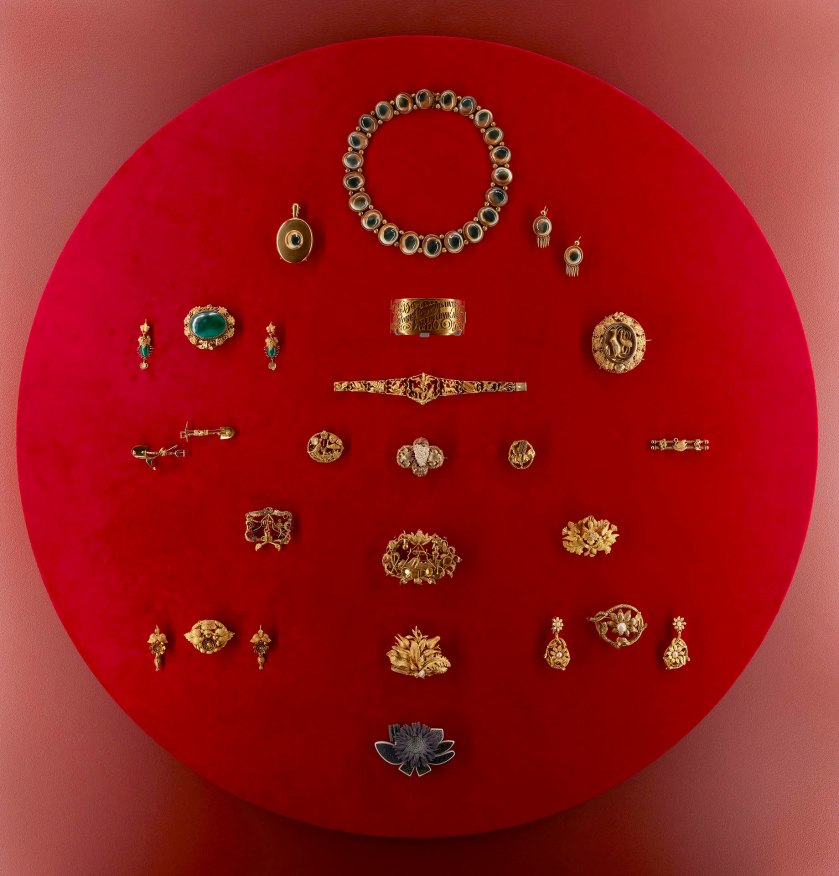
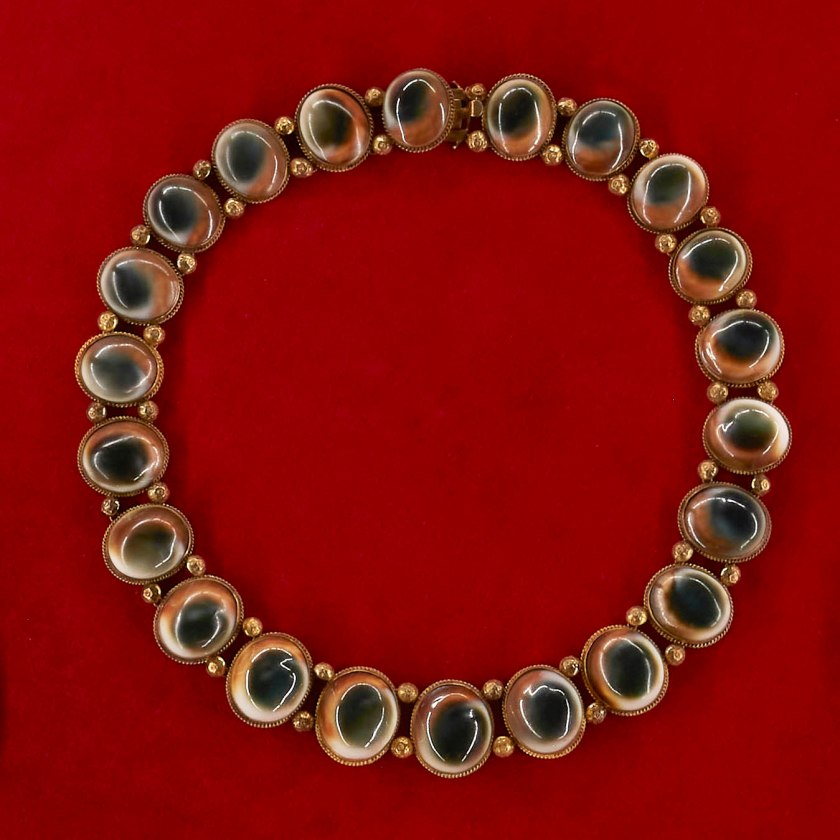

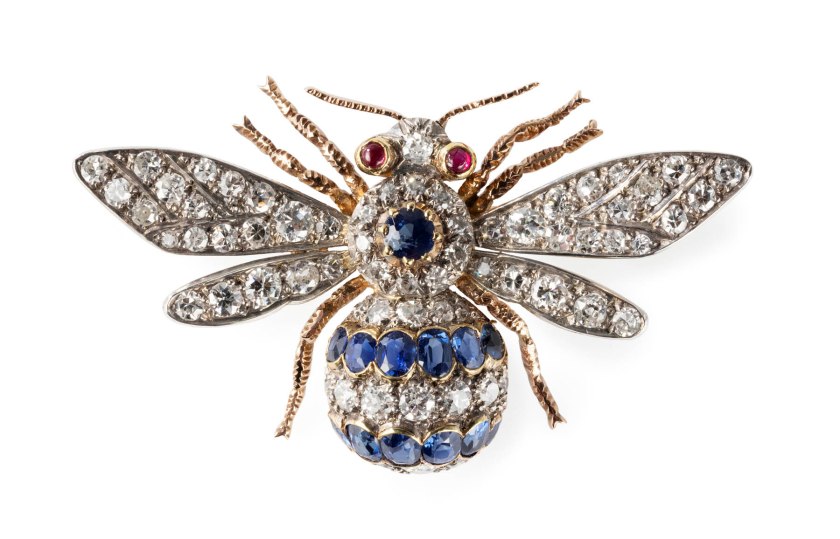


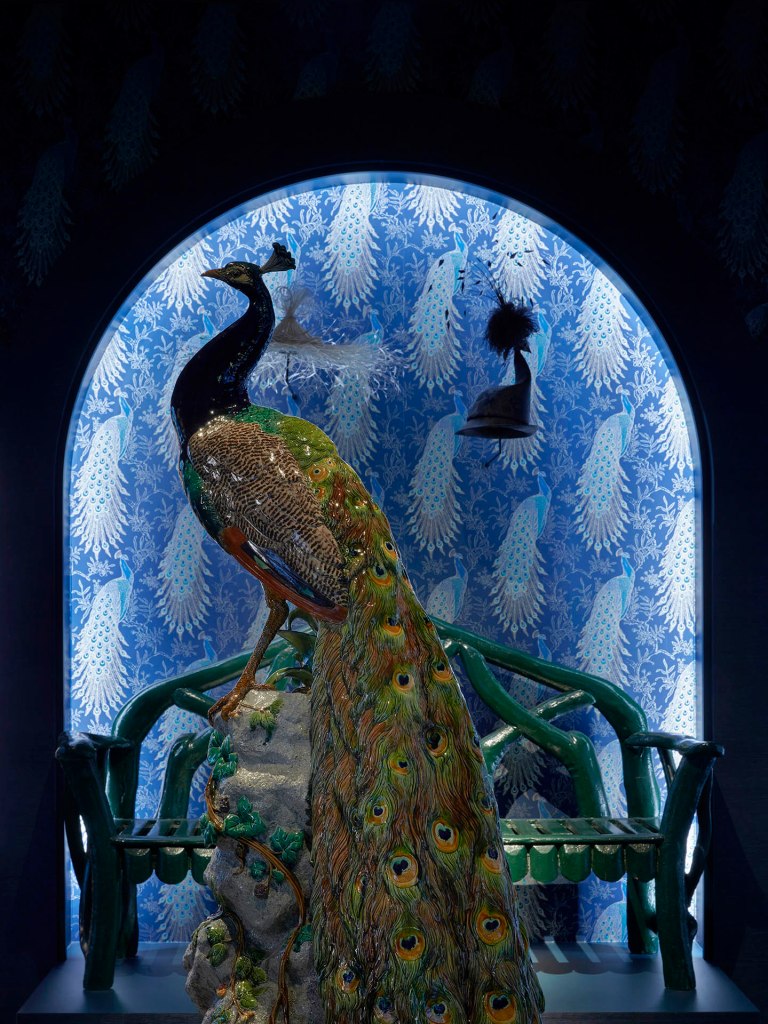
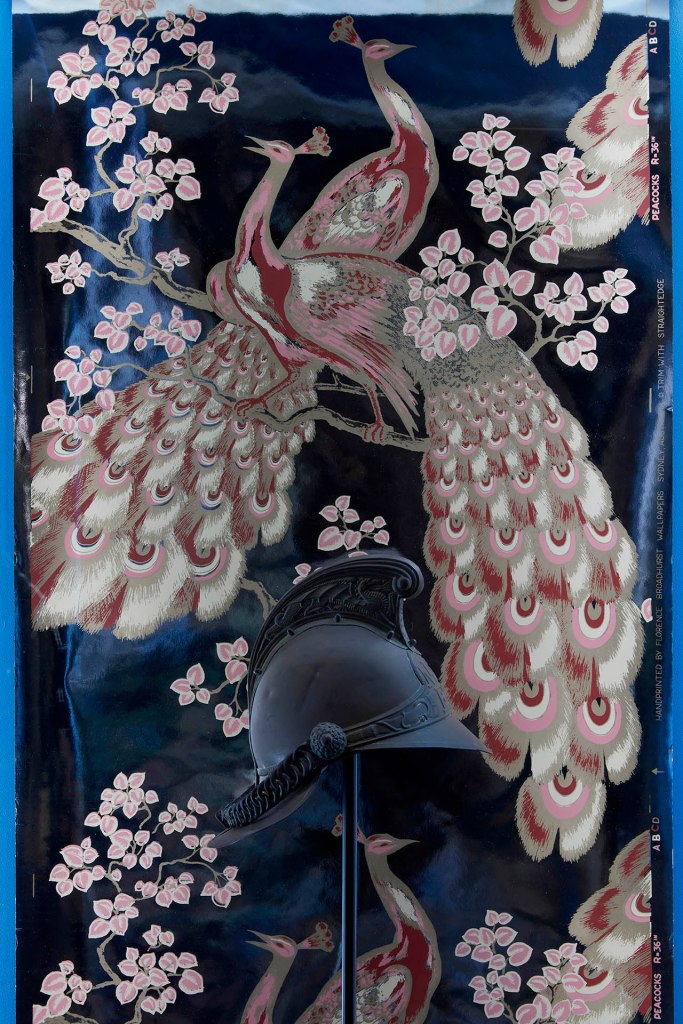



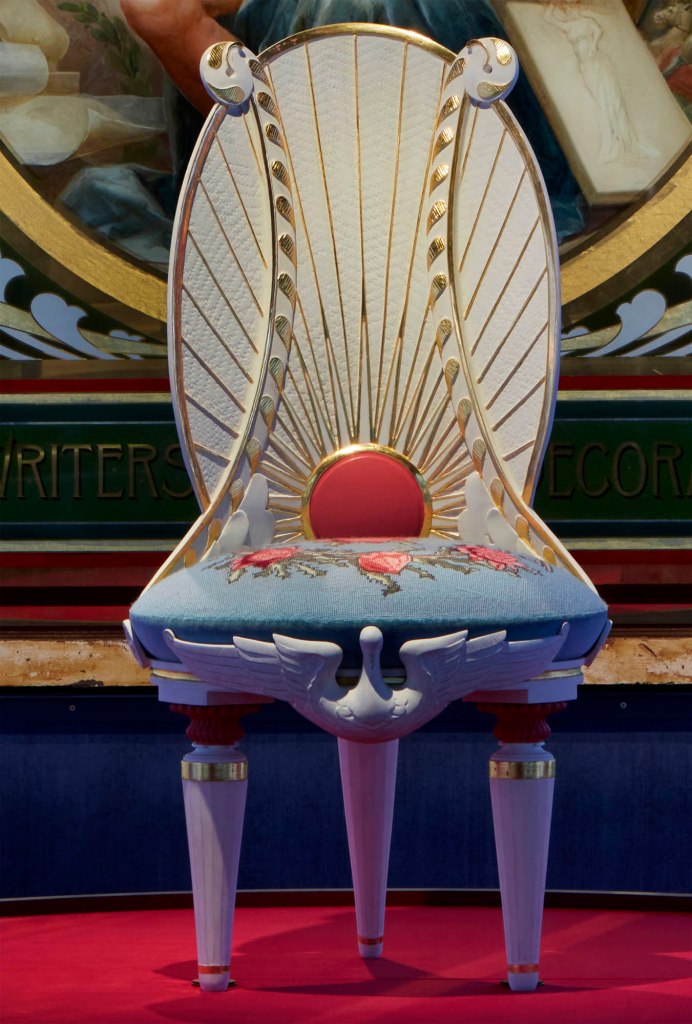
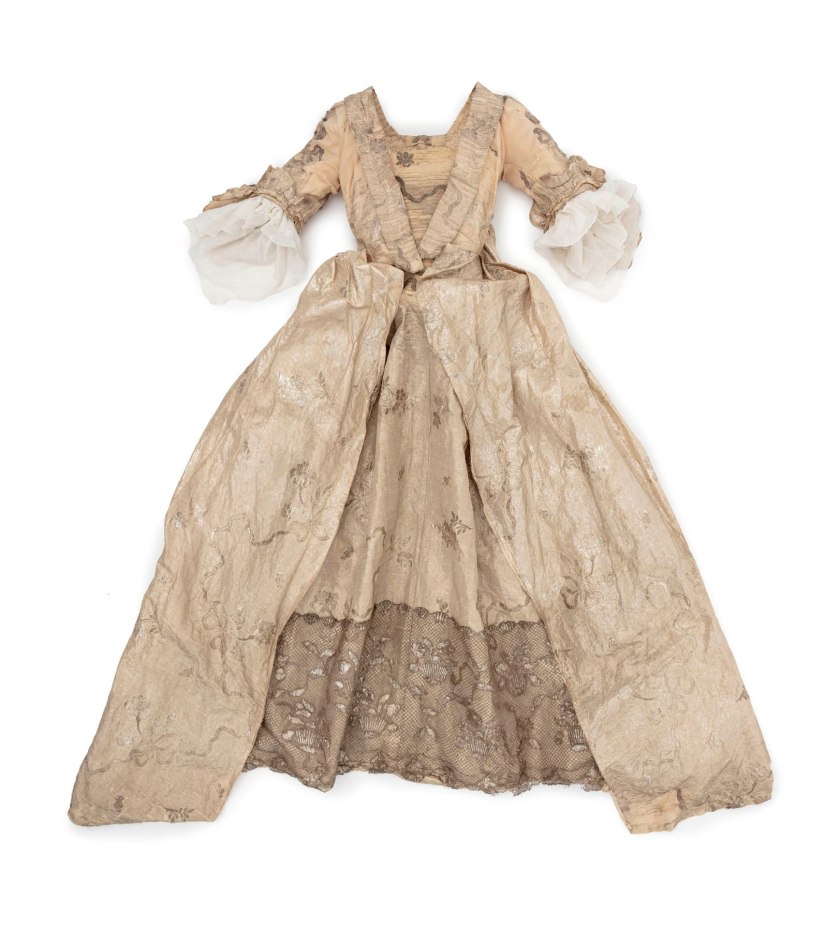


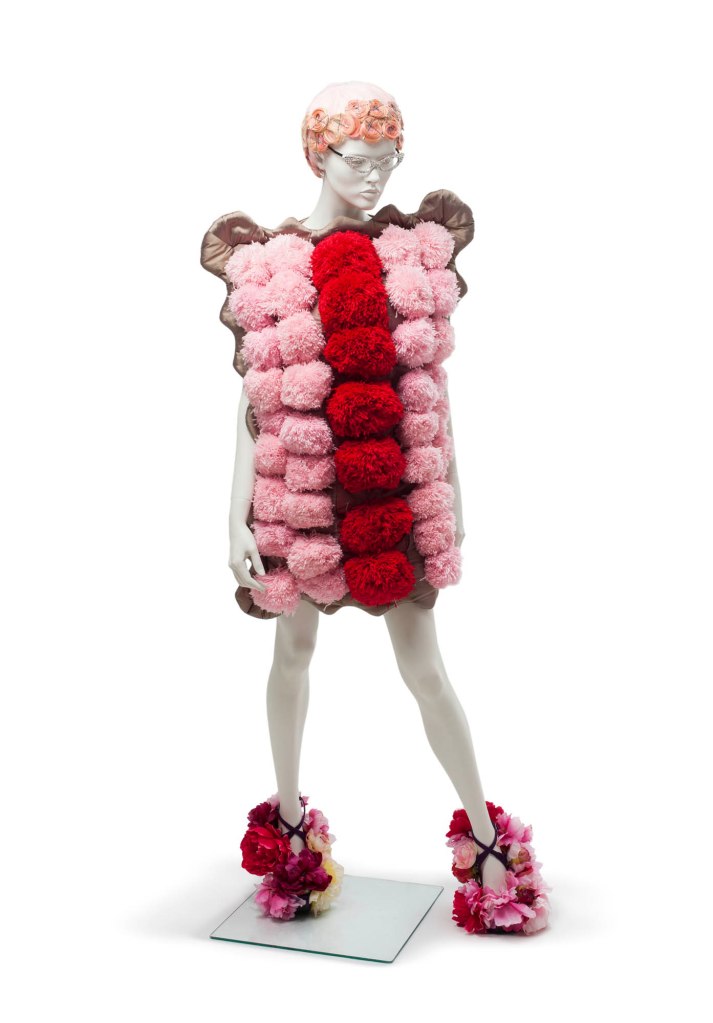




























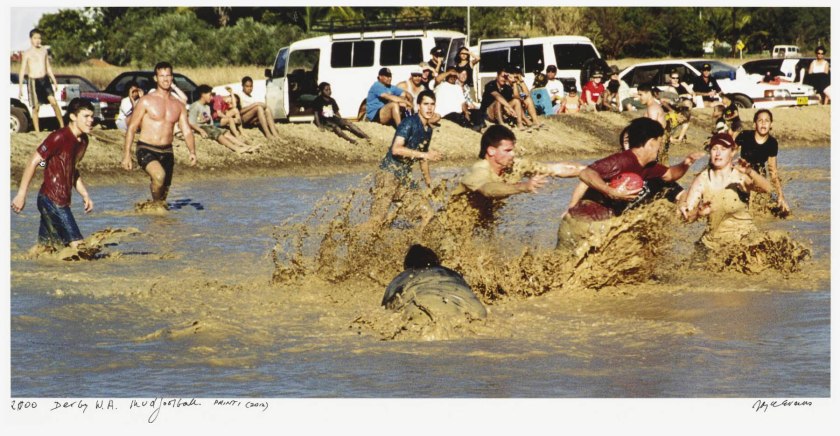









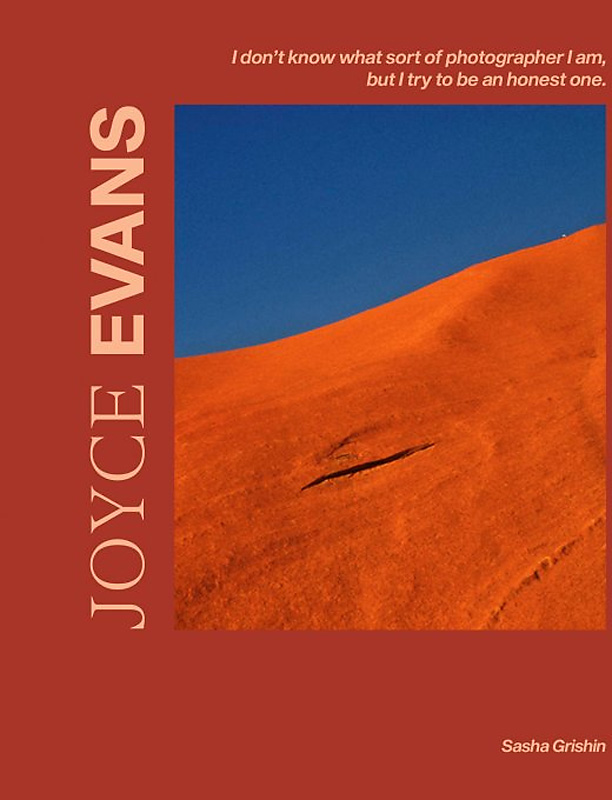










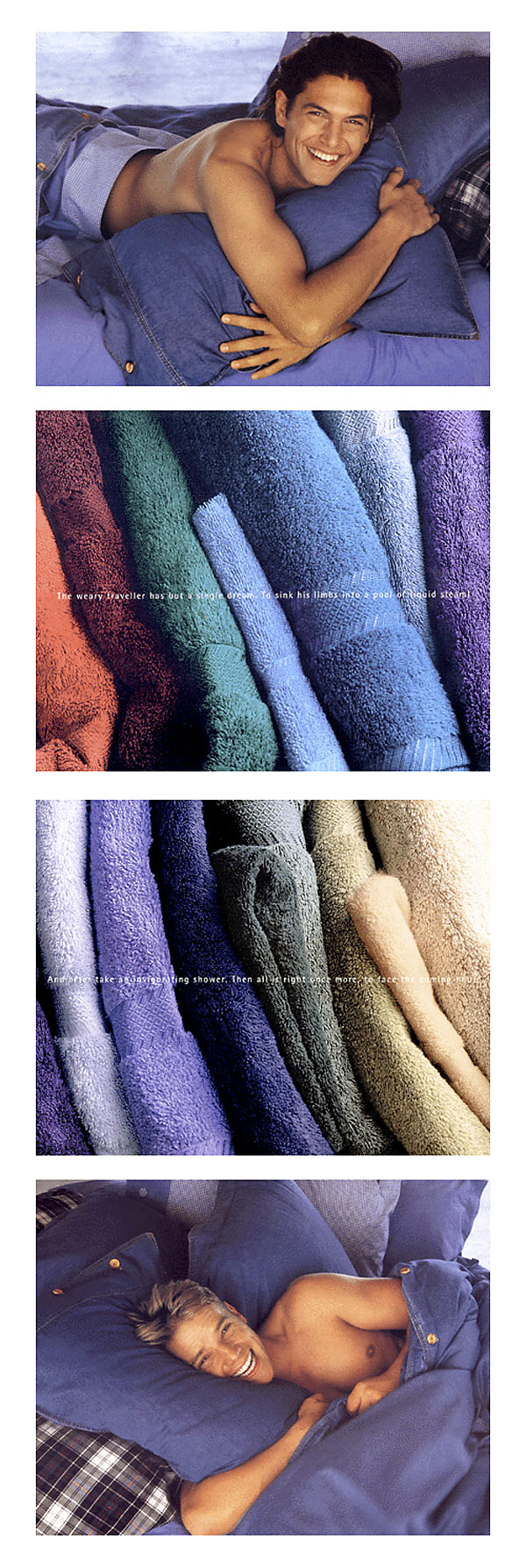





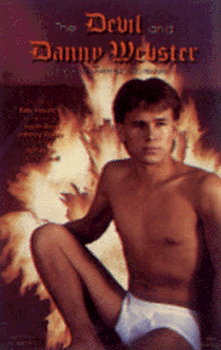




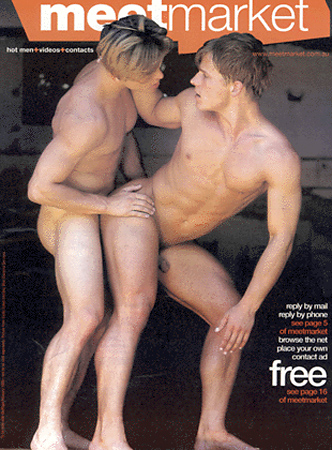


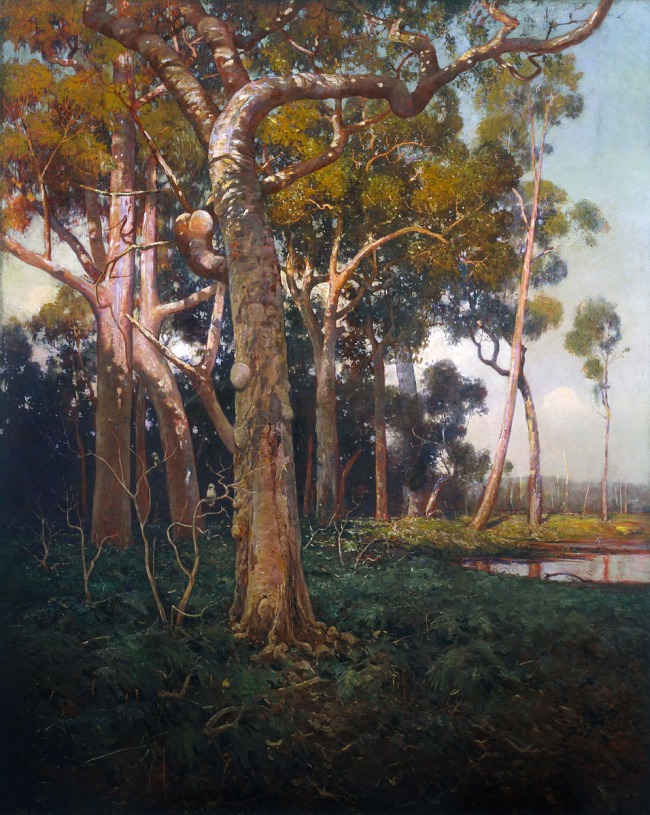











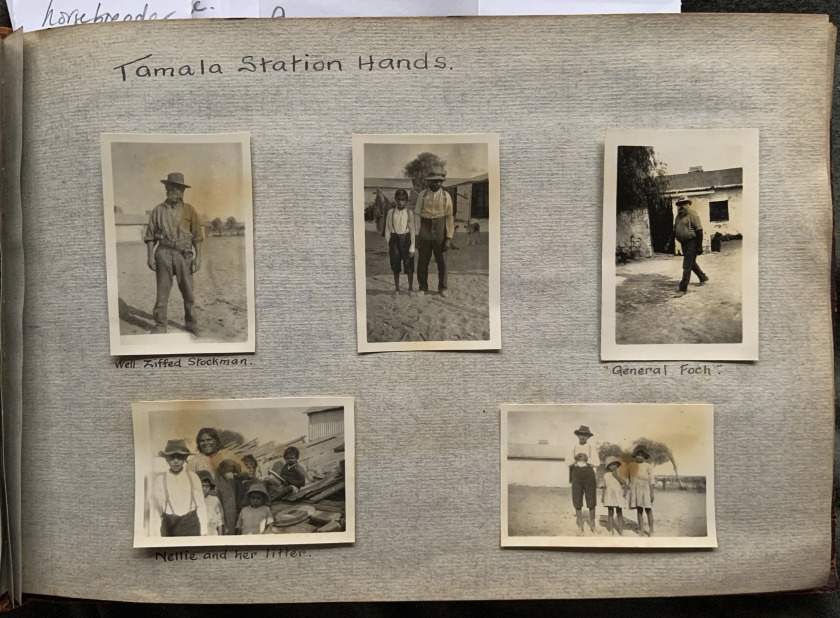





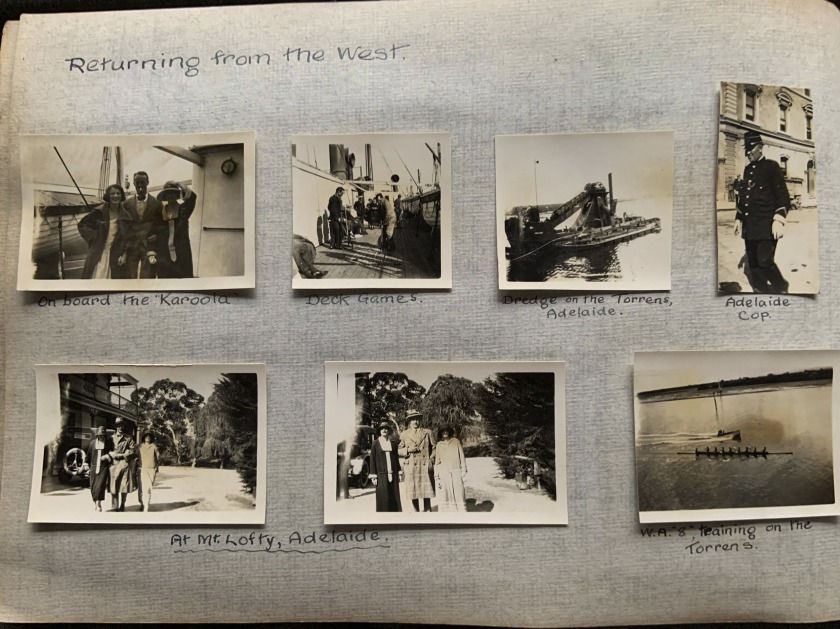


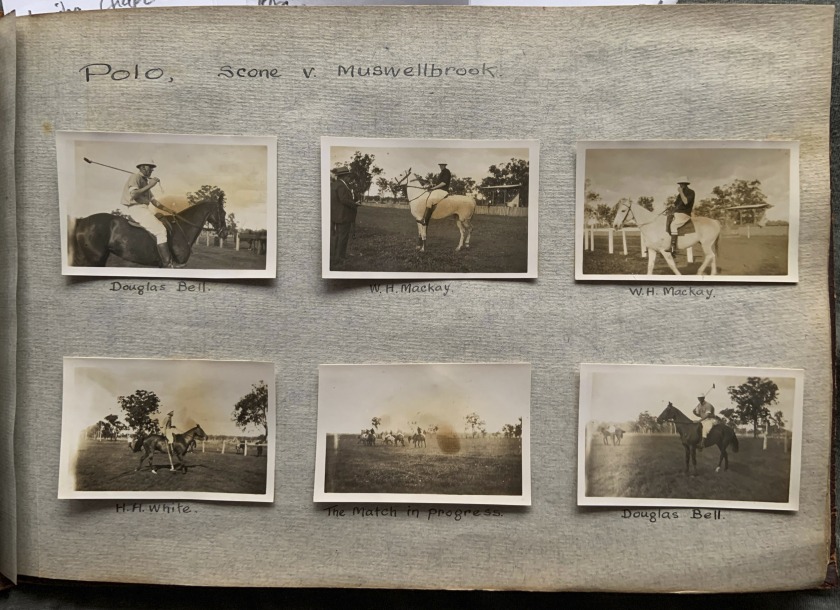




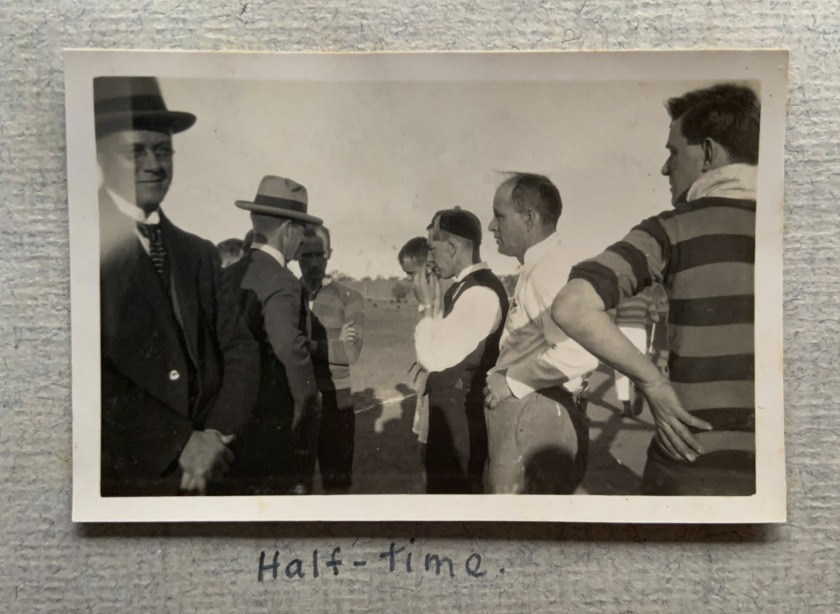


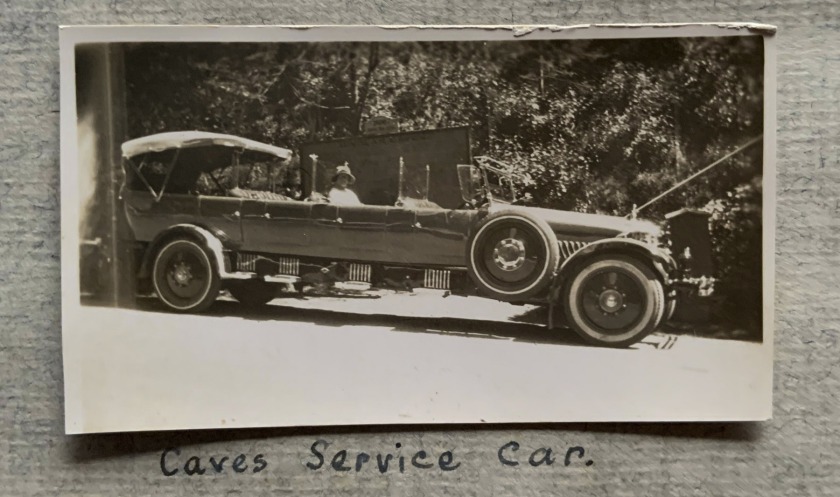


















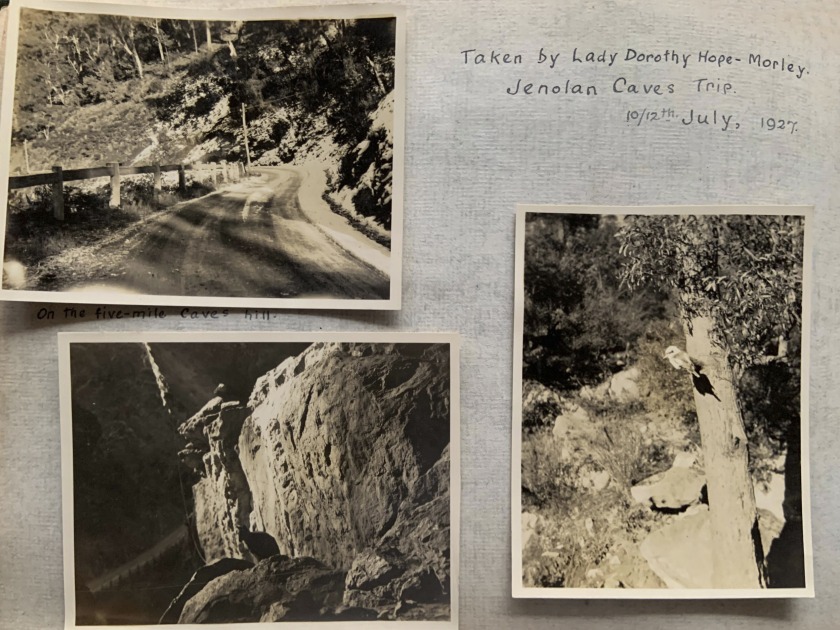


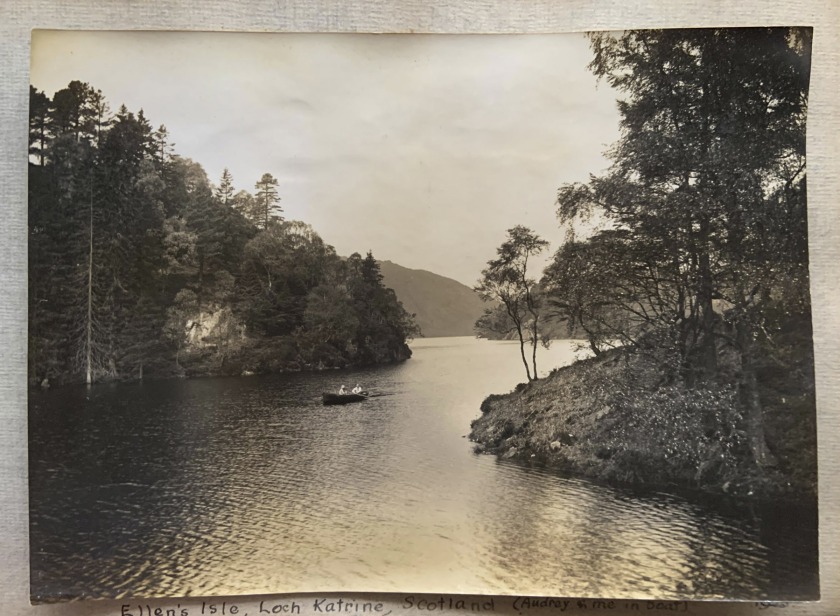


















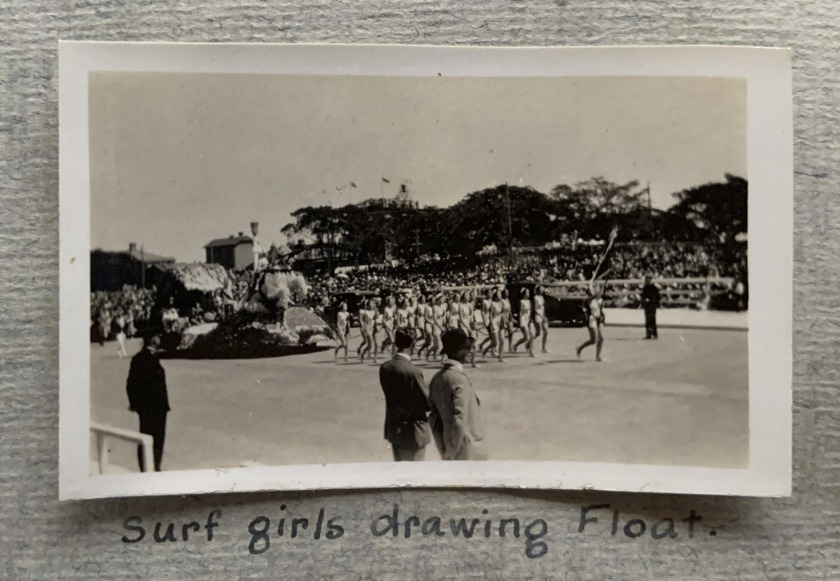
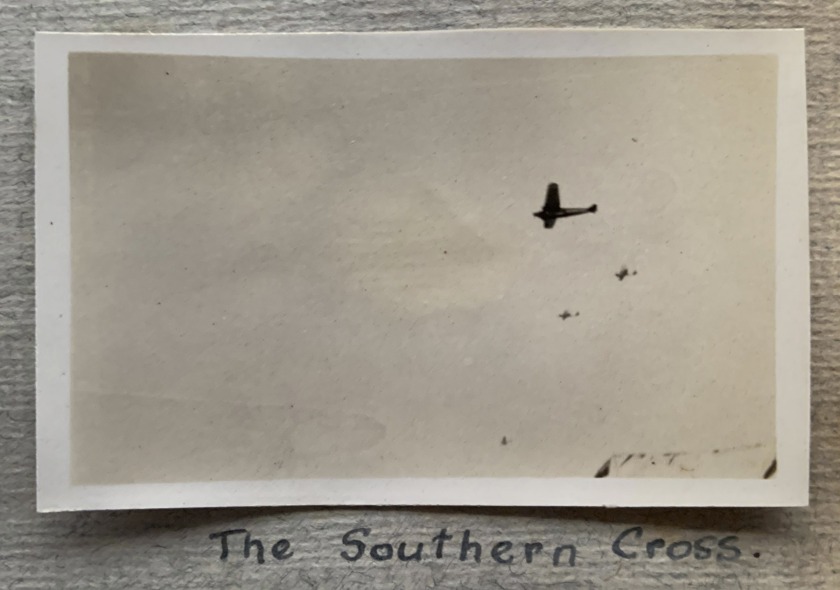








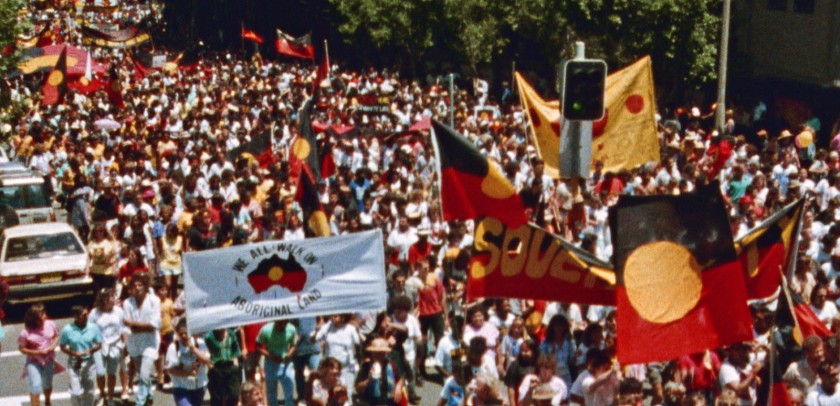
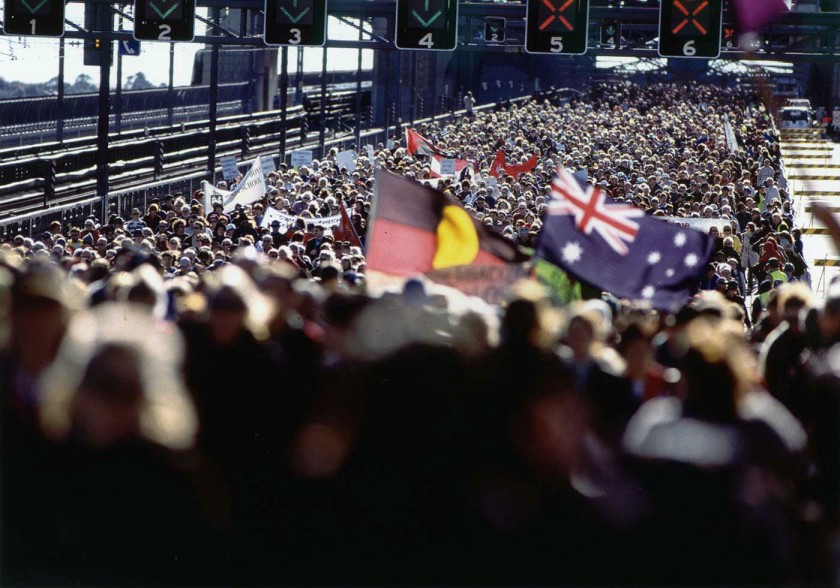
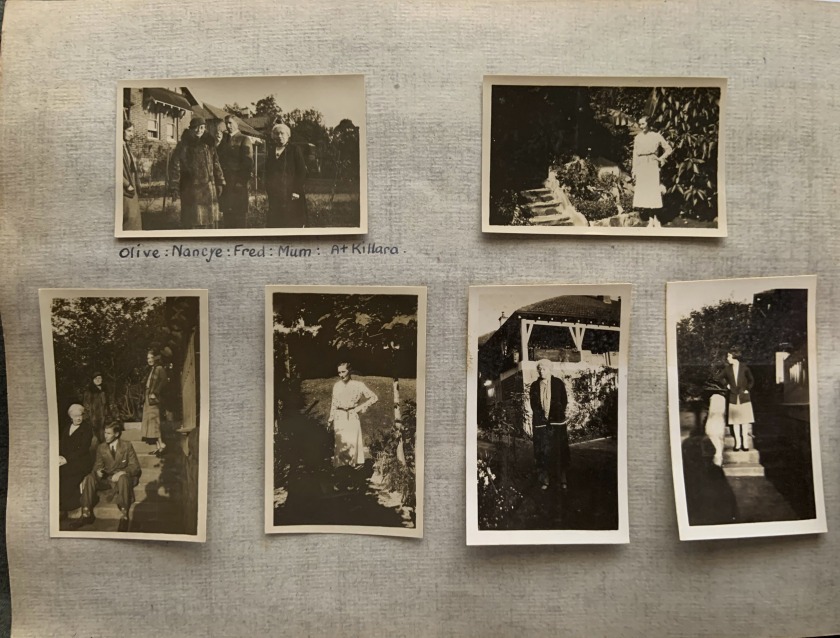









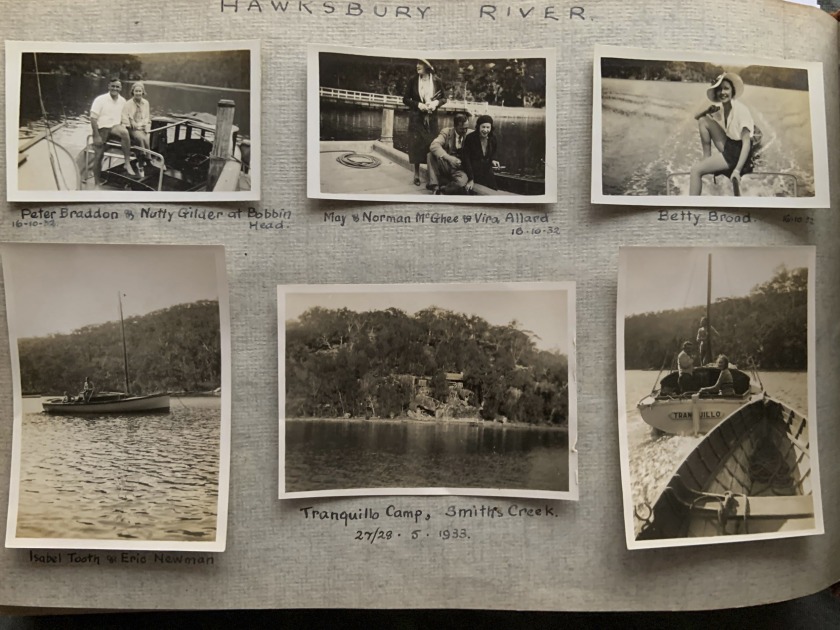














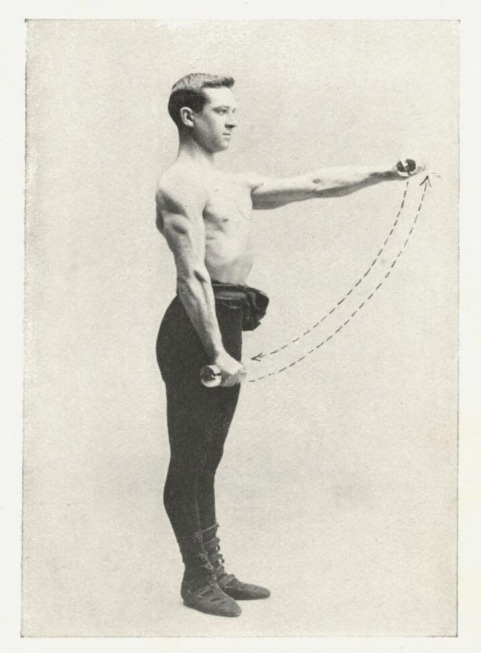
![Anonymous photographer. 'Untitled [Gym group possibly German/Prussian]' c. 1890-1910 Anonymous photographer. 'Untitled [Gym group possibly German/Prussian]' c. 1890-1910](https://artblart.files.wordpress.com/2022/11/gym-group-1.jpg?w=840)










![Anonymous. 'Untitled [Posing straps]' 1952 Anonymous. 'Untitled [Posing straps]' 1952](https://artblart.files.wordpress.com/2022/11/posing-strap.jpg?w=840)






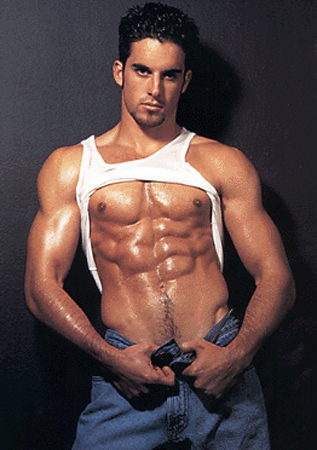


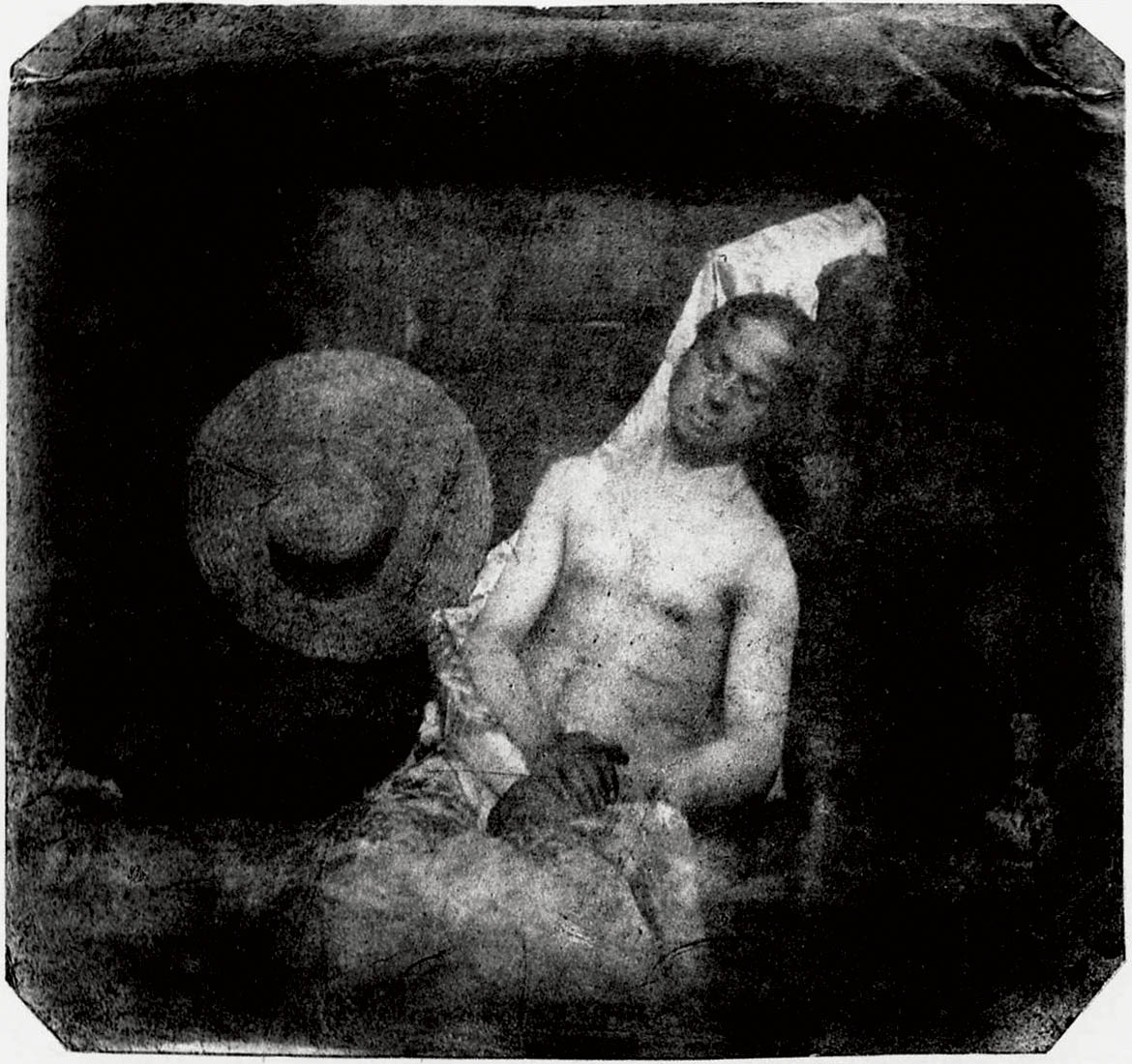



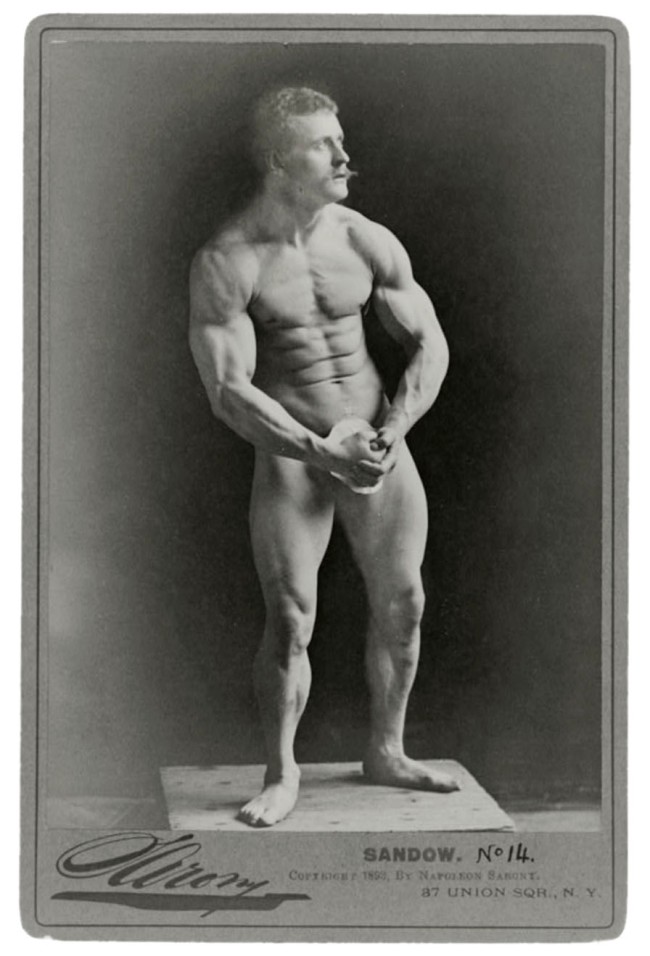
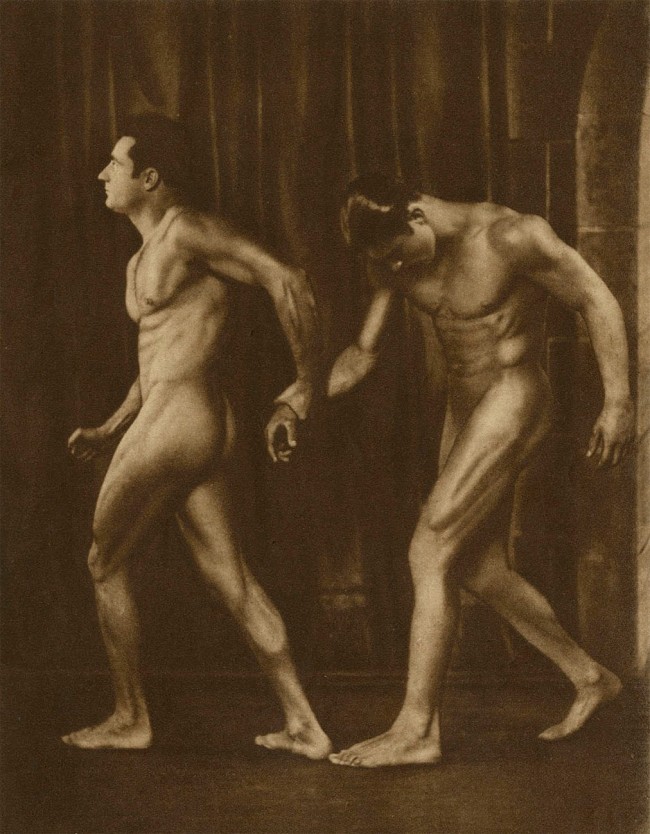










![George Platt Lynes. 'Untitled [Charles 'Tex' Smutney, Charles 'Buddy' Stanley, and Bradbury Ball]' c. 1942 George Platt Lynes. 'Untitled [Charles 'Tex' Smutney, Charles 'Buddy' Stanley, and Bradbury Ball]' c. 1942](https://artblart.files.wordpress.com/2014/06/lynes-c-1942.jpg?w=840)



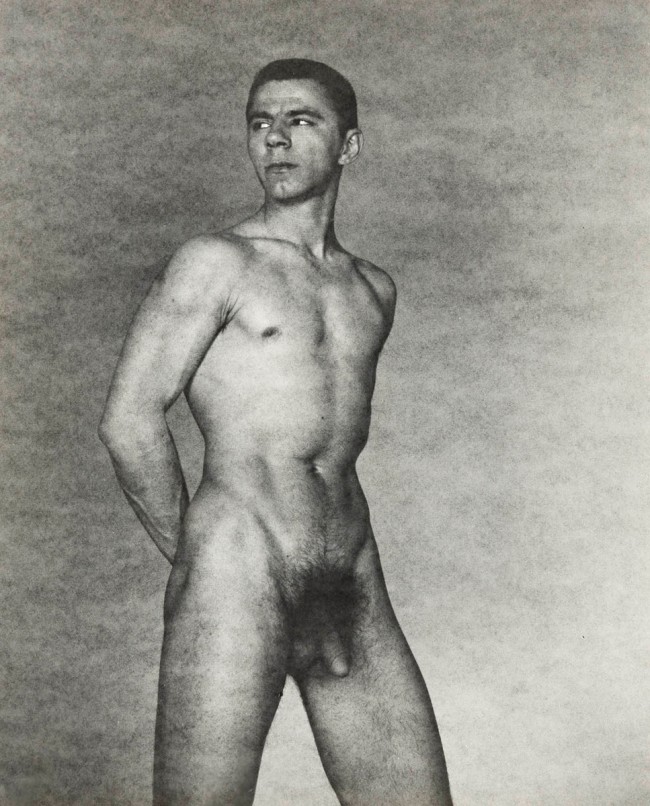

















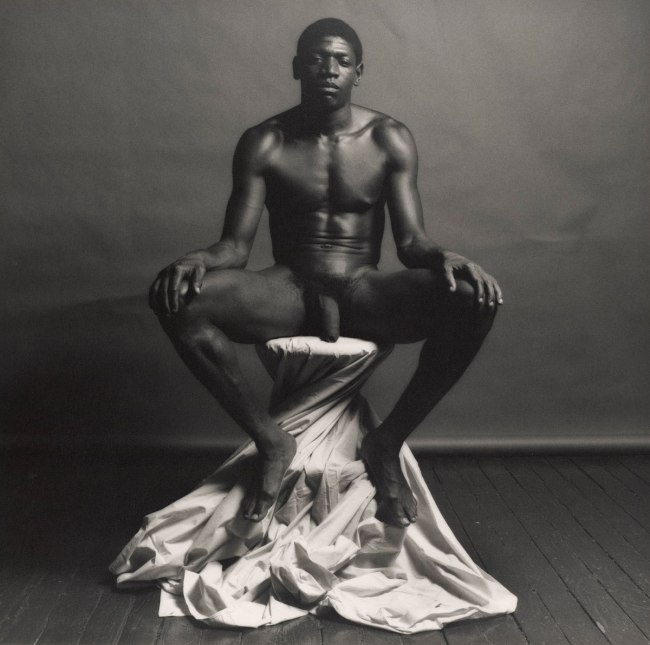














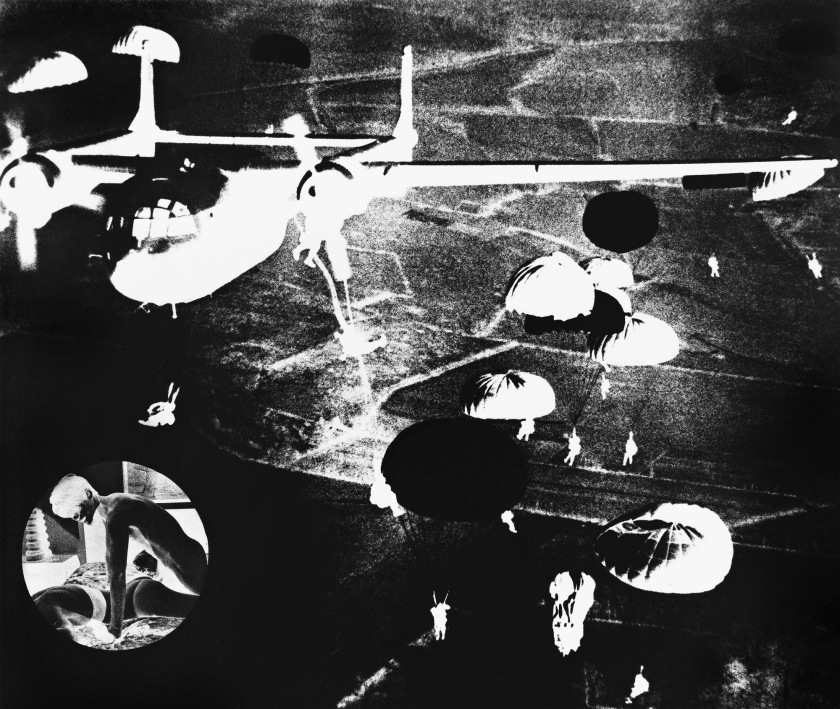
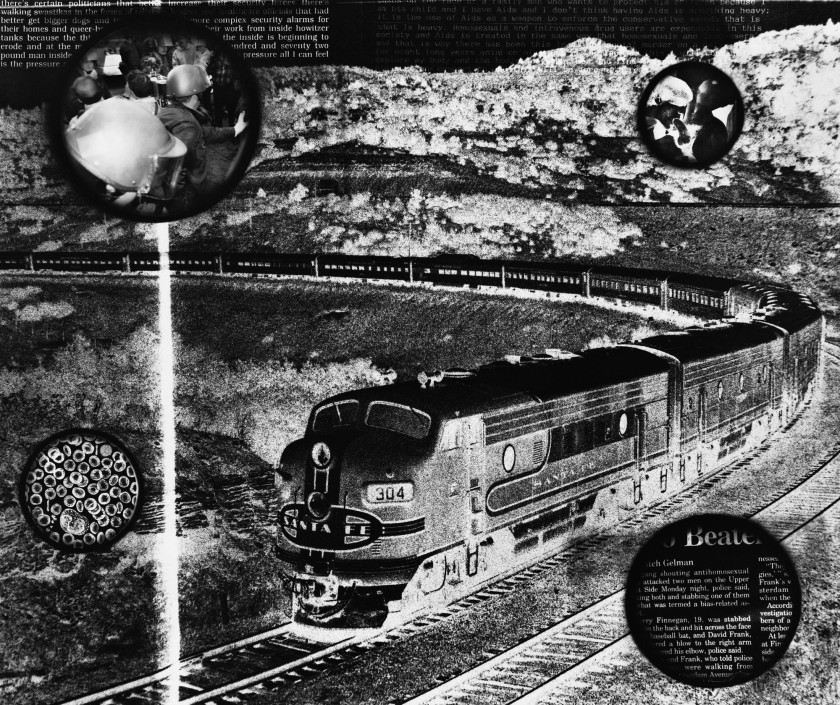
























































































































































































You must be logged in to post a comment.